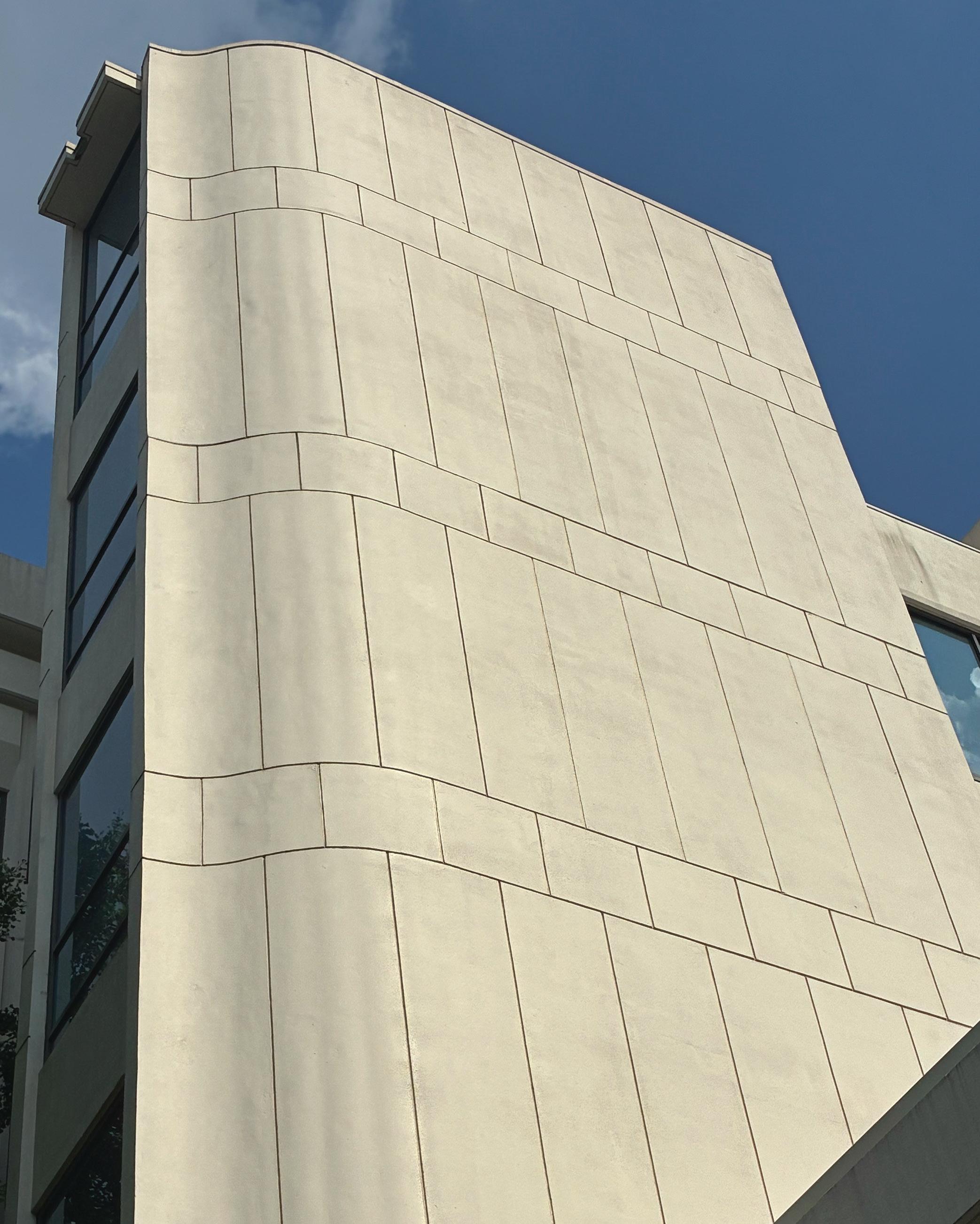

ANNUAL REPORT
JULY 2024 – JUNE 2025
Leadership
Donald R. Webster, Ph.D., P.E.
Karen and John Huff School Chair
Adjo A. Amekudzi-Kennedy, Ph.D.
Frederick Law Olmsted Professor Interim Associate Chair for Administration and Finance
Lauren Stewart, Ph.D., P.E.
Williams Family Professor Associate Chair for Graduate Programs Director, Structural Engineering and Materials Laboratory
Kevin Haas, Ph.D. Associate Chair for Undergraduate Programs
John E. Taylor, Ph.D.
Frederick Law Olmsted Professor Associate Chair for Faculty Development and Research Innovation
Patricia D. White Director of Development patricia.white@ce.gatech.edu P / 404.894.7289
School of Civil and Environmental Engineering at Georgia Tech
790 Atlantic Drive N.W. Atlanta, Georgia 30332-0355 communications@ce.gatech.edu P / 404.894.2201 ce.gatech.edu
Communications Team
Melissa Fralick Communications Manager
Michael Hunter Communications Officer
From the Chair… WELCOME
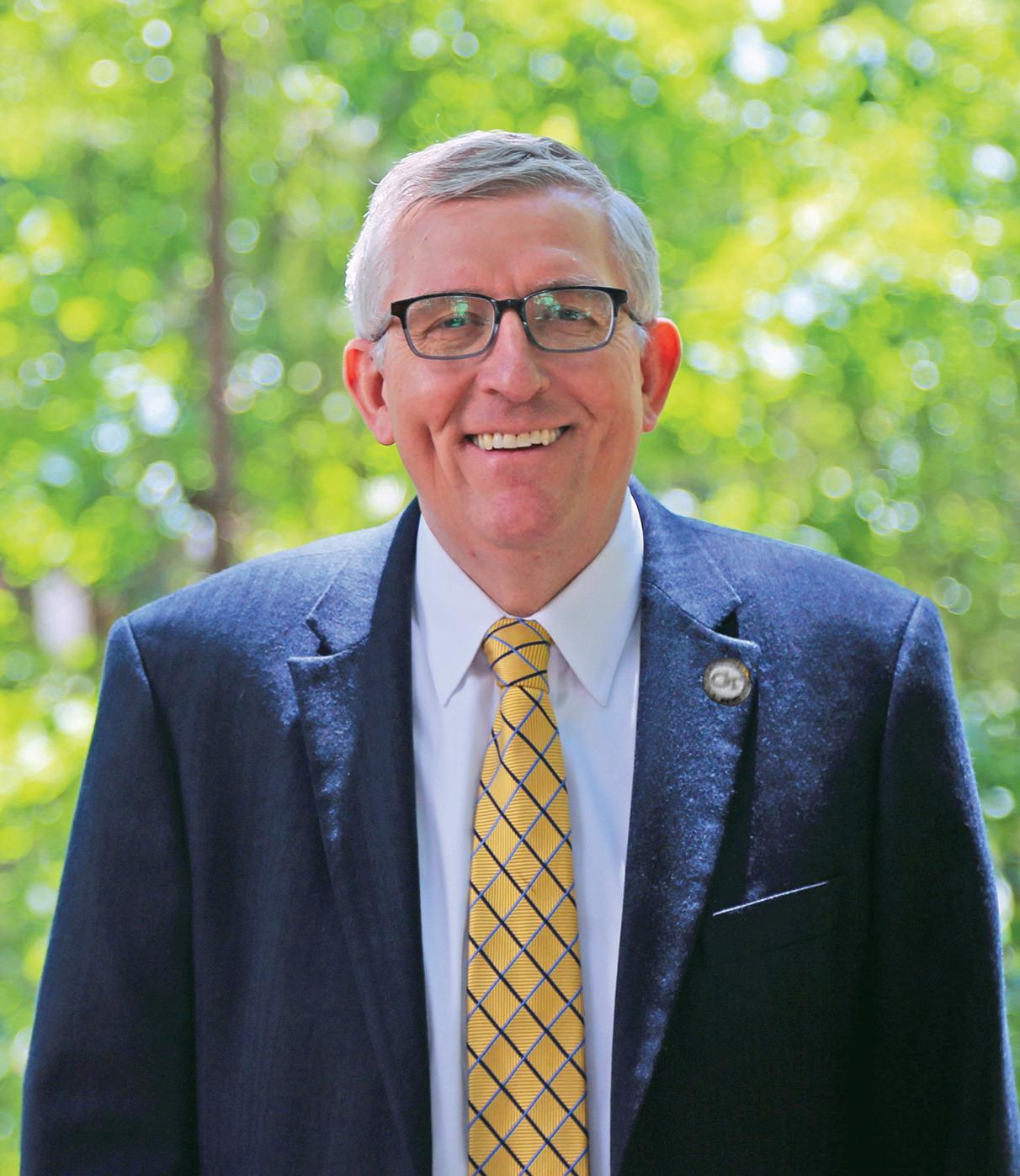
Looking back at the past academic year, I’m pleased with all that we’ve accomplished and the direction we’re charting for the School of Civil and Environmental Engineering.
We’ve been working hard to elevate our curriculum, support our students, and continue to innovate with visionary research.
We were recognized nationally with impressive rankings from U.S. News and World Report. The undergraduate program in civil engineering was ranked No. 1 in the country, and all of our programs were ranked in the top four.
It’s gratifying to receive this recognition for all the work we put in to improve our programs year after year.
In the fall, we introduced a new curriculum that includes a required series of four courses that serve as a “spine” through the undergraduate experience. This was a major update to the curriculum that we are proud to put into action after several years of piloting courses and curriculum development.
The vertically integrated classes, taken in sequence, focus on interactive problem-based learning and professional formation framed around societal grand challenges. We’re especially excited that we will now be able to engage all students in their first semester at Georgia Tech through a broad overview of civil and environmental engineering topics. The goal is to create a sense of belonging to the School, major, and profession and to help students to form their identify as a Civil Engineer or Environmental Engineer.
In this regard, we’re proud of our continued focus to maintain an inclusive academic community where our students, faculty, and staff are supported and valued.
As the cost-of-living continues to rise, especially here in the heart of Atlanta, we recognized the need to increase stipends for graduate students. Our alumni have been enormously generous to create a series of endowments to help financially support this goal. Our current grad students benefit from this effort with improved financial stability, and the new financial resources help us to stay competitive as we work to attract top students to Georgia Tech.
I’m also proud to report that we’ve been recognized as not only a top destination for students, but as a great place to work. The Georgia Society of Professional Engineers honored the School of Civil and Environmental Engineering with its award for Public Sector Employer of the Year.
In the following pages, I hope you’ll enjoy reading highlights from the past year. These achievements would not be possible without the partnership and support of our alumni, industry partners, and friends. Thank you for all you do to help our community thrive!

Don Webster Karen and John Huff School Chair
1
3
Degrees Offered
2
Bachelor's Degrees:
• Civil Engineering
• Environmental Engineering
1
Minor:
2
4
6
Master's Degrees:
• Bioengineering
• Civil Engineering
• Computational Science and Engineering
• Engineering Science and Mechanics
• Environmental Engineering
• Dual Degree - M.S. Civil Engineering & City and Regional Planning
5 2024-2025 Academic Year:
Enrollment: Undergraduates: 615
Graduates: 404
• Global Engineering Leadership Concentrations:
• Construction and Infrastructure Systems
• Geosystems
• Structural, Engineering, Mechanics, and Materials
• Transportation Systems
• Water Resources
6
Doctoral Degrees:
• Bioengineering
• Civil Engineering
• Computational Science and Engineering
• Engineering Science and Mechanics
• Environmental Engineering
• Ocean Science & Engineering
Faculty: Endowed Positions: 26
Total Faculty: 60
Brothers United in Mission to Improve Water
By Melissa Fralick
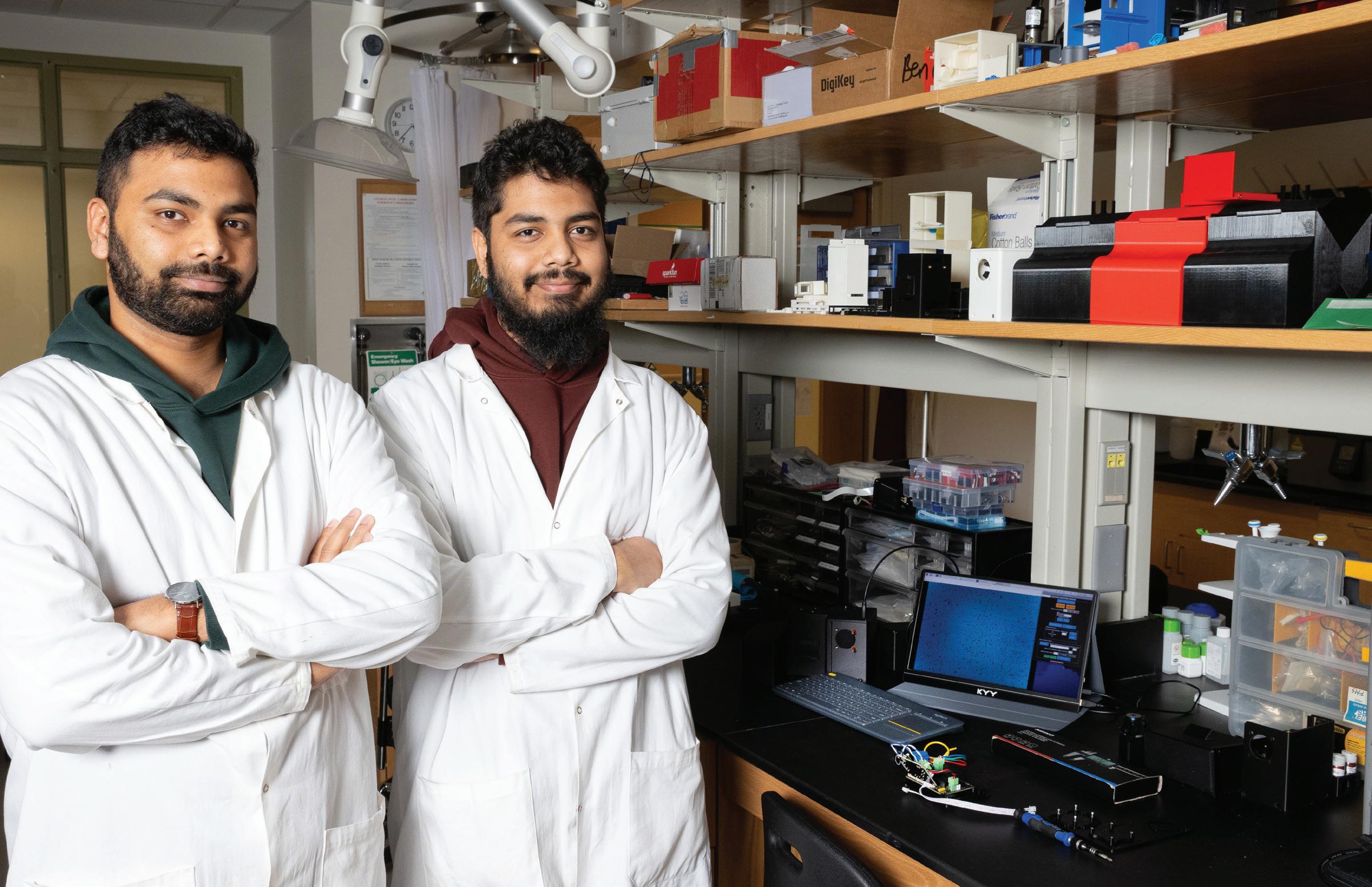

Environmental Engineering graduate students
Farhan Khan and Farshid Khan are passionate about providing access to clean water.
They have a lot in common—starting with the fact that they are brothers. Farhan Khan came to Georgia Tech from Bangladesh to begin his Ph.D. studies in 2021. Farshid Khan followed in 2024, beginning his first semester assisting a doctoral student in the very same lab as his older brother.
“Georgia Tech undoubtedly has one of the best programs in this field,” Farshid Khan said. “Also because of the fact that my brother is here, when I got the admission offer, it was the perfect place to come.”
Their journey to Georgia Tech is deeply rooted in their experience growing up in Bangladesh.
“One of the major problems in Bangladesh is textile effluent pollution,” Farshid Khan said. “It is one of the largest textile exporters in the world. But the problem with the textile industry is they do not treat the water well. All of their effluents come into our rivers and they are highly polluted.
“I always wanted to work on that, and it is still my plan after going back to Bangladesh to work on that.”

One of the major problems in Bangladesh is textile pollution … All of their effluents come into our rivers and they are very highly polluted. I always wanted to work on that, and it is still my plan after going back to Bangladesh to work on that.
—Farshid Khan “ ”
Farhan Khan, left, and his brother Farshid Khan were motivated by water pollution in Bangladesh to pursue graduate education in environmental engineering. (Photo by Candler Hobbs)
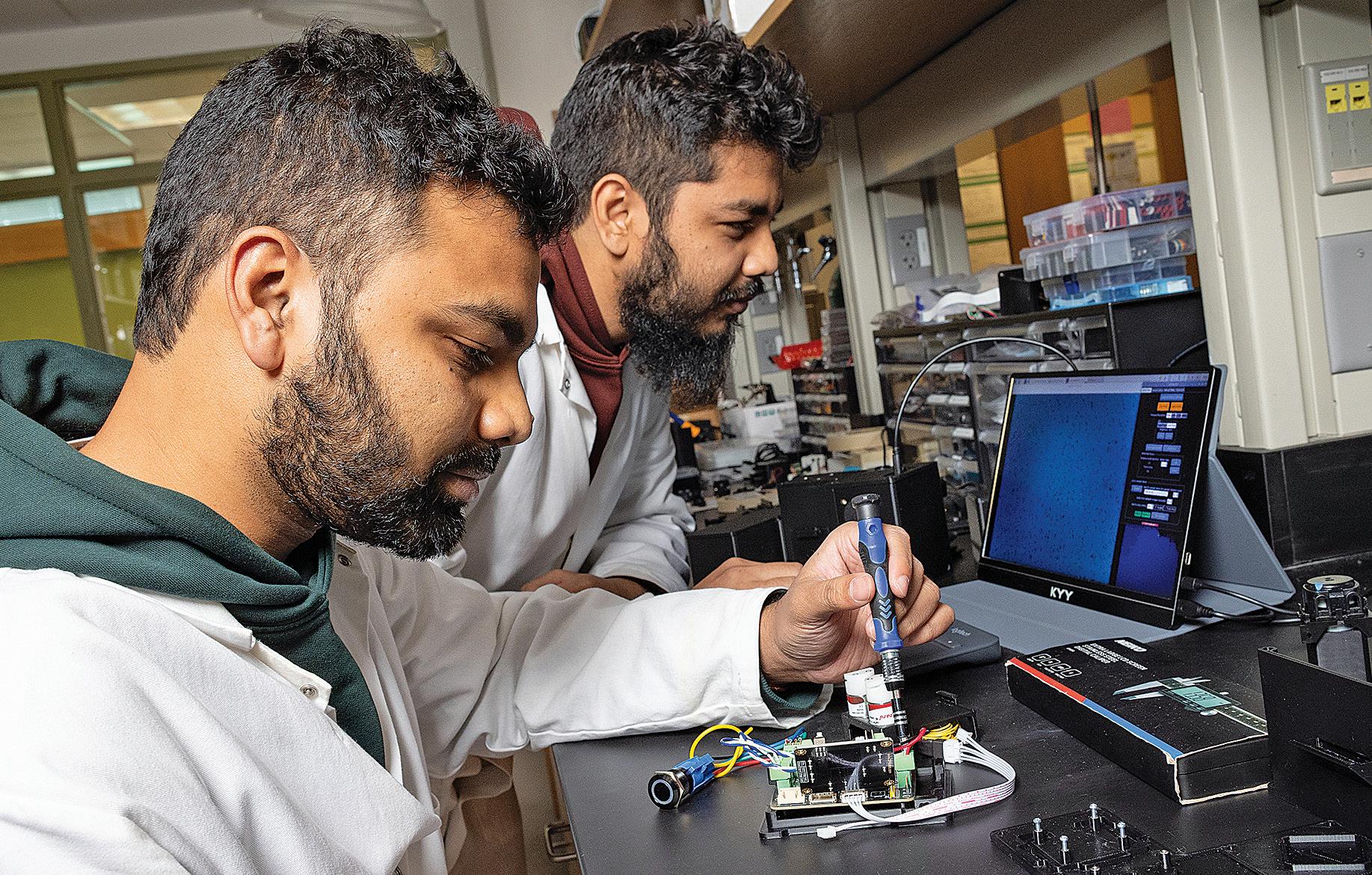
Farhan Khan said his motivation was similar. He became interested in wastewater treatment as an undergraduate student. While working with a reactor, he needed to monitor the system in multiple stages and began thinking of developing an automatic process.
As a graduate student, he’s shifted his focus from wastewater treatment to monitoring. For his Ph.D. thesis, he is developing an automatic flow imaging microscope to make water monitoring technology more affordable and widely available.
Many water utilities monitor their water source by manually gathering samples and testing them to look at microorganisms, toxins, contaminants, and other factors.
The goal of Farhan Khan’s flow imaging device is to automate the process so that the device will take in a water sample by itself, take images of microorganisms, and then quantify and identify the different types of microorganisms within the water sample.
“We are trying to develop a low-cost technology to monitor the environmental system. My vision, my goal was always to make technology more accessible to people,” Farhan Khan said. “That’s what I want to pursue after my graduation so I can have an impact on a larger population.”
Farhan Khan is developing the technology in the lab of his advisor, Carlton S. Wilder Early Career Professor Ameet Pinto.
Pinto said that Farhan Khan has become a very sophisticated researcher during his Ph.D. studies.
“He has really grown as a researcher and as an engineer at the interface of computer science and environmental engineering, and there are not a lot of people in that space,” Pinto said.
Farshid Khan also spent time in Pinto’s lab when he began his master’s studies at Georgia Tech in the fall of 2024.
“My lab does a lot of microbiology and computational

We are trying to develop a low-cost technology to monitor the environmental system. My vision, my goal was always to make the technology more accessible to people.
—Farhan Khan “ ”
biology, and typically students that come in with an environmental engineering or civil engineering undergraduate degree don't have the necessary skill set,” Pinto said. “So when someone comes in and is interested in doing master’s level research, they need an extensive amount of training. So Farshid has learned a few different chemical techniques in the lab, working with one of my doctoral students.”
Farshid Khan is now continuing his studies with his advisor, Carlton S. Wilder Early Career Professor Xing Xie.
While Farshid Khan followed in his older brother’s footsteps, Farhan Khan isn’t the first engineer in the family.
“We have an older sister and she is a computer engineer. So she started this trend and we all followed,” Farshid Khan said.
Outside of the lab, Farhan Khan has enjoyed getting involved in entrepreneurial activities.
In 2022, he was part of a team that won the Higginbotham Entrepreneurship Award at the School of Civil and Environmental Engineering’s second annual Entrepreneurial Impact Competition.
Farhan Khan, along with fellow Ph.D. student Benjamin Gincley, won the competition with PhycoSight, a device to monitor water quality and combat the rapid proliferation of toxin-producing algae.
In 2023, Khan and Gincley were part of a team that was recognized as one of the top four finalists at the AlgaePrize Competition, hosted by the U.S. Department of Energy’s Bioenergy Technologies Office.
“My experience was very fulfilling in this department. Beside my academics and research, I was able to get involved in a lot of things,” Farhan Khan said. “All of these opportunities with the excellent academic and research programs here, it feels like the best place for me to be. And I also wanted my brother to be part of it.” l
Farhan Khan (left) and Farshid Khan (right) in the lab of Associate Professor Ameet Pinto. (Photo by Candler Hobbs)
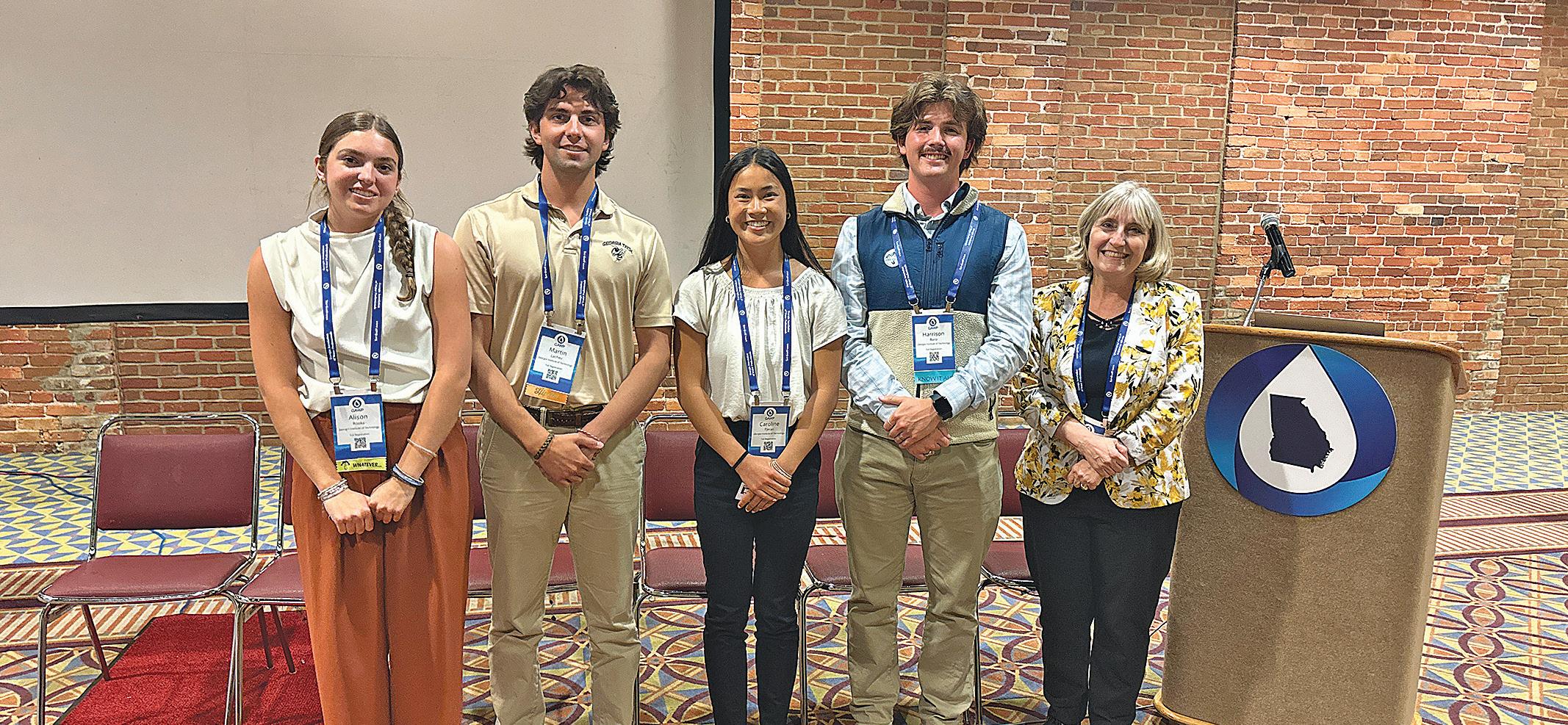
Student Projects Lauded by Georgia Association of Water Professionals
By Melissa Fralick
Two student teams from CEE will represent Georgia in an international competition after taking top billing at the annual Georgia Association of Water Professionals (GAWP) Student Design Competition.
GAWP’s Student Design Competition promotes real-world design experience for students interested in pursuing education and a career in the water and wastewater field. The student teams submit a written report of their project and follow it up with an oral presentation at GAWP’s spring conference.
Six teams from Georgia Tech participated in the competition on April 15 in Columbus, Ga., where they were questioned by a panel of four judges from the water industry.
Environmental capstone teams from Georgia Tech earned first place in the water and wastewater divisions.
They will now advance to the international student design competition held at the annual Water Environment Federation’s Technical Exhibition and Conference (WEFTEC), which is the largest water quality conference in North America.
Harrison Baro, Caroline Fjeran, Martin Lachev, and Alison Rooks presented “Erosion Control and Watershed Improvements at Postal Pond, Decatur, Georgia.”
They won first place overall and first place in the water division, earning a $5,500 travel award to compete at WEFTEC in the fall.
The team was sponsored by the U.S. Army Corps of Engineers to complete a project for the City of Decatur. Postal Pond, located within Legacy Park, has high levels of
sediment accumulation as well as a deteriorated earthen dam. The team designed stream interventions, tracked down unknown sewer connections, and coordinated with park officials regarding the presence of multiple beavers, to provide improvements for Legacy Park.
Aidan Jensen, Earl Harris, Gavin Hurn, and Joshua Guthrie presented “Wastewater Treatment Plant Optimization for EPA Superfund Site: Exide Baton Rouge.”
The team won first place in the wastewater division and second place overall. The students modeled runoff, developed various capping approaches, and designed a new wastewater treatment plant facility from scratch for the resulting various flow scenarios for an EPA Superfund site near Baton Rouge, Louisiana.
A project presented by Natanel Ha on “Leachate Treatability Testing and Wastewater System Design” took third place. The design was prepared by Natanel Ha, Nandika Girish, and Camila Sanchez based on treatability testing conducted as part of a new “Hands-On Treatability” course in the fall. Multiple rounds of treatability tests were conducted by the class to remove Nitrogen, Phosphorus, and Fluorides at the Mississippi Phosphates EPA Superfund site.
“The GAWP SDC is a great opportunity for students to have a chance to present their designs, in front of conference attendees, other students, and a judging panel of practicing engineers,” said Professor of the Practice Sharon Just, who mentored the teams. “Each student was responsible for speaking to present their portion of each project, and all of them did a fantastic job. Working with such talented students is a wonderful experience.” l
Alison Rooks, Martin Lachev, Caroline Fjeran, and Harrison Baro pose with Professor of the Practice Sharon Just.
(Photo courtesy Sharon Just)
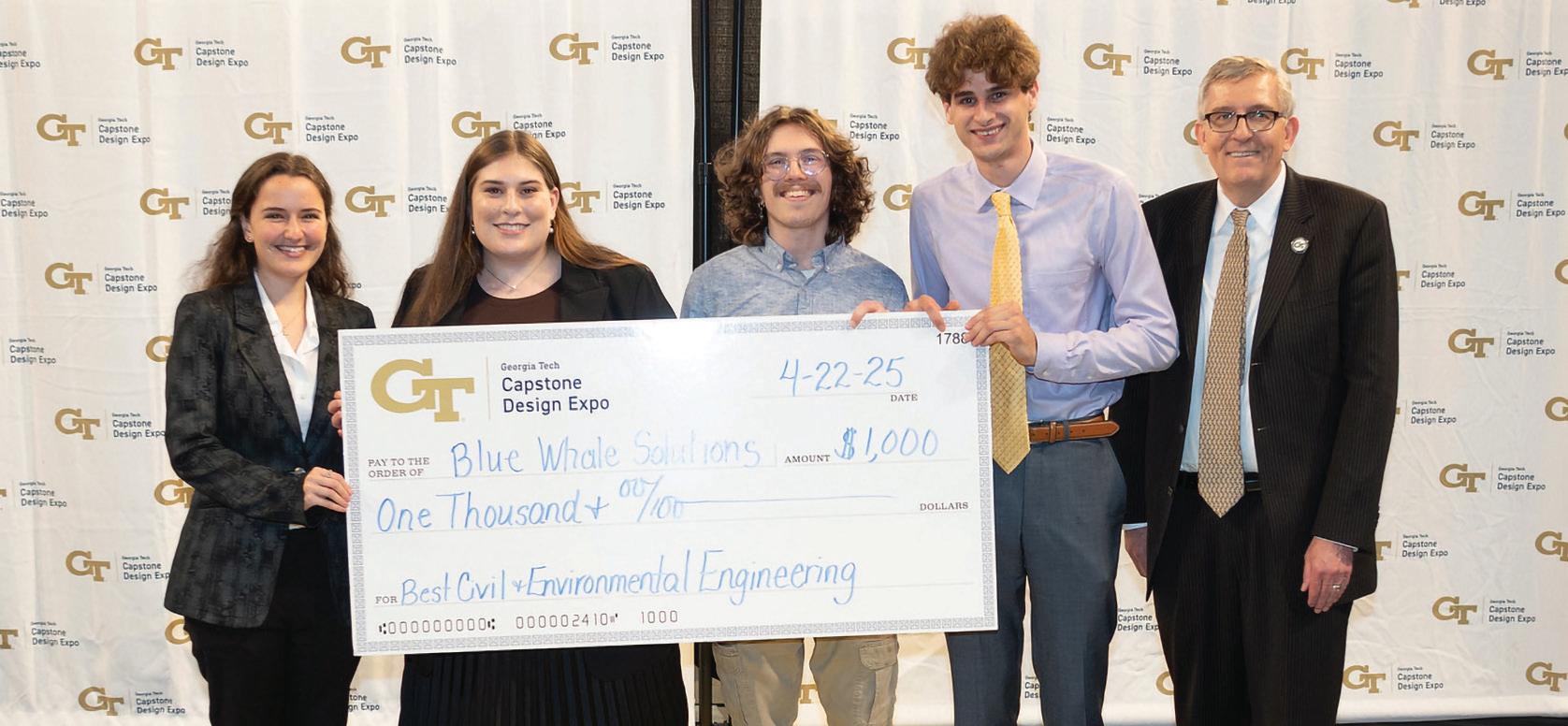
CEE Students Showcase Innovation at Capstone Design Expo
By Melissa Fralick
The Blue Whale Solutions team took home the prize for the best civil and environmental engineering project at the Spring 2025 Capstone Design Expo.
The CEE students won $1,000 for their project, soil vapor extraction for the Velsicol Chemical Corp. (Hardeman County) Superfund Site.
Blue Whale Solutions was one of four civil and environmental engineering teams to compete at the Spring 2025 Capstone Design Expo, held on April 22 at McCamish Pavilion. The teams’ projects ranged from environmental remediation to pedestrian bridge design to dam restoration and sustainable construction.
They were among a record 238 teams of more than 1,300 students that showed off their semester-long projects, which serve as a culmination of their undergraduate studies. The teams, representing four of Georgia Tech’s colleges, competed for more than $15,000 in prize money.
Blue Whale Solutions is comprised of civil engineering major William Caldwell and environmental engineering majors Rebecca Chapman, Hudson McGaughey, and Melanie Reveron.
The students were advised by Professor of the Practice Sharon Just. The project was sponsored by Ramboll and the U.S. Environmental Protection Agency (EPA).
The Velsicol Chemical Corp. Superfund Site is a site on the EPA’s National Priority List. Between 1964 and 1973, the Velsicol Chemical Corp. operated a landfill on the site where around 200,000 drums of pesticide manufacturing waste were disposed in trenches. As a
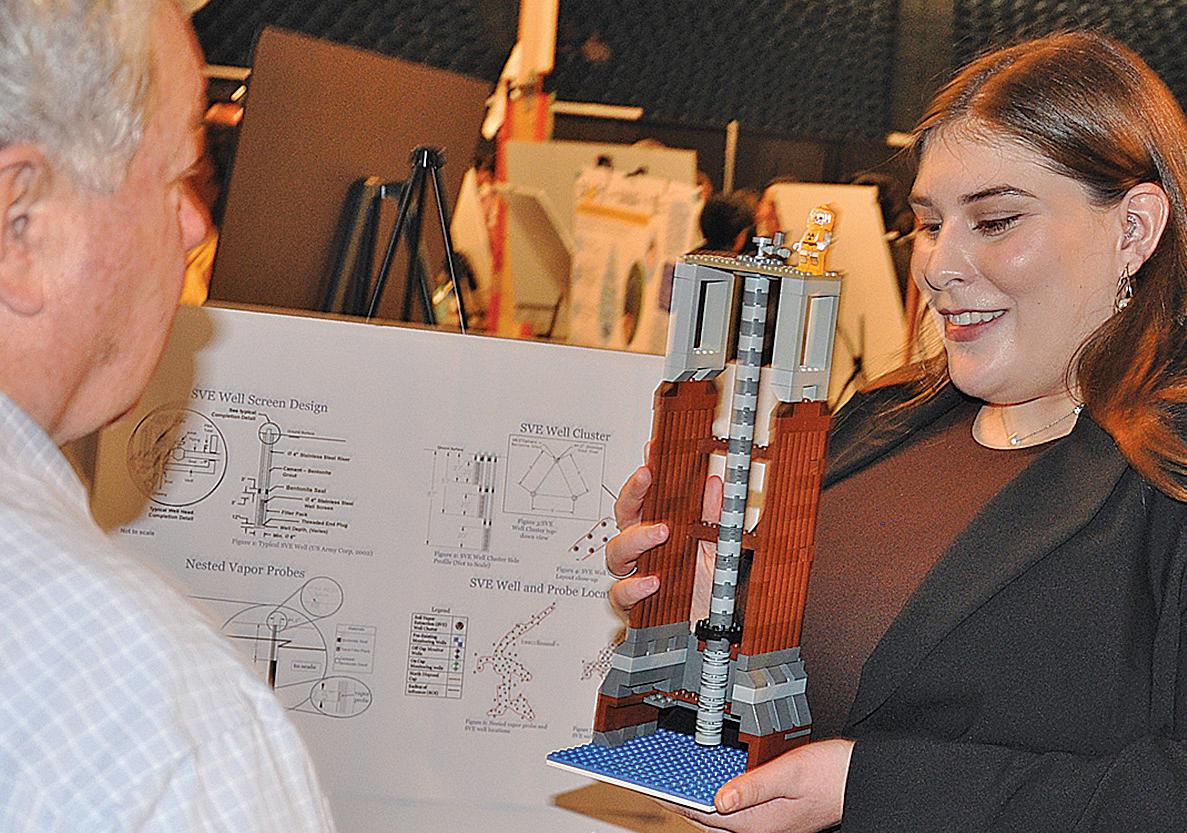
result, there are around 10 million pounds of chlorinated volatile organic carbons (cVOCs) on the site.
The Blue Whale Solutions team designed a soil vapor extraction system for the largest disposal area on the site. They are preparing a well field layout, both vertically and horizontally, and a treatment system conceptual design. The design includes components, flow, and estimated treatment duration with the remediation goal of reducing the cVOC concentrations by 97%.
The Blue Whale Solutions team (L to R: Melanie Reveron, Rebecca Chapman, Hudson McGaughey and Will Campbell) holding the big check prize with Karen and John Huff School Chair Don Webster. (Photo by Candler Hobbs)
Rebecca Chapman shows a model of the soil vapor extraction system to a Capstone visitor. (Photo by Michael Hunter)
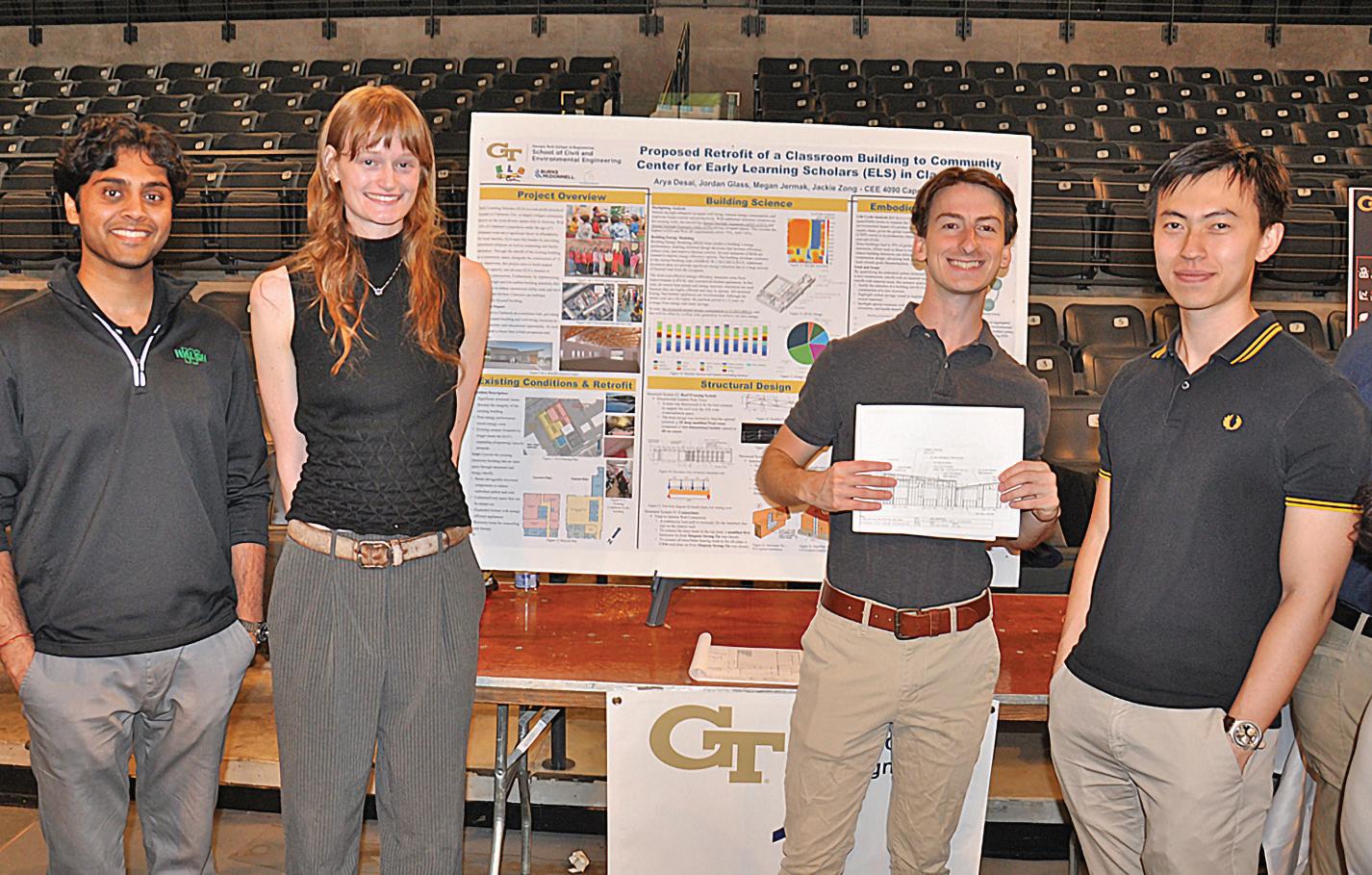

Just, the team’s advisor, applauded the students for overcoming the challenge of having their site visit canceled due to unexpectedly high levels of organic contaminant encountered at the site during drilling.
“Despite these challenges, the team came together to design all major components for the extraction and treatment system, providing a long-term solution that will not only treat the vadose zone but thereby also reduce contaminant levels in the groundwater,” she said.
The Solar Decathlon team, made up of civil engineering majors Arya Desai, Jordan Glass, Megan Jermak, and Jackie Zong, showcased a plan to expand the Early Learning Scholars daycare center in Clarkston, Ga. The team prioritized sustainability and energy efficiency in their design choices for the facility, which serves as a resource for refugee families in the Clarkston community.
The project includes a retrofit of an existing building to add an open event space and the addition of new classroom buildings to expand their current layout. The project includes structural engineering design of the retrofitted timber-frame building, energy and daylight modeling of all new buildings, life cycle assessment of all materials and structures, construction scheduling, and cost estimation.
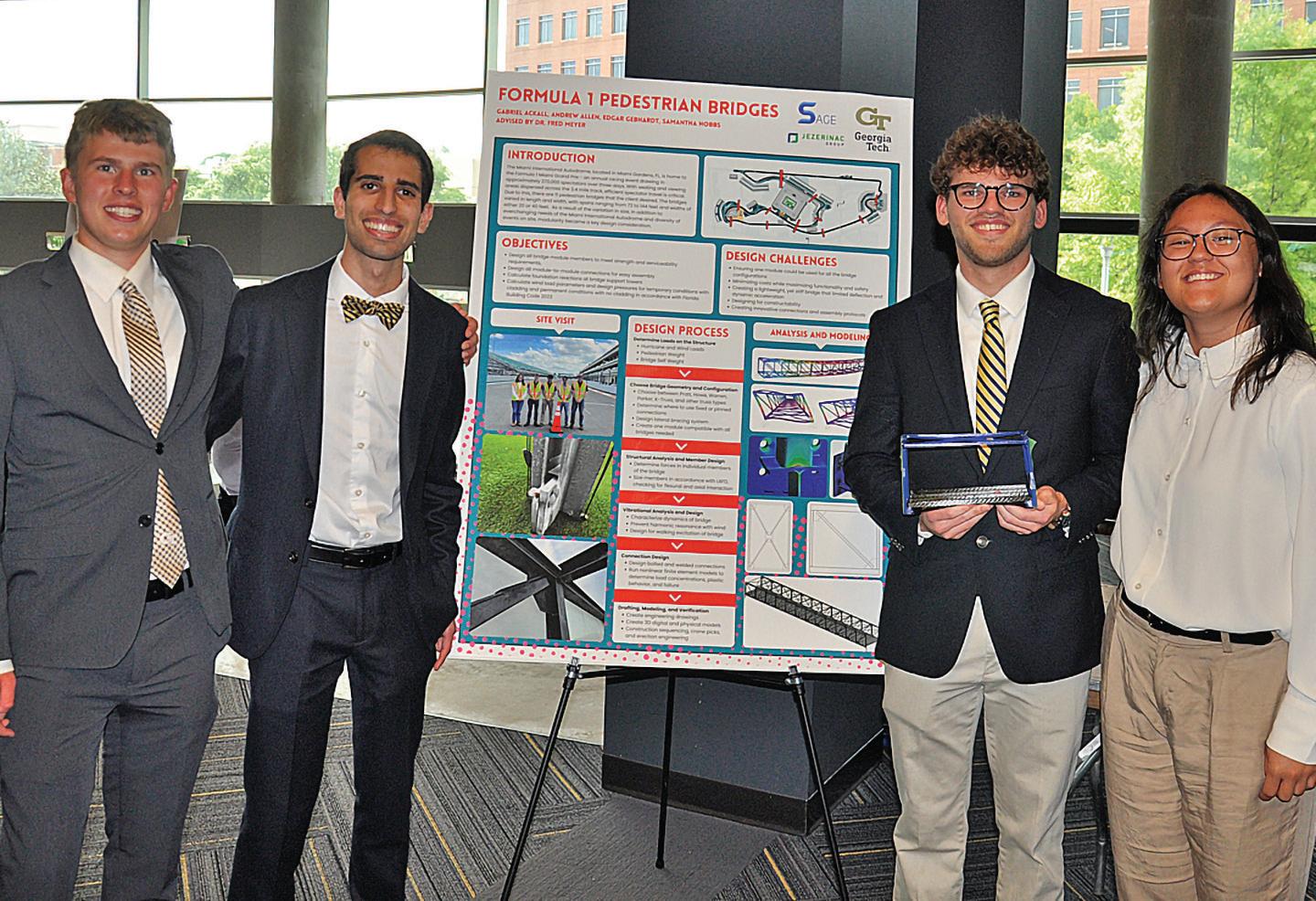
The project was sponsored by Burns & McDonnell and the students were advised by Professor of the Practice Fred Meyer.
The MACH 4 Civil Design Solutions team’s project featured improvements to Postal Pond at Legacy Park in Decatur, Ga. Postal Pond, located within Legacy Park, is experiencing high levels of sediment accumulation as well as a deteriorated earthen dam. The team worked to evaluate the risk associated with the deteriorated dam, develop a solution to restore the dam functionality and safety, and determine the cause of sedimentation within the pond to prevent further accumulation.
The goal of the project is to ensure the safety of communities located within the inundation zone of the pond.
The team, which was advised by Professor of the Practice Sharon Just, includes environmental engineering students Harrison Baro and Alison Rooks along with civil engineering students Caroline Fjeran and Martin Lachev.
The project was sponsored by the U.S. Army Corps of Engineers.
SAGE Structural—the team of civil engineering students Gabriel Ackall, Andrew Allen, Edgar Gebhardt, and Samantha Hobbs—presented their project focused on the design, analysis, and erection sequencing of 11 pedestrian bridges for the Miami International Autodrome Formula 1 Track.
The goal of this project is to increase connectivity for spectators on race days. The bridges are modular to allow for easy construction and deconstruction. These bridges are designed to allow for the bridge spans and locations to be changed in the future as the needs of the Miami International Autodrome evolve.
The students were advised by Professor of the Practice Fred Meyer and the project was sponsored by Jezerinac Group. l
SAGE Structural (L to R: Edgar Gebhardt, Gabriel Ackall, Andrew Allen, and Samantha Hobbs) with their project Formula 1 Pedestrian Bridges. (All photos by Michael Hunter)
Solar Decathlon (L to R: Arya Desai, Megan Jermak, Jordan Glass, and Jackie Zong) and their Early Learning Scholars expansion project.
MACH 4 Civil Design Solutions (L to R: Caroline Fjeran, Alison Rooks, Harrison Baro and Martin Lachev) in front of their Postal Pond at Legacy Park project.
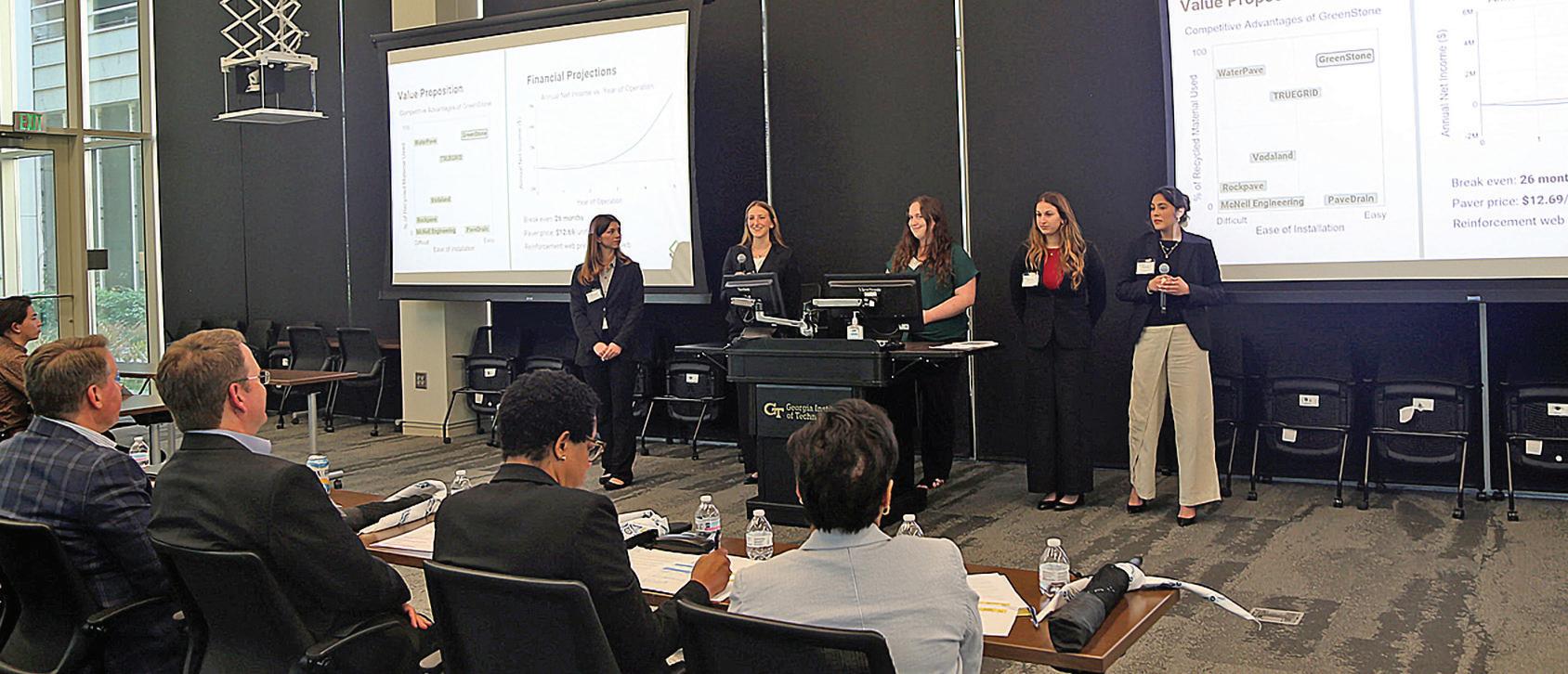
Student Inventors Win Big at Fifth Annual Entrepreneurial Impact Competition
By Michael Hunter
F our teams of student innovators vied for two $5,000 prizes in the School of Civil and Environmental Engineering’s fifth annual Entrepreneurial Impact Competition on April 9.
Students were invited at the beginning of the spring semester to submit entrepreneurial ideas that would improve the human condition. The four finalists were selected by judges from a field of more than a dozen applicants.
Two teams prevailed with concepts for an anti-microbial surface to eliminate bacteria in humidifiers and a permeable paving system created from recycled construction materials.
Each of the four teams had five minutes to explain their concept in front of an audience and then field 10 minutes of in-depth questioning from the panel of judges. After the presentations, the judges deliberated and selected the winner of the two awards. The Higginbotham Entrepreneurship Award recognizes a more developed project, which is closer to being launched in the marketplace. The Zeitlin Innovation Award recognizes creativity in a project at any stage of its development.
GreenStone, the team comprised of Caroline Tucker, Camilla Roldan, Clara Hawkins, Madilyn Jacoby, and Kaylee Jordan, won the Higginbotham Entrepreneurial Award for their permeable paving system.
The GreenStone Permeable Paving System, consisting of GreenPAVE tiles and the GreenGRID reinforcement web, addresses two critical environmental challenges: stormwater management and construction waste.
The GreenPAVE tiles are made of 75% recycled construction waste and the GreenGRID web is made from 100% recycled HDPE material, which facilitates easy and uniform installation.
Team captain Caroline Tucker explained that the group shared “a passion for sustainable infrastructure and its place in our rapidly changing world.” GreenStone’s mission is “to develop innovative, sustainable stormwater solutions that transform construction waste into resilient infrastructure, reducing carbon emissions and enhancing the built environment,” she said.
Team member Clara Hawkins said that Greenstone would stand out in the market for two reasons: ease of installation, making the product more accessible to homeowners and contractors; and sustainability, leading the industry in the usage of eco-conscious materials. Hawkins noted that climate change is increasing the demand for permeable paving, with the market reaching $3.3 billion in 2024.
“Looking at our financial projections, we show strong growth, reaching profitability in just 26 months,” she said, predicting the company could reach $5 million in sales in year five.
Biofilm Killer, the team of FeiFei Liu and Shuai Wang, won the 2025 Zeitlin Innovation Award.
The team’s product is a novel electrophysical antimicrobial surface to deal with surface microbial contamination in humidifiers.
Biofilm Killer’s solution uses micro-interdigitated electrodes (MIDEs) to prevent bacterial attachment with intensive electric field strength. The team believes that integration of this effective antimicrobial surface into humidifiers can provide a bacteria-free solution and provide consumers with a better quality of life.
Continues on next page
The panel of judges listen to students from the GreenStone team pitch their product at the Entrepreneurial Impact Competition on April 9.
(Photo by Melissa Fralick)
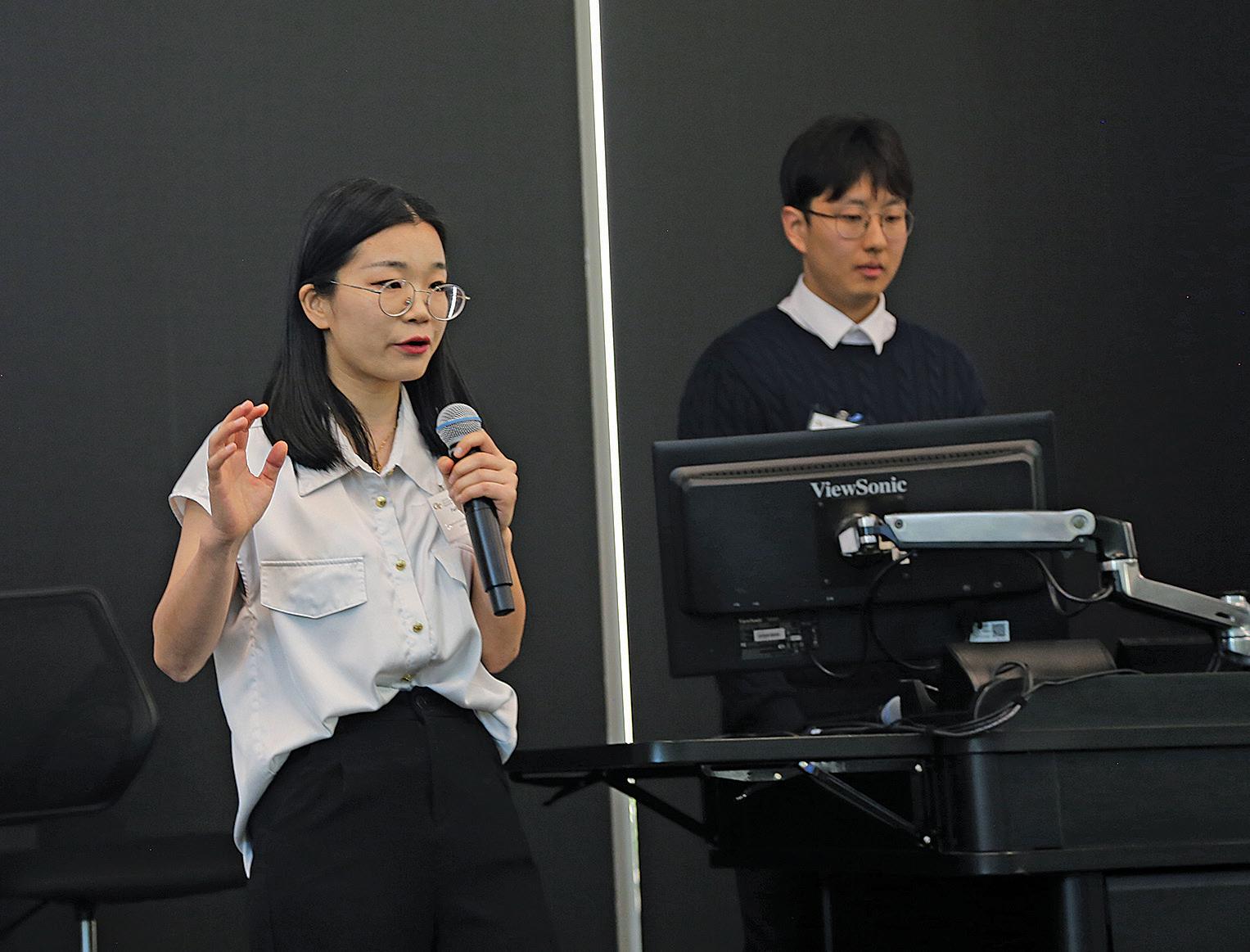
Team captain Liu asked the audience for a show of hands: First, how many people own a humidifier? Next, how many people clean their humidifiers once a week? Most people lowered their hands after the second question, illustrating the problem that Biofilm Killer aims to address. She explained that the usage of humidifiers is on the rise in homes and healthcare systems around the world. However, humidifiers create an environment that promotes bacterial growth, allowing bacteria to spread through aerosols. Inhaling bacteria could lead to a condition known as “humidifier lung.”
Liu explained that their process, which is patent pending and has received a $25,000 Tech Ready Grant, is superior to disinfectants for three reasons:
1. It provides greater surface and anti-microbial efficiency,
2. It doesn’t utilize any harmful chemicals that can be inhaled, and
3. It is energy efficient because a one-time treatment can insure surface hygiene in the humidifier for a long time.
She also said the team is looking to apply the technology to other high-touch surfaces like doorknobs.
Liu concluded by noting Biofilm Killer is not only important for the 20% of U.S. and Canadian households that use
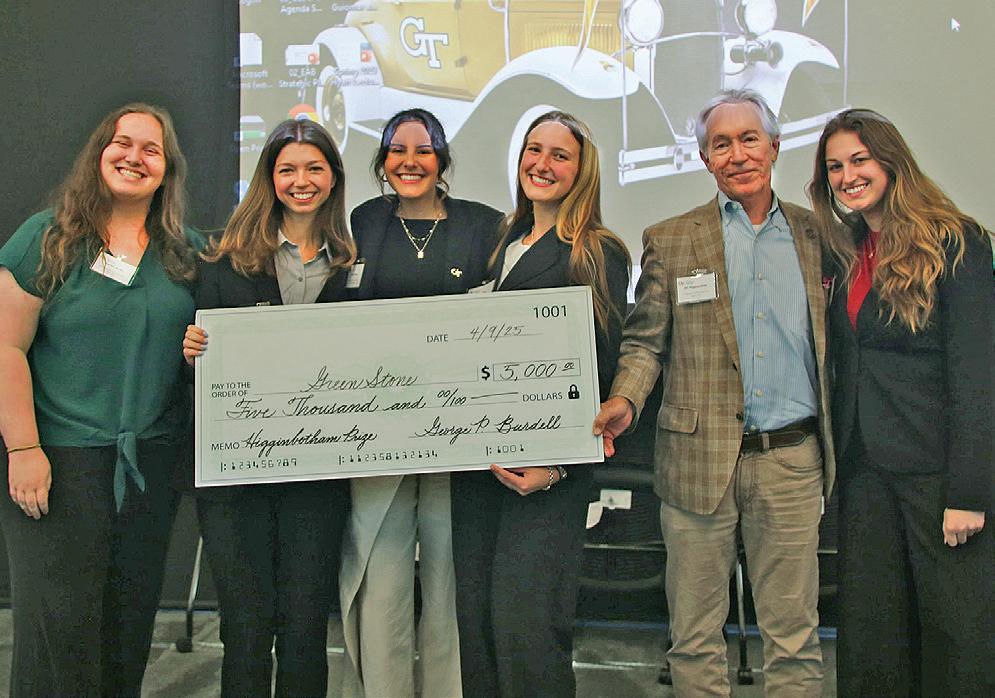
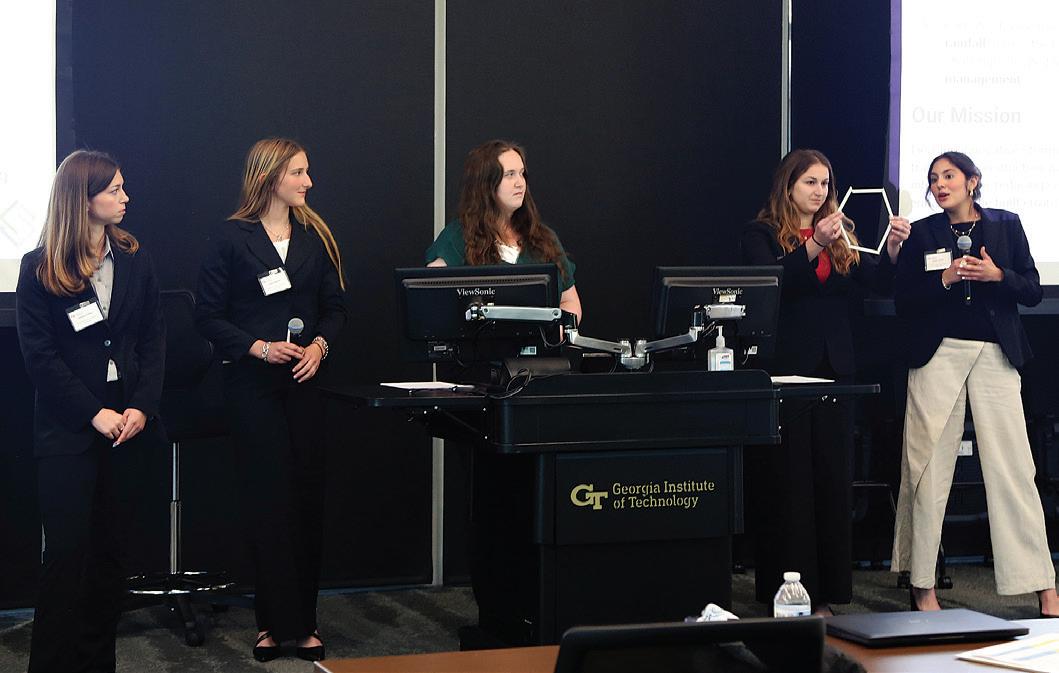
humidifiers. “It’s also important for those 2.8 billion people who don’t have safely managed sanitation, and also 1.9 billion people who don’t have basic hand hygiene facilities.
“This can help us to achieve the United Nations Sustainable Development Goal 6, which is global sanitation,” she said.
The team of judges, comprised of CEE faculty and notable alumni who are business owners or experts in their field, were impressed by all the competitors.
“It was very difficult to choose a winner with excellent presentations being given by all the teams,” said Chris Martin, director of CEE’s Center for Collaborative Innovation and one of the judges for the event. “All of the finalists demonstrated a combination of intelligence and tenacity that merits recognition.”
The Entrepreneurial Impact Competition was established in 2021 to encourage a spirit of entrepreneurship in CEE students. The idea was led by Bill Higginbotham, CE 76, a serial entrepreneur and instructor who teaches Innovation and Entrepreneurship in CEE Systems. He endowed the Higginbotham Entrepreneurship Award and Greg Zeitlin established the Zetilin Innovation Award in honor of his parents, Phyllis C. And Alan G. Zeitlin, CE 62. l
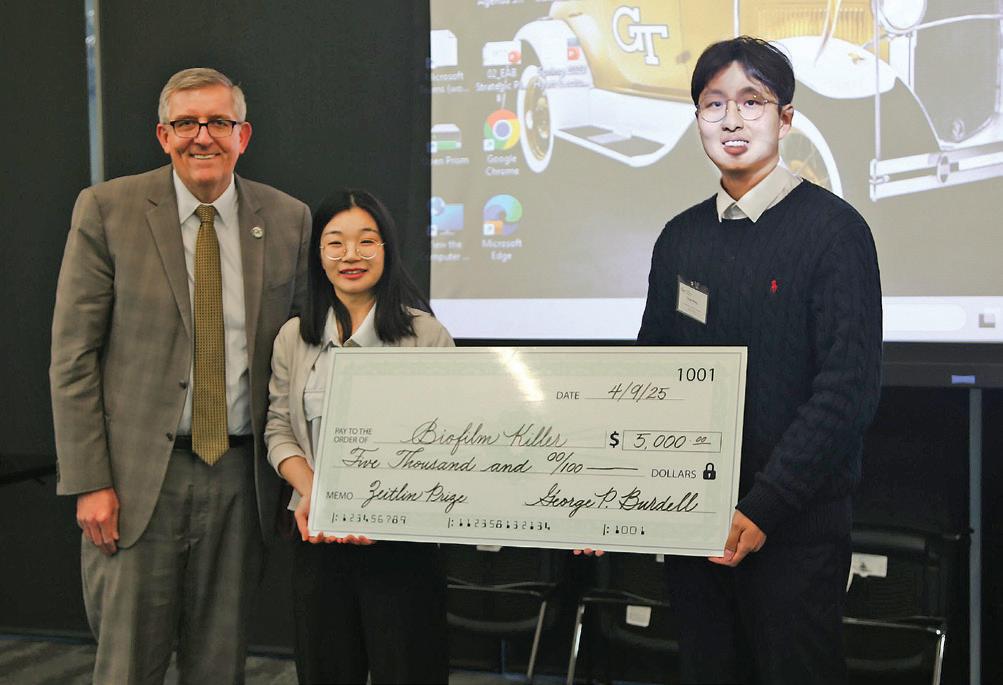
Team GreenStone demonstrating the GreenGrid that makes installing the GreenPAVE tiles uniform and easy. (Photo by Melissa Fralick)
Biofilm Killer team captain FeiFei Liu addresses the audience at the 2025 Entrepreneurial Innovation Competition. (Photo by Melissa Fralick)
Team GreenStone, left to right: Madilyn Jacoby, Caroline Tucker, Camilla Roldan, Clara Hawkins, and Kaylee Jordan pose with Bill Higginbotham, CE 76, after winning the Higginbotham Entrepreneurship Award.
Biofilm Killer, FeiFei Liu and Shuai Wang, accept the 2025 Zeitlin Innovation Award from Karen and John Huff Chair Don Webster. (Photos by Melissa Fralick)
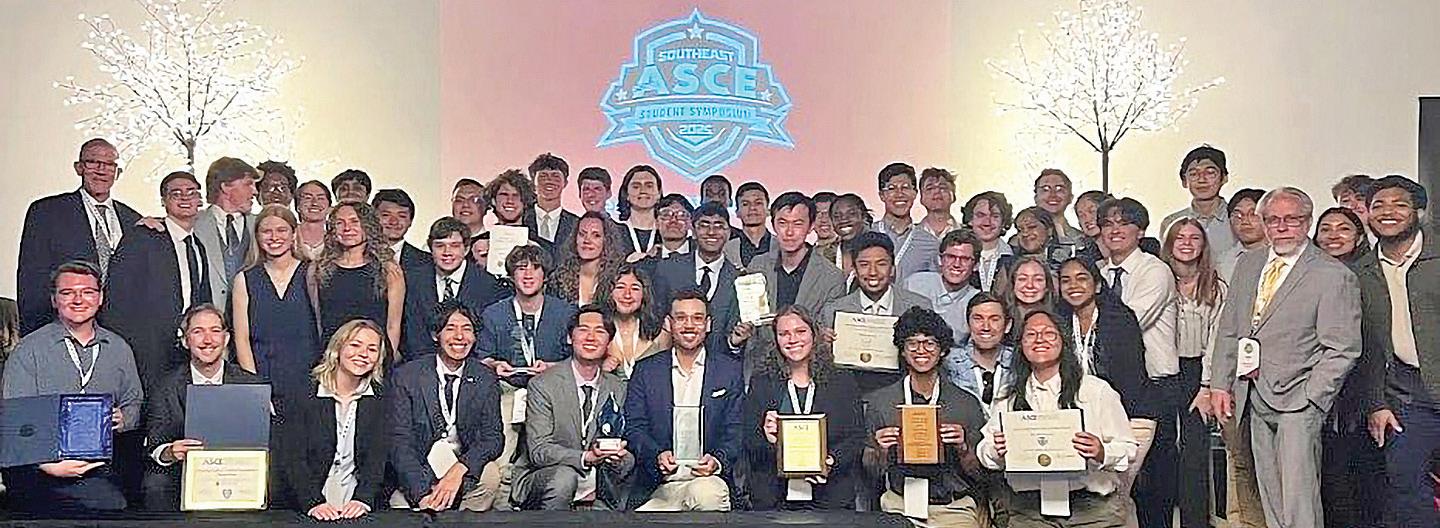
GT Chapter of ASCE finishes 2nd Overall at Regional Student Symposium
By Michael Hunter
The Georgia Tech chapter of the American Society of Civil Engineers (ASCE) was ranked No. 2 out of 19 teams at the 2025 ASCE Student Symposium.
The Symposium, held March 6-8 at the University of Georgia, brought students from universities around the Southeast together to compete in a variety of civil engineering-related events.
The Georgia Tech chapter finished second in the overall rankings after competing in 15 events, according to conference chair David Sparks. Sparks noted that the team finished in the top three in nine of the 18 competitions and in the top five for 13 of the 18 events.
“I’m very proud of the impressive performance of our student chapter this year. All 61 students and the three faculty who attended contributed to these amazing results,” Sparks said. “This is the third year in a row where we have seen an improvement in our overall ranking, so we are looking forward to continuing this upward trend next year.”
The chapter also continued its dominance in the Sustainable Solutions competition for the third year running. The Sustainable Solutions Competition challenges students to address real-world issues with creative engineering solutions.
In this year’s competition, the fictional “City of ASCE” formed a public-private partnership to acquire a parcel with a fivestory commercial office building for mixed-use redevelopment. The teams were required to use the Institute for Sustainable Infrastructure’s Envision framework to achieve sustainability goals.
The GT-ASCE entry, “Blossom Borough,” won first place, the third year in a row for the Georgia Tech team. The team advanced to the ASCE Civil Engineering Student Championships at California Polytechnic State University, where they also won first prize in 2023 and 2024.
Faculty advisor and Professor of the Practice Fred Meyer praised the efforts of the Mini Prestressed Beam team, whose team captain had to withdraw due to an injury the week before the competition. Assistant team captain Ty Vasquez, assisted by Shreya Jayaram and Abel Yarad, stepped in to lead the team to a second-place finish in the event.
“Our CEE students were wonderful ambassadors of Georgia Tech through the entire symposium,” Meyer said. “Many teams overcame tremendous challenges finishing consistently strong to bring home Second Place Overall in a challenging field of 19 schools.”
Here are the results from the events in which GT-ASCE placed in the top three:
First Place:
l Sustainable Solutions, led by Phoebe Ellis
Second Place:
l Surveying, led by Samantha Hobbs
l Prestressed Mini Beam, led by Gabriel Ackall
l Student Symposium Paper, delivered by Fidan Savalan
l T-shirt Design, led by Peter Grafstein
l Mystery Event, led by Jackie Zong and Krish Gupta
Third Place:
l Timber Strong, led by Andy Lainez
l Muddy Waters, led by Tyler Rhine
l Concrete Cornhole, led by Teddy Lemire l
Members and faculty advisors of GT-ASCE pose with their awards at the final ceremony of the 2025 Southeastern ASCE Student Symposium at the University of Georgia. (Photo: GT-ASCE)
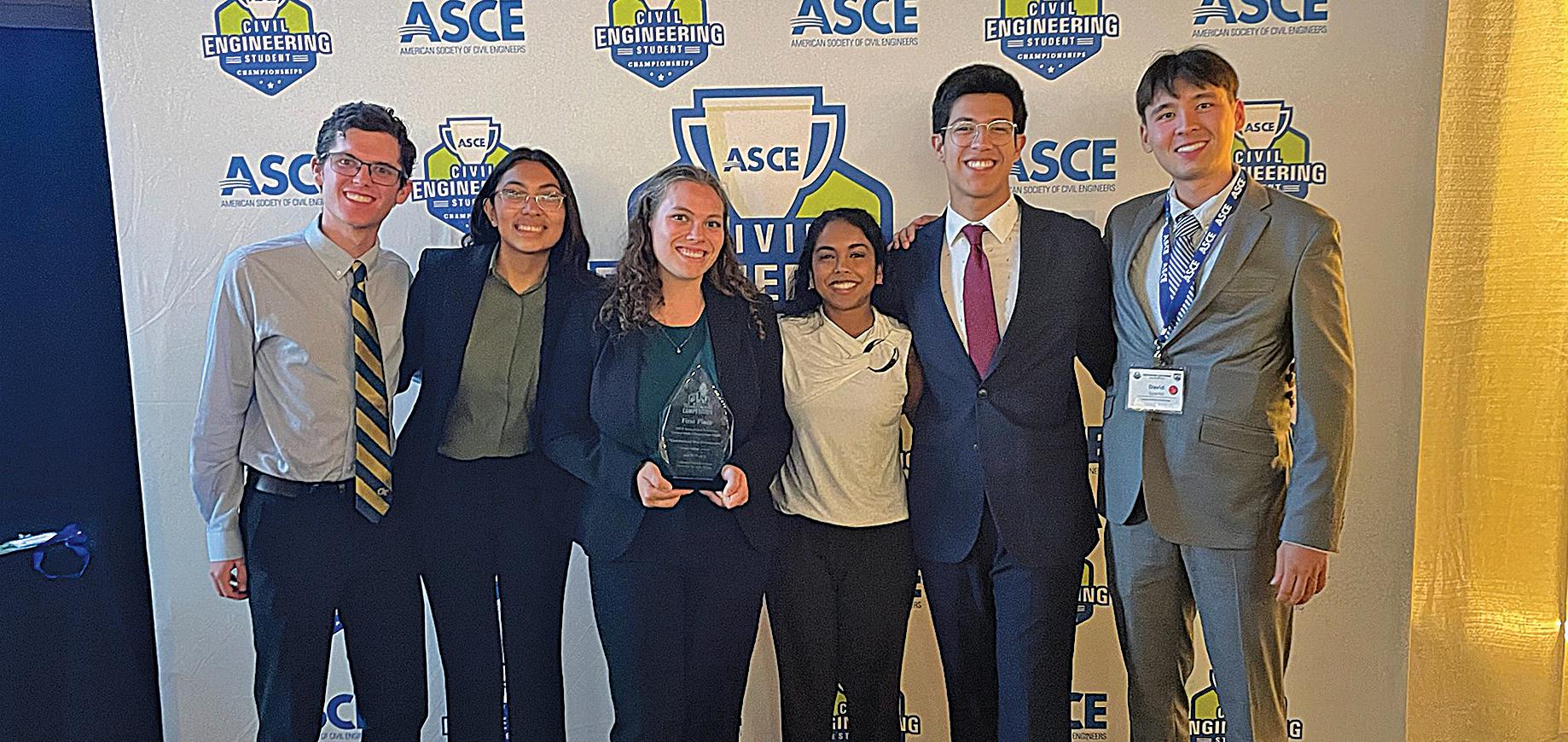
Sustainable Solutions Team Wins National Competition for Third Year in a Row
By Michael Hunter
Georgia Tech has won first place at the American Society of Civil Engineers (ASCE) Sustainable Solutions Competition.
The 18-member team, led by captain Phoebe Ellis, overcame competition from 22 teams from the United States, India and China to defend their title at the ASCE Civil Engineering Student Championships at California Polytechnic State University, San Luis Obispo June 27-29.
“Winning this national competition three years in a row is an incredible feat,” said School Chair Don Webster. “I’m proud of our students’ hard work and how well they represent Georgia Tech’s emphasis on sustainability.”
The Sustainable Solutions Competition challenges students to develop a strong understanding of sustainability and to incorporate sustainability into everyday engineering problems in creative ways.
“I think the thing that made us so successful was how our team has a mix of older members with lots of technical knowledge and experience as well as new members with new ideas and excitement,” said Ellis, a third-year civil engineering major. “It really allowed us to succeed and create a wellthought out and unique site.”
For this year’s competition, teams were tasked with a commercial site conversion: revitalizing an old office building and the surrounding area with specific attention to power supply, sanitation and recycling, traffic and transportation, and stormwater management.
The team’s winning proposal, Blossom Borough, proposed commercial conversion of the site into a community “where citizens can flower and flourish.” According to Ellis, the team took inspiration from local Atlanta projects like the Kendeda Building, Peter’s Parking Deck, Rodney Cook Sr. Park, and the Mercedes Benz Stadium.
At the ASCE Civil Engineering Student Championships, each of the competing teams’ projects was a regional winner, so the competition was stiff.
Key design elements that Ellis feels helped Georgia Tech’s project stand out were “daylighting” a creek—opening up and restoring a previously buried watercourse— and emphasizing multimodality with new facilities, expanded bus routes, and safety features throughout the site.
“The creek was not only a focal point of our site, it also rehabilitated the impaired creek and mitigates stormwater in extreme weather events,” Ellis said.
The team also emphasized stakeholder engagement by including fun elements in the design such as a zero-waste grocery store, an amphitheater, a rotating restaurant, community gardens and a multi-sport court on the parking deck.
“I continue to be impressed by our Georgia Tech students,” said Professor of the Practice Fred Meyer, who advised the team. “Their hard work, creativity, and teamwork truly stood out and set a high standard earning them the victory and inspiring others along the way.” l
Nate Miller, Nayzet Pena, Phoebe Ellis, Sowmithra Muthulakshmi Prakash, Joaquin Meugniot-Valencia and David Sparks pose with their 1st Place award at the ASCE Student Championship at Cal Poly in San Luis Obispo. (Photo courtesy GT-ASCE)
Geomatics Class Utilizing New State-of-the-Art Surveying Equipment
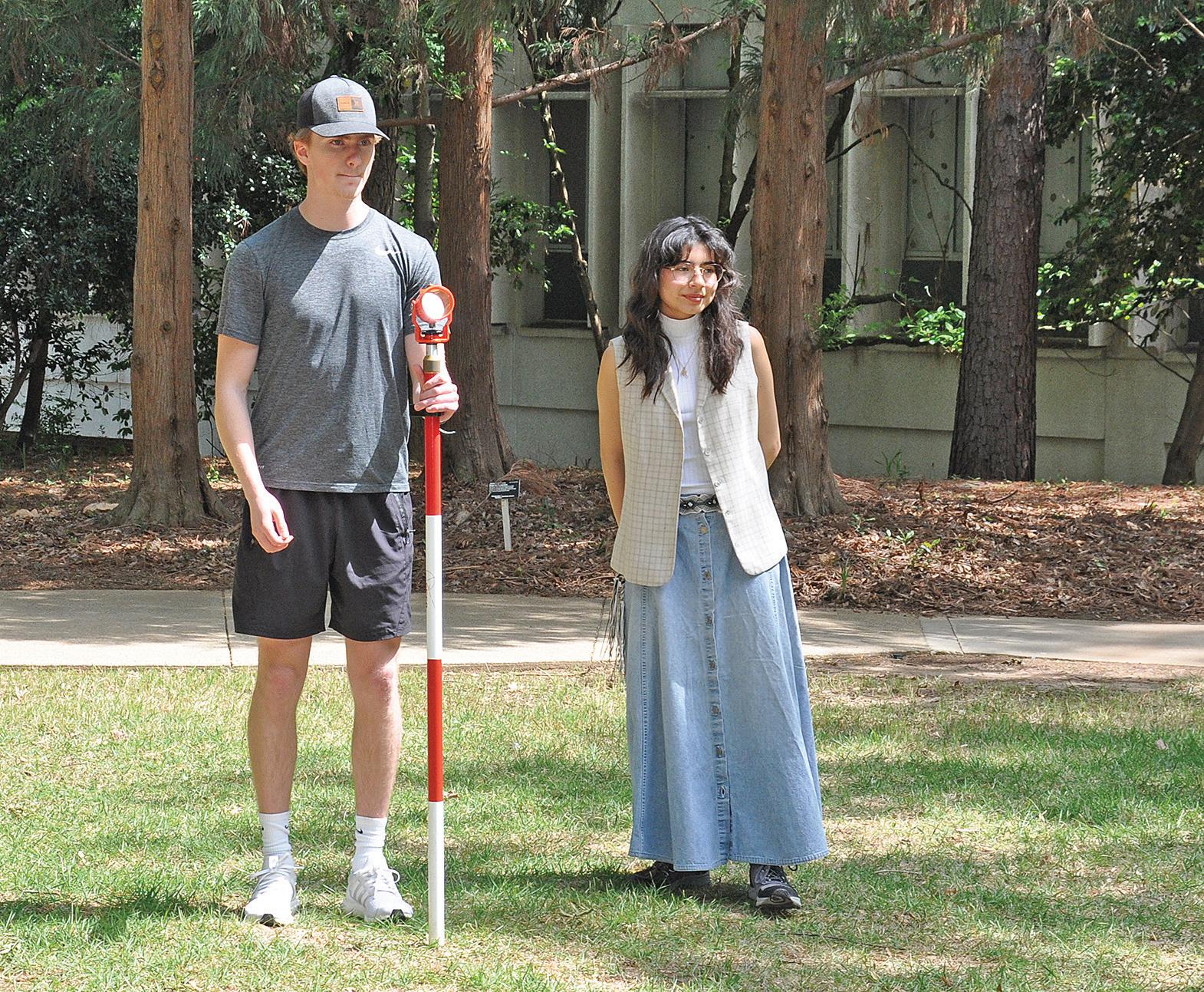
By Michael Hunter
Surveying was one of the first civil engineering courses taught at Georgia Tech over a century ago. Today’s students are still learning surveying, but with a modern upgrade, thanks to the recent addition of top-of-the-line equipment.
Surveying is the practice of measuring precise location points and mapping features on a piece of land ahead of a construction project or any major design project—some of civil engineering’s foundational skills.
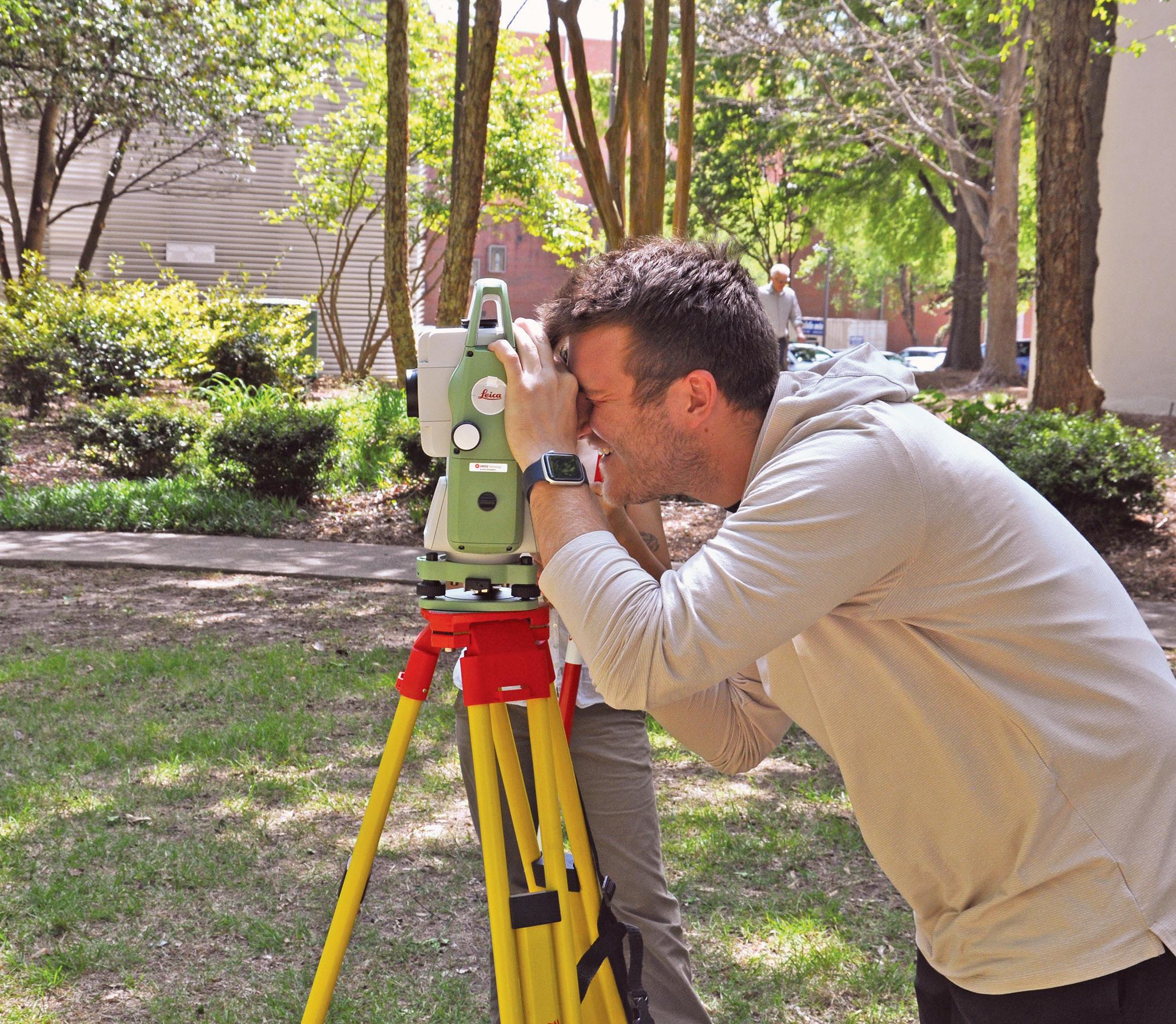
Dwight H. Evans Professor Susan Burns said the new surveying equipment reflects just how much surveying has changed over the years.
“What our students are learning to use today is the same state-of-the-art equipment that allows engineers to combine terrain, spatial features, and a wide range of cultural features into powerful mapping technology,” Burns said. “As our infrastructure systems become more complex, larger scale, the ability to monitor and map using these geospatial technologies becomes even more important.”
Bill Daniel is the COO of Lowe Engineers and a long-time adjunct professor of Geomatics, an elective course that combines surveying and Geographic Information Systems (GIS).
Daniel is a strong proponent of surveying who has taught hundreds of Tech students during his tenure. He is excited about the new surveying equipment and believes it’s a real boon for Georgia Tech.
“It’s a feather in our caps. It’s the most advanced surveying equipment in the world,” Daniel said.
The acquisition of three Leica Total Stations and a drone with LIDAR technology for students to use for their surveying assignments replaced equipment that had been in use for 30 years. Two employees from the manufacturer came to train graduate teaching assistants in the usage of the new equipment. The stations also collect GPS data, which used to require separate equipment.
“It is truly a total station,” Daniel said. “It measures distances, it turns angles, it collects GPS data.”
Daniel began teaching surveying at Georgia Tech in the 90s when the course was a civil engineering requirement known as “Plane Surveying.” When he arrived, he had over 100 students in the class for five straight quarters.
“I’ve been teaching the class for so long, it has definitely morphed and changed over the years,” Daniel said.
Burns, who is also a Georgia Tech alumna, said there has been an enormous change in surveying technology over the last few decades.
“When I graduated from undergrad in 1990, we still taught
Geomatics students Cullen Ross and Ahtziri Rosales Ramirez using some of CEE's new Leica surveying equipment.
(Photo by Michael Hunter)
Elijah Little using the Leica Total Station to capture surveying data. (Photo by Michael Hunter)
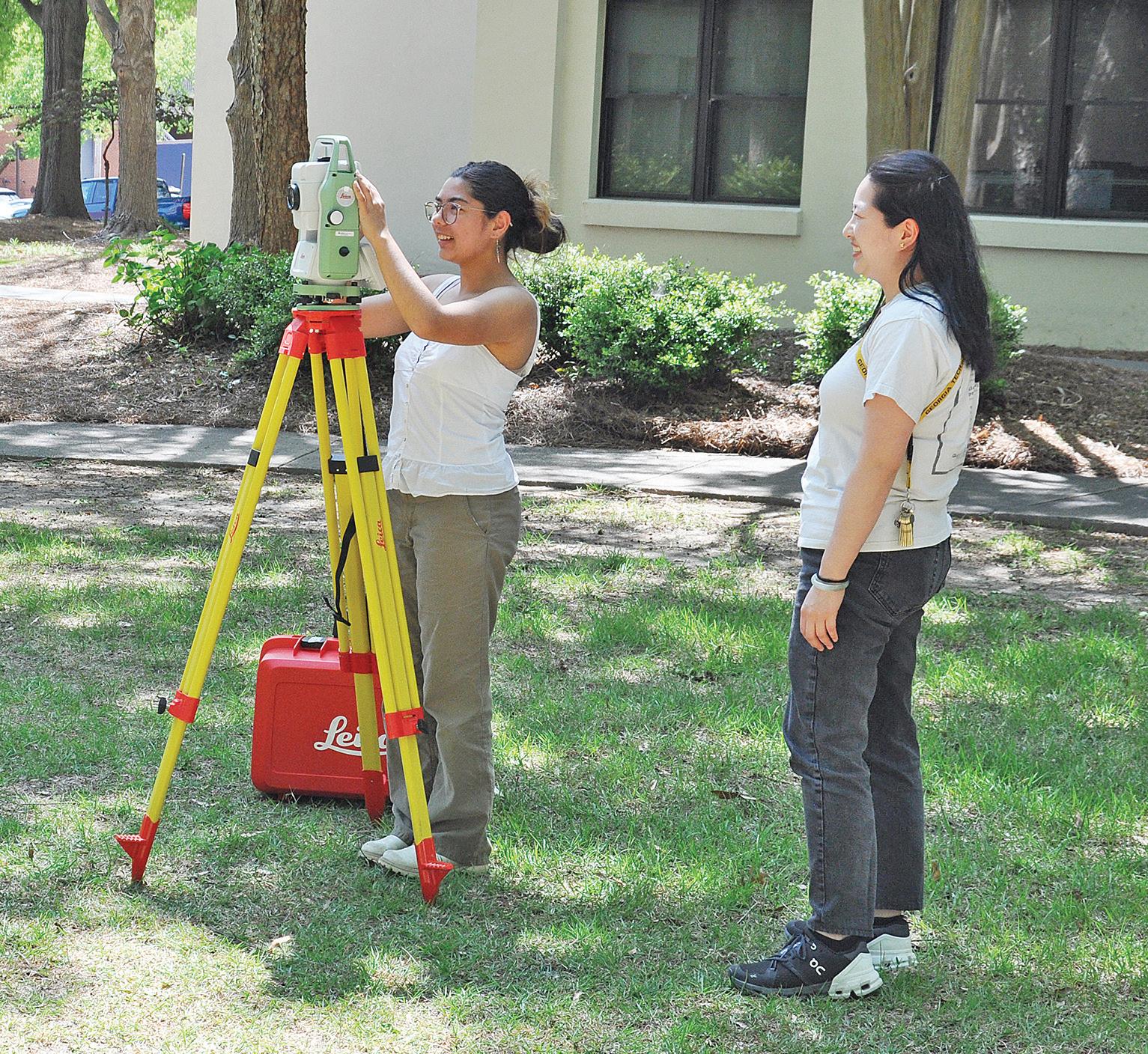
surveying using a transit and level, which was very old school technology, and we surveyed benchmarks located between the Student Center and Mason Building. Every student surveyed the same loop every quarter,” Burns said. “The technology has revolutionized since then.”
In 2002, the class was renamed Geomatics, adding the GIS component. Currently, Daniel teaches surveying for the first 10 weeks of the semester. For the last five weeks, his Lowe Engineers partner John Drysdale teaches the students how to plug the data harvested from surveying into GIS, which allows the data to be displayed digitally in 3-D or on a map for analysis.
Presently, surveying is no longer a required course for civil and environmental engineers.
Many engineering schools have eliminated surveying classes, which Daniel declares to be “a total crime, in my opinion.”
Daniel believes geomatics is “a fundamental baseline of knowledge for civil and environmental engineers, and something that they use and apply in their careers.”
“Geomatics is important for the civil and environmental engineering student because it is one of the skills that almost all civil and environmental engineers will use and be exposed to in the course of their professional careers,” Daniel explained.
Geomatics is now offered as a technical elective.
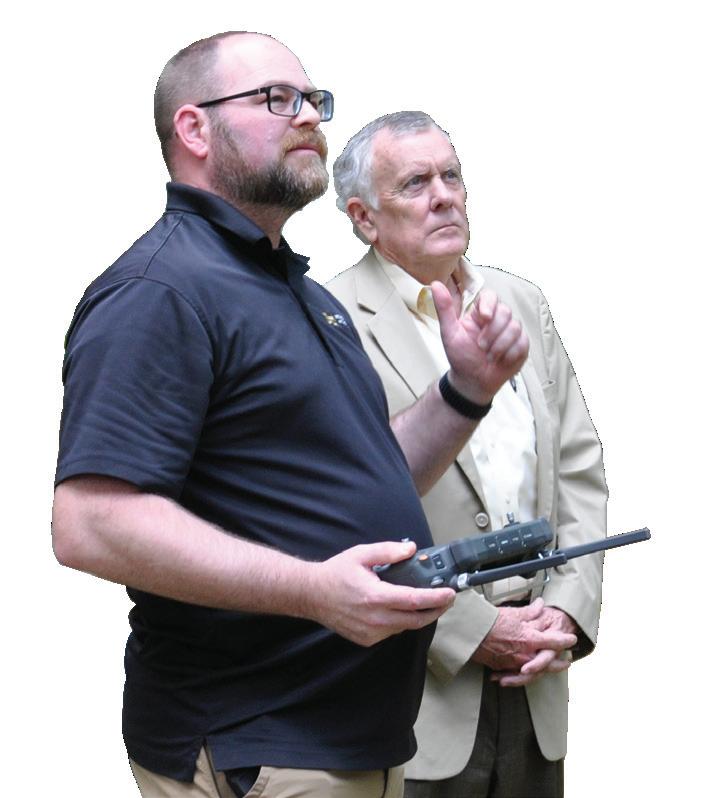
Adjunct Professor Bill Daniel, right, watches Doug Sims piloting the DJI Matrice M350 RTK drone
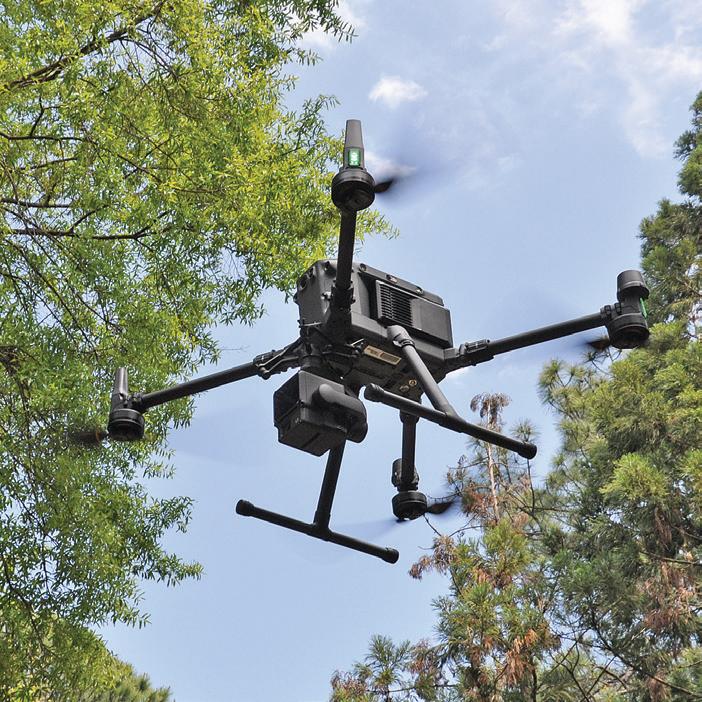
Graduate teaching assistant Kelly Yamamoto observes as geomatics student Maxine McCalla sets up the Leica Total Station. (Photos by Michael Hunter)
“We thought it was a bad thing,” Daniel said of the class being classified an elective. “It has turned out not to be.”
Daniel credits CEE’s student advisors with steering students toward a class with practical applications. “Every semester I get comments about how refreshing it is to have a hands-on lab,” Daniel said.
Kelly Yamamoto, a graduate teaching assistant in the geomatics course, said students have really enjoyed going out into the field and using the new equipment.
“Students think some of the initial equipment they are introduced to is old-fashioned, but then we quickly move to using the top-of-the-line total stations, as well as participating in a drone demo,” said Yamamoto. “Students’ favorite part of this class is the lab portion which provides a hands-on experience of what surveyors actually do.”
Ahtziri Rosales Ramirez, a spring 2025 geomatics student agreed. “It was exciting to go out in the field and work with tools like the total station, as it brought the concepts to life and helped me better understand how data collection and positioning work in real-world scenarios,” she said.
Rosales Ramirez said she is putting what she learned in the class to good use in a GIS-focused internship this summer.
The drone, a DJI Matrice M350 RTK, is operated by Doug Sims, a Senior Systems Support Engineer with Infrastructure and Sustainability at Georgia Tech. According to Sims, the drone excels in scanning and recording data for a large area at once, in contrast to traditional surveying, which relies on field workers to manually walk an area to capture topographic information as single elevation points. The drone records the elevation of the ground much more accurately and completely than traditional surveying, although processing the large amount of data takes more time afterwards.
The geomatics course continues to be popular, attracting 40 to 50 students every time it is taught.
“I teach the geomatics course with the baseline that the students are unlikely to end up being professional land surveyors, so my mission is to expose them to as many and as much of the different aspects of surveying as possible,” Daniel said. “Now, having the latest new and state-of-the-art equipment, we can truly let our future engineers see what and how we collect data in the field.” l
The DJI Matrice M350 RTK hovers over the Mason Building
New Faces
CEE WELCOMES NEW FACULTY
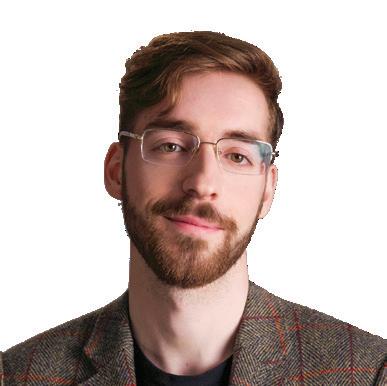
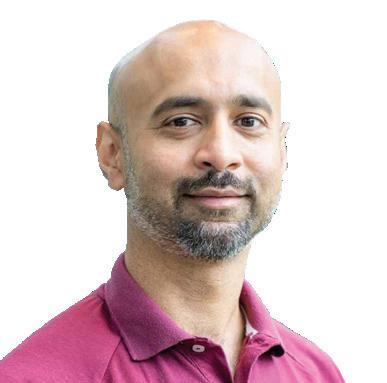

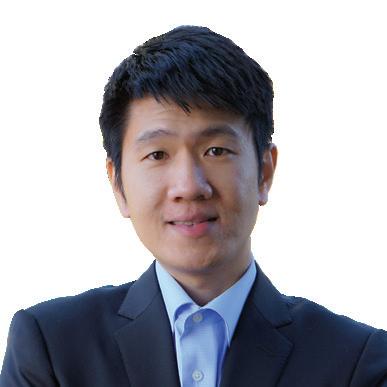
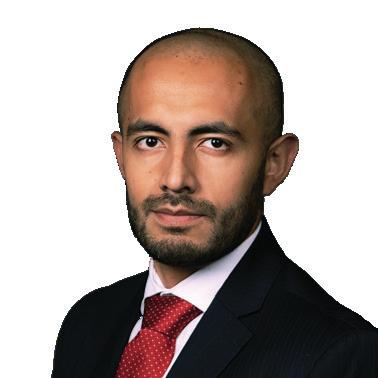
Edvard Bruun
Assistant Professor
Bruun’s research is on cooperative robotics for applications in the construction industry. Bruun uses industrial robotic arms to build geometrically complex but efficient spatial structures without the need for external scaffolding. The goal is to leverage emergent automation technologies to reduce material inputs during construction and facilitate reuse and disassembly.
Chris C. Martin
Director of Collaborative Innovation
Martin is the director of the Collaborative Innovation Center. He conducted research on team justice, inclusion, and psychological safety while working as post-doctoral fellow in the School of Biomedical Engineering.
Olga Menagarishvili
Director of Charles E. Gearing Program in Engineering Communication
Menagarishvili has a Ph.D. in Rhetoric and Scientific and Technical Communication from the University of Minnesota, Twin Cities. She directs the Charles E. Gearing Program in Engineering Communication. Begun in 1998, this endowed program directly links communication strategies with course content by meaningfully integrating written, oral, visual, electronic, and nonverbal communication into the engineering curriculum.
Da Pan
Assistant Professor
Pan’s research addresses the environmental challenges of managing the atmospheric carbon and nitrogen cycles. He focuses on climate change, reducing pollution damaging to human and ecosystem health, and sustainably supplying food, water, and energy.
Fernando Patino-Ramirez
Assistant Professor
Patino-Ramirez’s research vision is to enable the construction of resilient geotechnical infrastructure that meets the needs of society and safeguards the environment. His research combines analytical, experimental, numerical, and data science tools to study the behavior of soils at different scales.
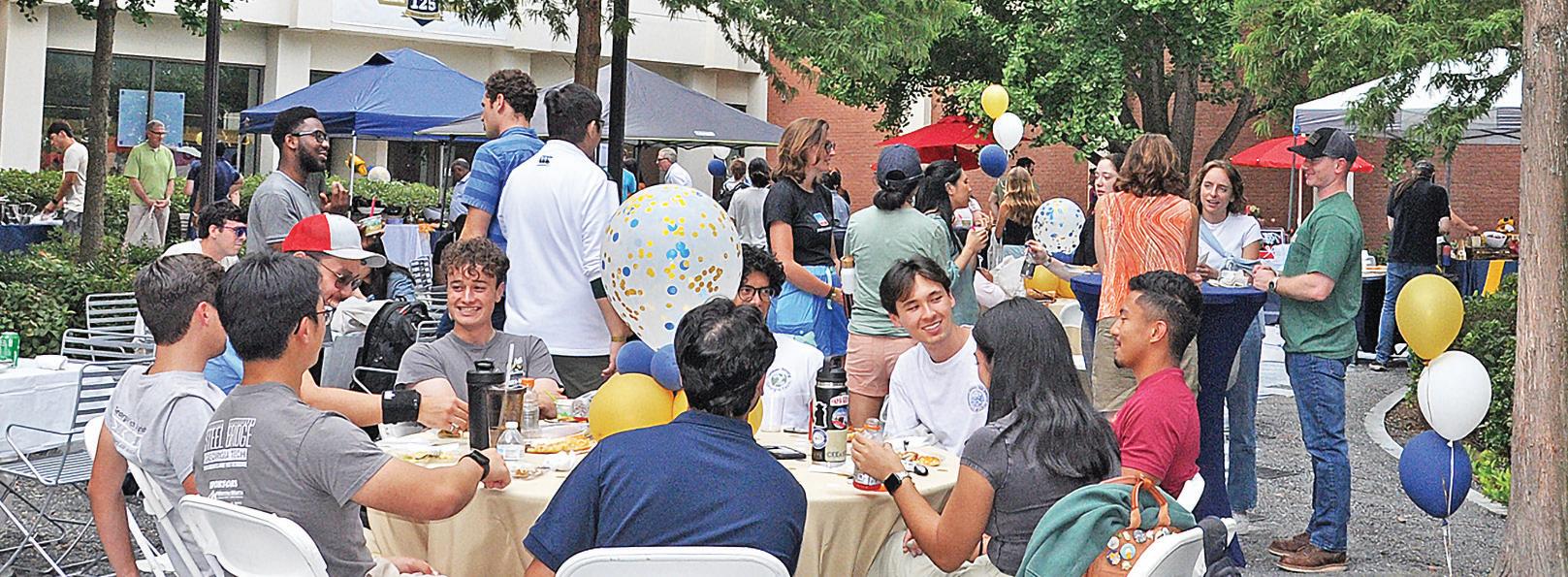
AN EXCEEDINGLY GOOD YEAR
Clockwise from top: 1) The School of Civil and Environmental Engineering welcomed back students, faculty and staff in August; 2) An Indian classical dance presentation from GT Pulse at CEE’s inaugural Diwali celebration; 3) The CEE Concrete Canoe team pouring and shaping concrete to create this year’s canoe: Rock ’n’ Row; 4) Professor Lauren Stewart’s Global Innovations in CEE class visiting the Sólheimajökull Glacier in Iceland.


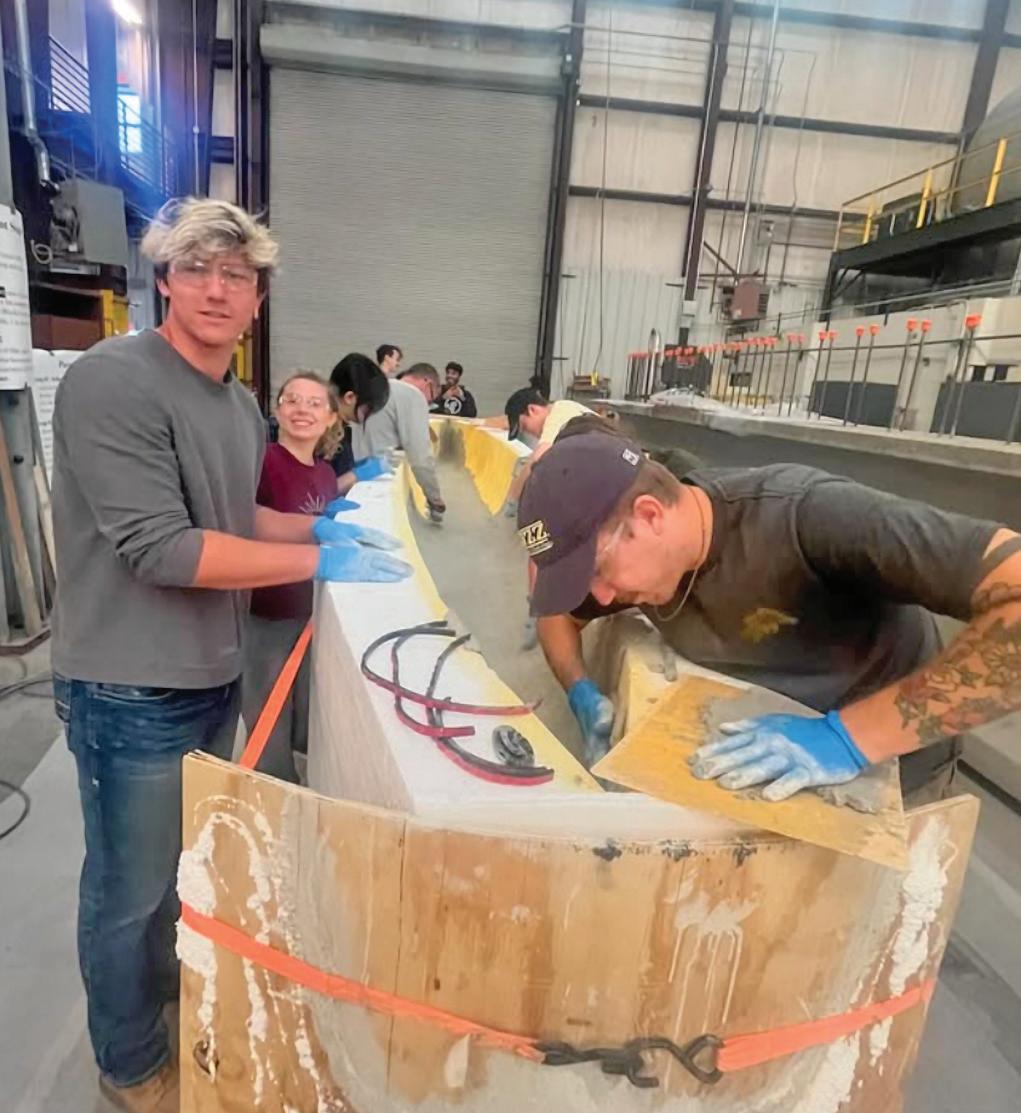
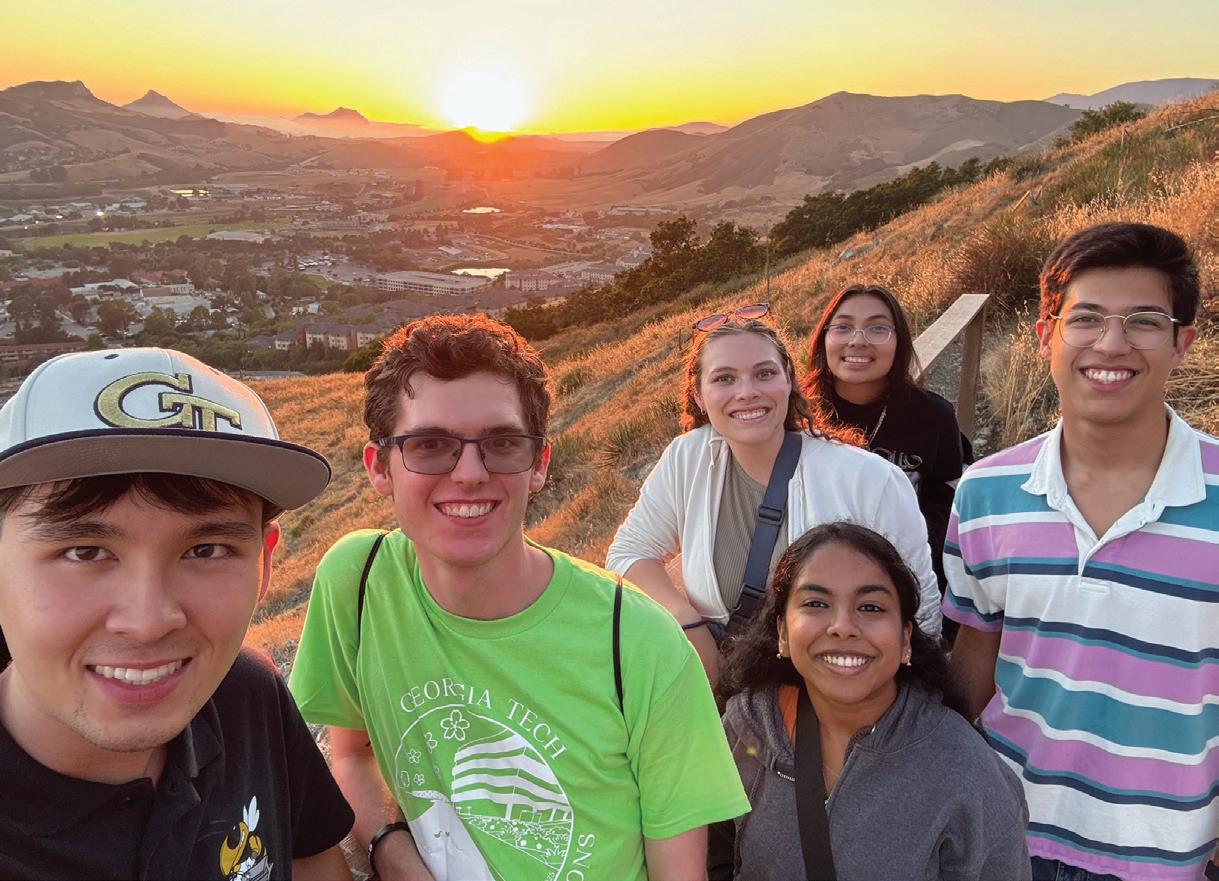
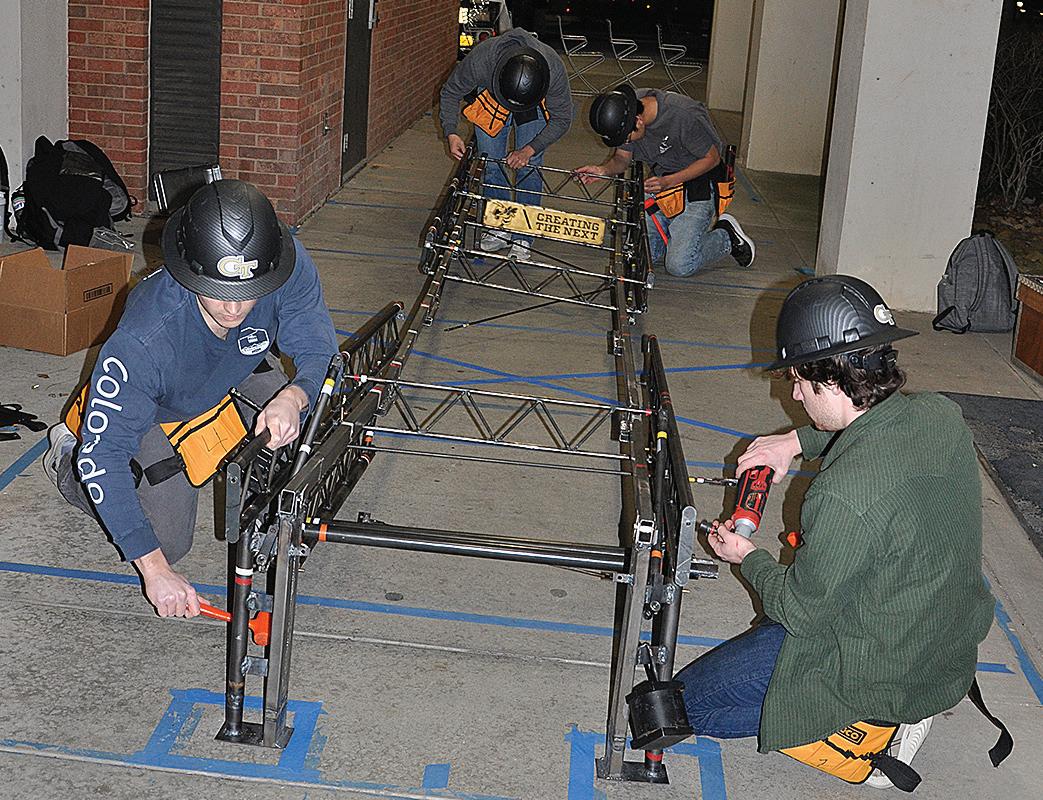
Clockwise from top: 1) The GT ASCE team enjoying a California sunset in San Luis Obispo while at the national ASCE student Sustainable Solutions competition in June at Cal Poly; 2) The GT ASCE team practicing for the regional Steel Bridge competition outside the Mason building; 3) Dr. Lisa Rosenstein, director of the Charles E. Gearing Program in Engineering Communication, speaks at her retirement party; 4) Students in Sharon Just’s Hands-On Treatability & Design course. 5) The Georgia Tech student chapter of the American Concrete Institute on a site visit with their sponsor, Fred Meyer, far left. 6) Students, alumni and faculty gathered on the Mason Building plaza for a Homecoming tailgate party in November.
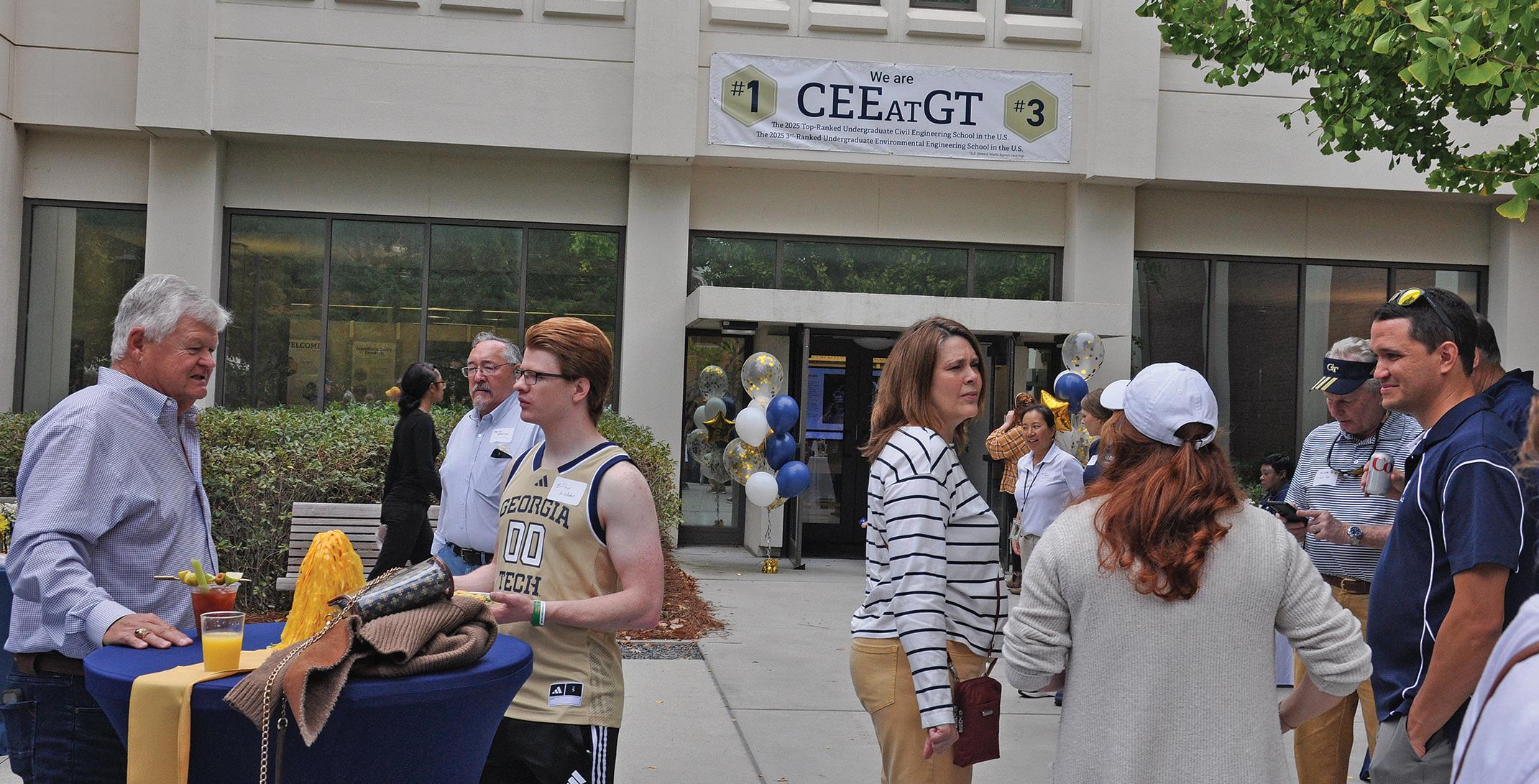
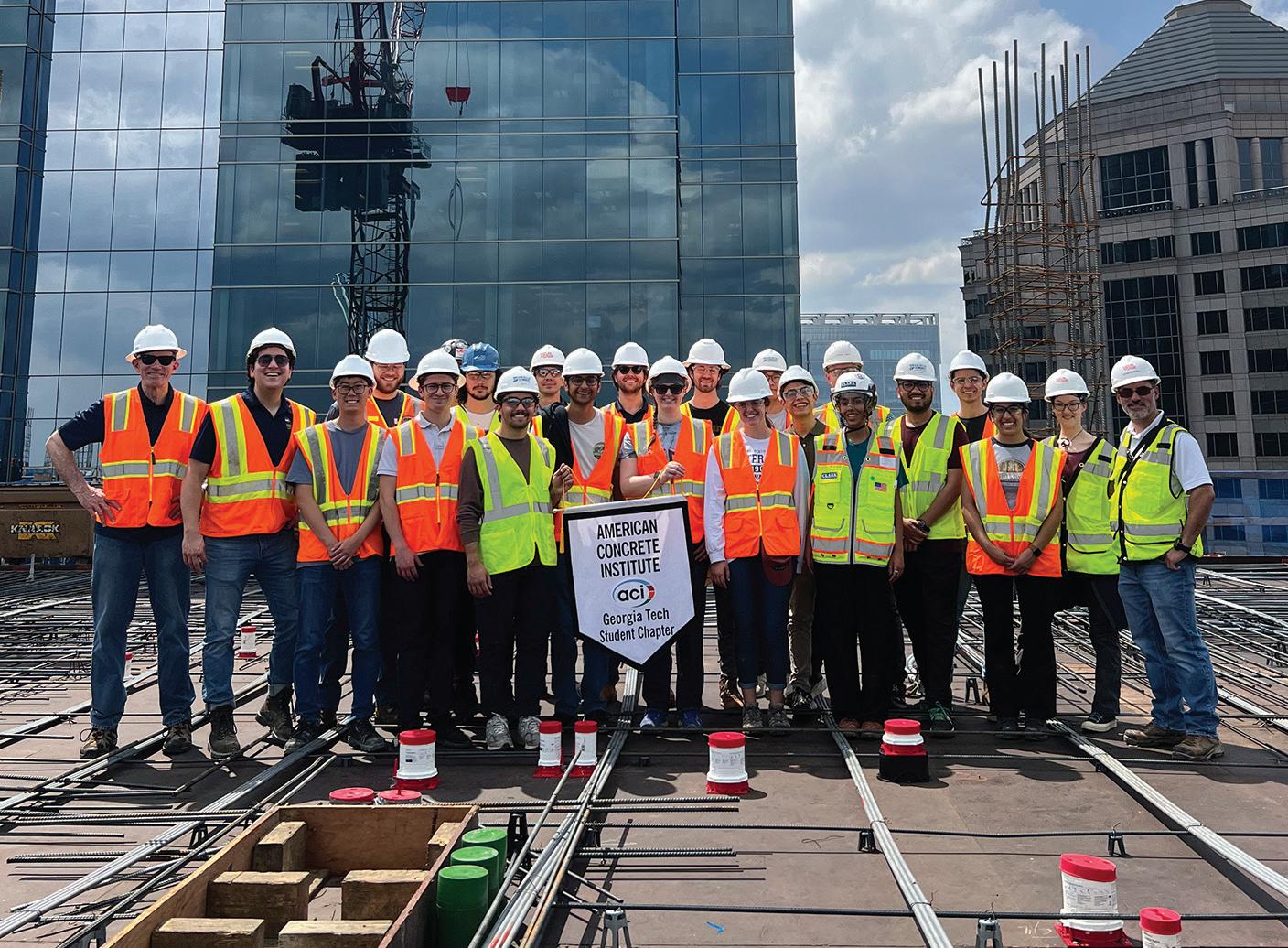

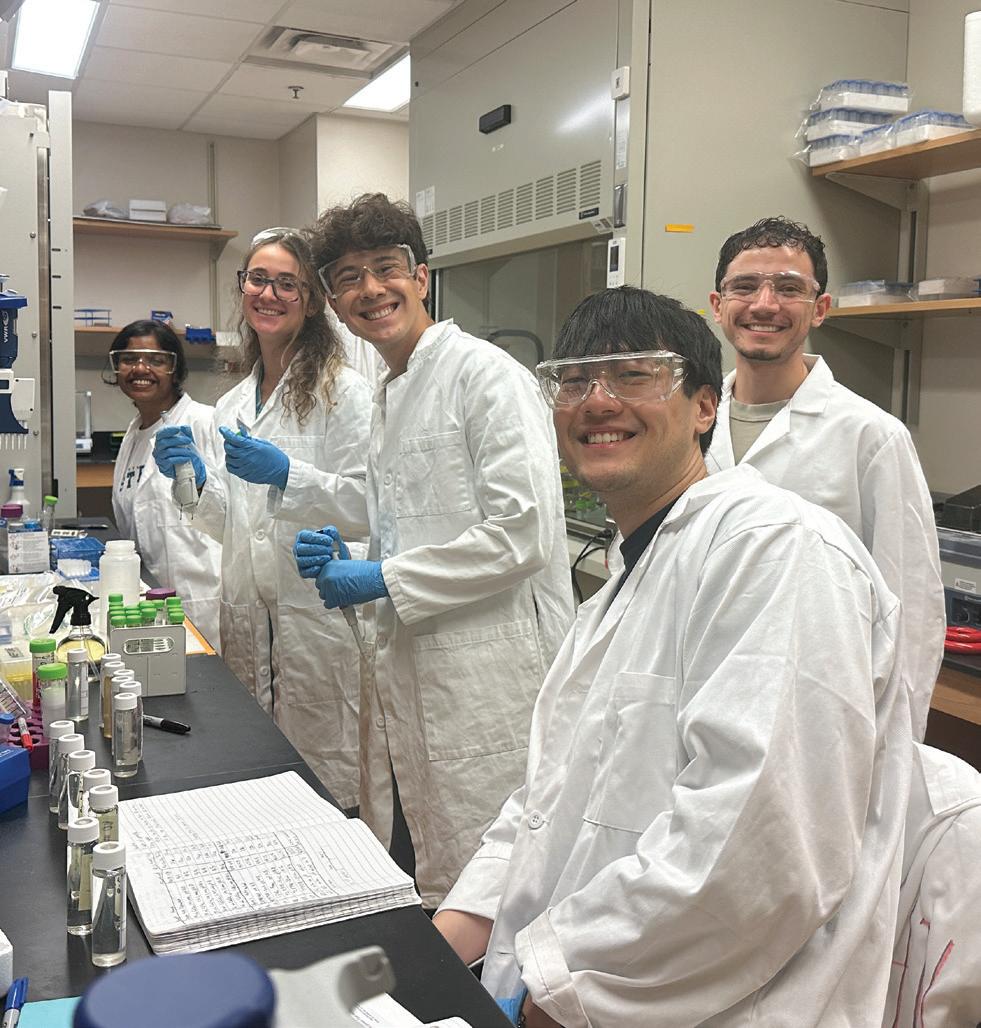
WHEN DISASTER STRIKES
17 years after establishing the International Disaster Reconnaissance course, David Frost takes the class in a new direction.
By Melissa Fralick
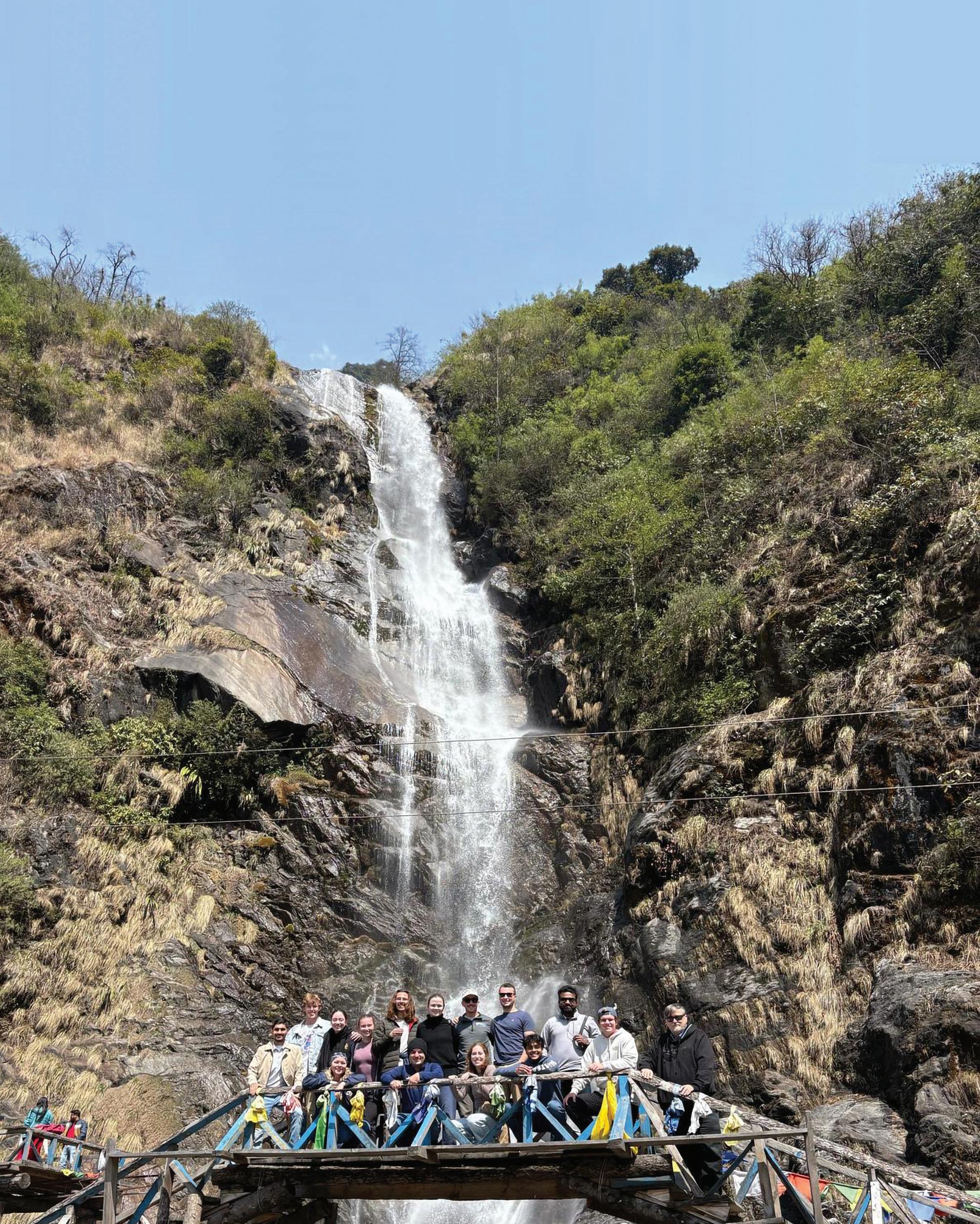
Over spring break,
Professor David Frost led a group of 15 adventurous young engineers on a journey to Sikkim, a remote destination in the Himalayan Mountains.
On their weeklong journey, the group observed the site of a hydroelectric dam failure that resulted from a glacial lake outflow, learned about disaster recovery in different cultures, and visited some of the cultural highlights of the region.
Below: Professor Frost, right, with the IDR class group at Bhewma Falls near Lachung, North Sikkim, India.
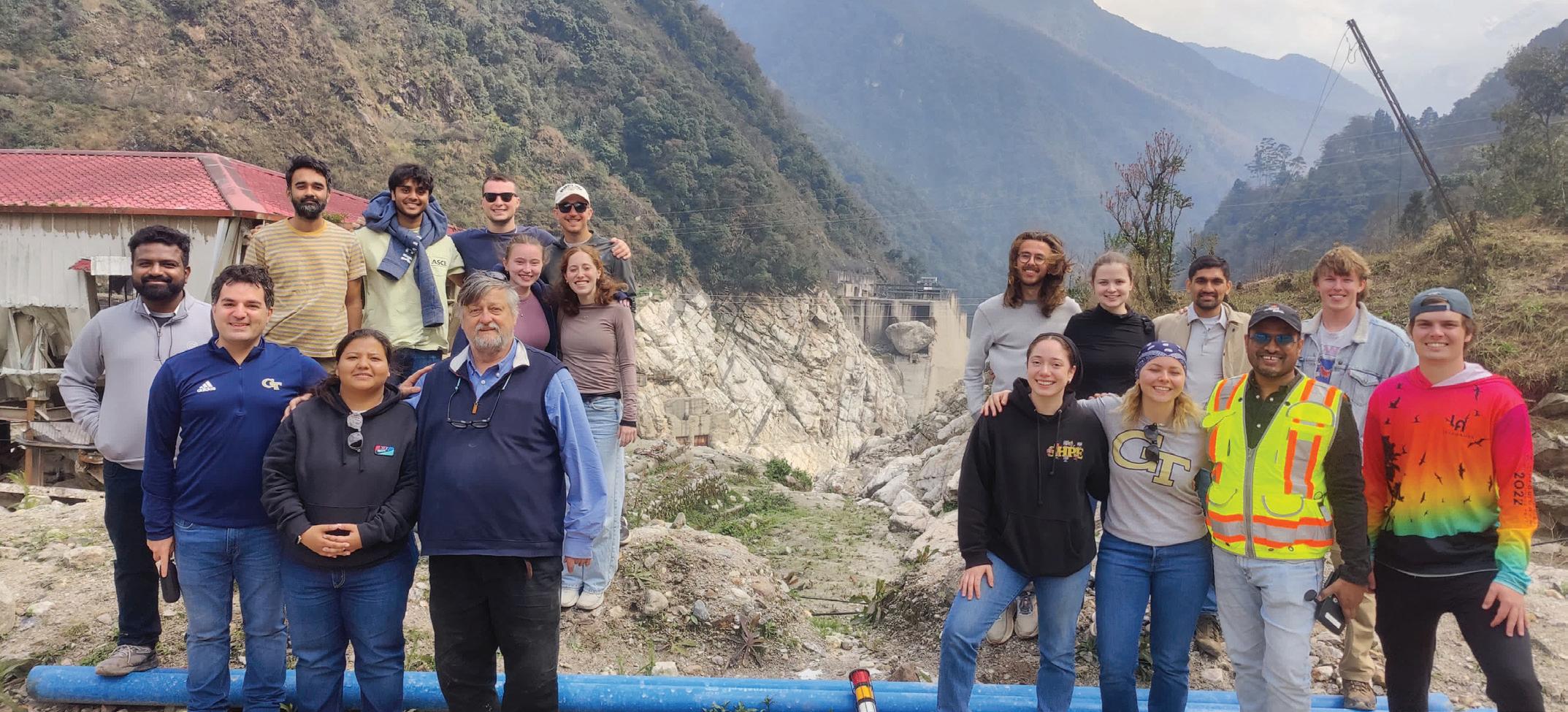
Frost has led spring break trips for students in his International Disaster Reconnaissance course for nearly two decades. But this was the first time he took his class to Sikkim.
“It was a phenomenal experience,” Frost said.
How it Started
Frost’s class focuses on disaster reconnaissance, the practice of collecting perishable data following a disaster, as well as studying the way that an area rebuilds and recovers over time.
Frost began teaching the International Disaster Reconnaissance class in 2008, following the massive Sichuan Earthquake in China and subsequently, the 2011 Tohoku Earthquake and tsunami in Japan.
Each year, Frost and his students traveled to China and Japan to visit the regions impacted of the earthquake. Over the years, they’ve studied the area’s recovery from the earthquake and tsunami as well as visited historical and cultural sites.
Now that 17 years have gone by, the evidence of the earthquakes is all but gone. Frost said 15 years is typically how long it takes for people to repair damage and for nature to regenerate an area.
“I find it fascinating that nature’s timeline for recovery is similar to the human timeline for recovery,” Frost said.
Why Sikkim?
This year, Frost decided that the time had come to find a new destination for the travel component of his class.
He considered Turkey, where he had recently traveled to conduct disaster reconnaissance following a major earthquake. Ultimately, he decided the site’s location near the border with Syria was too dangerous.
Instead, he set his sights on Sikkim: a state in northeastern India and the site of the powerful Chungthang Dam collapse in 2023. Frost teamed up with a professor from the Indian Institute of Technology and booked a trip to see Sikkim for
himself shortly after the event. He soon knew it would be the site of his next class trip.
Originally a separate country, Sikkim, located at the border of Nepal and Tibet, feels different than the rest of India, Frost explained. To get there, you have to get a visa to travel from the U.S. to India and then an additional permit to enter Sikkim.
The small Himalayan state is very focused on sustainability and keeping the environment pristine, Frost said.
“That resonated incredibly well with the students coming from here and taking the class,” Frost said.
In late 2023, Sikkim experienced a catastrophic dam failure caused by a glacial lake outflow.
Heavy precipitation and meltwater led the natural dam of a lake in the mountain foothills to be overtopped. The rushing water picked up rocks and debris and headed downstream, where the torrent wiped out an entire concrete hydropower dam—the area’s main source of electricity.
“It was like a secondary disaster,” Frost said.
On their trip, the students visited the Chungthang Dam and stopped at various points upstream and downstream of the dam along the Teesta River to study the region and what factors contributed to the catastrophe.
Arya Desai, one of the students on the trip, said it was incredible to see how important the relationship between infrastructure and people is for a society.
“Seeing the dam failure at Chungthang put into perspective the delicate balance between resilient engineering and the forces of nature, and how major disasters can deeply affect local communities and the environment,” Desai said.
International Disaster Reconnaissance
Reconnaissance work is typically conducted immediately after a disaster—such as an earthquake, tornado, or flood— with a focus on perishable data.
David Frost's International Disaster Reconnaissance class standing in front of the concrete hydropower dam that collapsed in 2023 in Sikkim, a state in India on the border of Nepal and Tibet. (Photo courtesy David Frost)
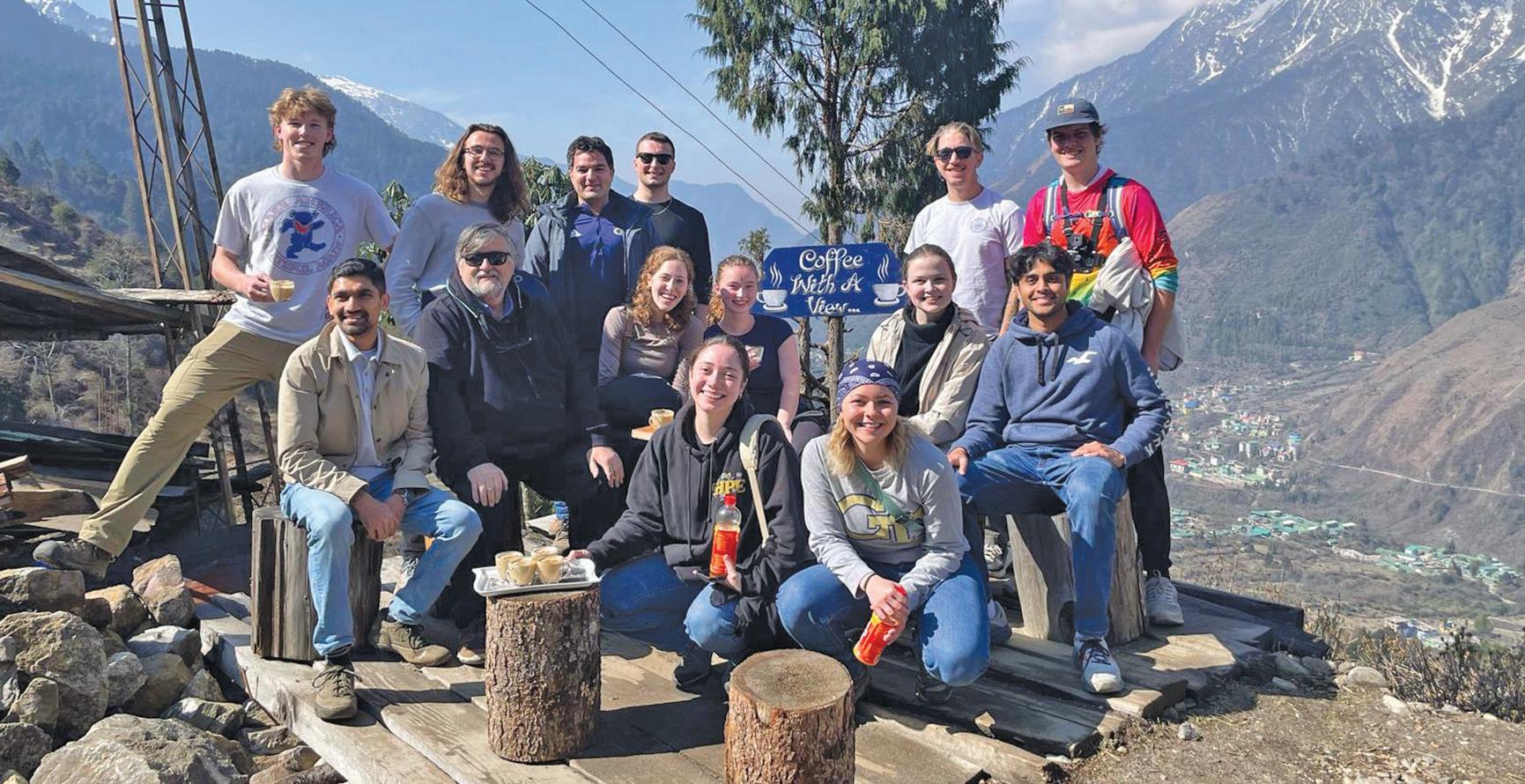
For example, if a building is damaged beyond repair by an earthquake, it will be torn down. Once it’s gone, engineers can no longer study how the building was damaged, and its structural points of failure or strength.
“Ultimately, the goal is should we be changing the way we build a particular type of structure?” Frost said. “We need to try to increase the resilience of our infrastructure.”
Frost brings real-world experience to the classroom through his work with GEER, the Geotechnical Extreme Events Reconnaissance Association. The group is funded by The National Science Foundation and provides post-disaster geotechnical engineering reconnaissance efforts. Over the years, he’s traveled the world in the wake of disasters to collect data.
Frost said he also likes to revisit a disaster site over time to see the progress of rebuilding efforts and how different cultures approach disaster recovery.
“The pace of recovery is different in different countries,” Frost said.
For example, following a disaster, some cultures will rebuild on the same site while others will conclude the hazard is too high and relocate. Some may choose engineering solutions that confront nature with, for example, more concrete, while others may opt for solutions that work with nature and account for the increasing severity of natural disasters.
“How do you build?” Frost said. “What are the different approaches you can take to rebuilding in the context of
resilience and safety for society?”
Global Engineering Leadership
Early in his career, Frost had the opportunity to travel to the Canadian Arctic region for work. He said the trips were a formative experience for him. With his International Disaster Reconnaissance class, Frost hopes that the trips he leads each year provides students with new perspectives that will stay with them.
“I realized I had a chance to give those same experiences to students that were so important to me as a young engineer.”
The course is a part of the School of Civil and Environmental Engineering’s Global Engineering Leadership program, in which students can earn a certificate or complete a minor.
Professor Adjo Amekudzi-Kennedy, interim associate chair for administration and finance, led the creation of the Global Engineering Leadership Minor. She said classes like this one are incredibly beneficial for students as they develop their professional identity.
“The grand challenge courses in the Global Engineering Leadership Minor give our students the opportunity to develop their leadership skills while working on real-world challenges in the U.S. and abroad,” Amekudzi-Kennedy said. “They hone their problem solving, communication, teaming, system analysis and cross-cultural skills as they mature into graduates better equipped to improve the human condition and add value to society.” l
“ ” I realized I had a chance to give those experiences to students that were so important to me as a young engineer.
— Professor David Frost
David Frost's IDR class having “coffee with a view” in the Himalayan Mountains in Sikkim, India. (Photo courtesy David Frost)
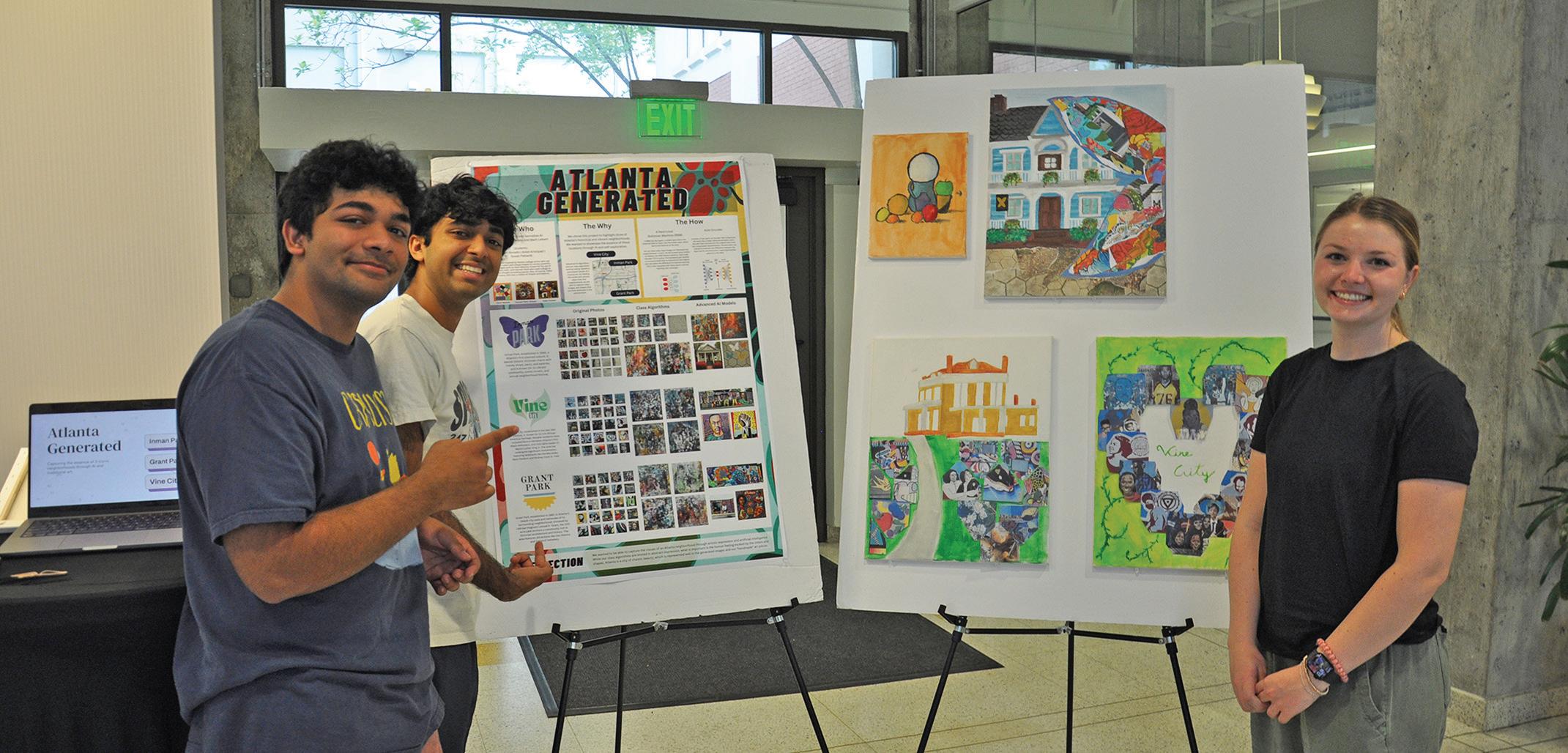
New Course Broadens Students’ Horizons Using AI
By Michael Hunter
Mingling in the lobby of the Mason Building, a group of engineering students participated in their first art show opening on April 23. Like the hybrid class from which the artwork sprang, the exhibits were a cross between art festival and Capstone projects: drawings, paintings and videos accompanied by detailed informational posters describing the computational processes by which the collaborative final art was made.
Their artwork, created in collaboration with generative artificial intelligence (AI), was the culmination of a new interdisciplinary course called Art and Generative AI, co-taught by Francesco Fedele, associate professor of civil engineering, and Mark Leibert, a professor of the practice in the School of Literature, Media, and Communication.
Fedele and Leibert collaborated on the design of the course in response to call for more AI-based classes in the College of Engineering. “Art and Generative AI” is one of the electives in Georgia Tech’s new minor in Artificial Intelligence and Machine Learning, offered in partnership with the College of Engineering and the Ivan Allen College of Liberal Arts.
Taught for the first time in the spring semester, the course explores the intersection of AI technology, art, design, and neuroscience to create innovative synthetic, or generative media for artistic expression. Students learned how to leverage AI algorithms, design principles, and neuroscience insights to generate new forms of visual and auditory art.
Two histories, one goal
The students started out the semester getting a crash course in both art history and the history of AI.
Fedele became interested in AI for art and rogue wave research. “Most people, when they want to learn something, they take a class. Me? When I want to learn something—I teach it,” he said.
Fedele dove into the fundamentals of AI, connecting them across disciplines, and built things—from neural models of ocean waves to brainwave-powered art installations. “I teach AI not just to share knowledge, but because teaching forces me to understand it deeply, ask better questions, and keep exploring.”
In the class, Fedele takes his students through the history of AI models and provides them with Python scripts to explore how each one works. Throughout the semester, the class inputs imagery into the algorithms to create composite art they can build upon.
“Basically, we deliberately push all these AI algorithms in their state of weakness so that they produce hallucinating and confusing output, Fedele said. “That is helpful, because then a student can reclaim control on the creative process and they can use that output and reimagine it and reinterpret it.”
In contrast with the perfect output of modern-day AI software like ChatGPT, Fedele shows the students how to
Continues on next page
The Atlanta Generated team displays the artwork created after processing images from Atlanta's Inman Park, Grant Park and Vine City neighborhoods with generative AI algorithms. (Photo by Michael Hunter)
produce imperfect “hallucinating” output by deliberately limiting data sets, reducing training times or working with constrained models. The students then step in to interpret the imperfect output, elaborating upon it to reach the final artistic work.
Concurrently, the students also learned fundamentals of various artistic media — drawing, printmaking, oil painting and sculpture—in labs with co-teacher Liebert, a professional artist and professor of the practice who pioneered utilizing AI in artistic practice at Georgia Tech.
The students had a wide range of familiarity with artmaking, according to Leibert. “It’s not like there are these really clean distinctions between humanities and engineering students,” Leibert said, “But it’s always interesting to see how to make inroads to a unique student.”
“I want the student to be exposed to different energies and ways of thinking.”
— Francesco Fedele
Leibert saw the labs as working in parallel with the computer history, starting out with black and white charcoal drawings. “I would try to align that with the basics of computer vision, for example, binary images, black and white images. Then the progression of black and white to grayscale; the progression of grayscale to color, and so on,” he said.
Leibert stressed that as a teacher he always likes to “meet students where they are” in their creative process. “There are people who might think ‘Oh, I don’t do art.’ But, it turns out they are really talented with manga stuff. You have to start with the things that people are good with and build the conversation from there.”
Leibert praised Fedele’s use of the early neural networks as examples for students learning AI. “Very few students have had access in any depth regarding the history of neural networks. This course is extremely unique in that regard and, I would say, probably stands alone,” Leibert said. “I’ve never heard of a course that covers the art historical depth and the technological depth that that this course covered,” he said.
According to Fedele, co-teaching with an artist is a compelling model for integrating the arts into STEM, fostering creativity and innovation at the intersection of art, science and technology.
“I want the student to be exposed to different energies and ways of thinking,” Fedele explained.
Fedele became interested in art and drawing after a serious injury in 2016. He started drawing and painting during recovery as a form of self-taught art therapy. “As art became part of my life, I felt compelled to share its impact with my engineering students—helping them see science through an artist’s lens,” Fedele said.
This class builds on an earlier graduate-level class, “Arts and Geometry” that Fedele has taught five times since 2018. The class explores how geometry influenced the art of Pablo Picasso and the relativity theories of Albert Einstein. That course was also co-taught by Atlanta-based professional artists and culminated in the students showing their geometry-
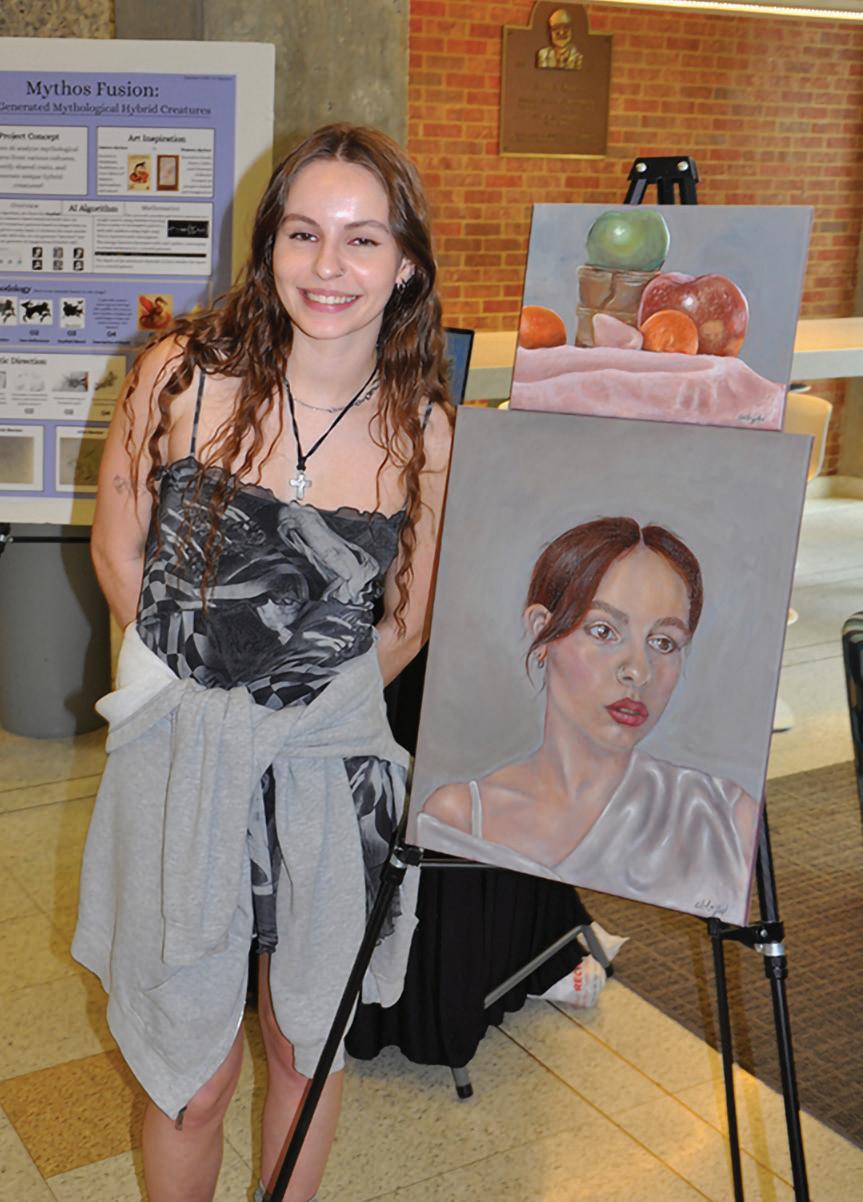
influenced artwork for one night at a local gallery.
Fedele was recognized in 2024 by Georgia Tech’s Center for Teaching and Learning with its Curriculum Innovation Award, which highlights faculty who are improving the quality of education at Georgia Tech through pedagogical and curricular innovation.
Empowering students with creativity
At the Mason lobby art show, the students displayed selfportraits and still lifes created during the artistic practice labs as well as their finished art piece created in collaboration with the generative AI. Projects used a wide variety of themes interpreted by the AI algorithms as the basis to build new art upon, including nostalgic imagery, Atlanta neighborhoods, contemporary light painting and the artwork of Henri Matisse. Each project explained the processes used to reach the final artwork created by the hands of the students.
The inaugural class proved to be a popular one, with 30 students from across disciplines.
“We had not just civil engineering students but LMC, Computer Science, ECE, Aerospace, Psychology, Physics,” Fedele said. “It’s pretty broad-banded, which I like. Nowadays, engineering is so multi-disciplinary, you need the students to be exposed to different fields.”
CEE student Abigail Willis stands next to a still life and a self-portrait painted during Art and Generative AI’s lab class.
(Photo by Michael Hunter)
Fedele hopes the class will equip his students with knowledge about AI’s true capabilities and limitations and prepare them to use these tools ethically and creatively.
“I think they will have a better understanding of what the fundamentals are when they utilize all these available software like ChatGPT, Mistral code or many others,” Fedele said. “They can approach it with more confidence.”
“AI entered our lives so rapidly, that many of us don’t fully understand how it works, why it works, when it fails, or what its core engine is,” Fedele said.
As for the future of AI, Fedele sees its true power as not in its ability to generate new content, but in helping us understand the content we already have. He thinks AI will revolutionize medical diagnostics by analyzing vast amounts of medical data to identify subtle patterns that might elude even skilled clinicians.
In Fedele’s own field of coastal and ocean engineering, AI can aid in predicting extreme events like storms, rogue waves, tsunamis and earthquakes.
To that end, Fedele, with the help of his class TA Kenneth Jenkins, has made his course notes on AI fundamentals available on a GitHub site for others’ use.
“The Python codes for use to make art with AI can also be used for research to forecast climate extremes, rogue waves, or to learn features of turbulence,” he said.
Fedele’s rogue wave research has been published internationally and he was invited to the the G7 at their third High Level Meeting on Maritime Security in 2017. His expertise was called upon in solving the 2015 sinking of the El Faro cargo ship during Hurricane Joaquin by the National Transportation Safety Board (NTSB). He is using the same AI algorithms he taught students for making art to study the physics of rogue waves.
“AI entered our lives so rapidly, that many of us don’t fully understand how it works, why it works, when it fails, or what its core engine is.”
— Francesco Fedele
Fedele has also championed AI on campus during the spring semester. He moderated a public panel discussion called, “Being in the World — Will AI Ever Have a Soul?” that featured MINERVA, an AI agent contributing to the discussion along with panelists from Georgia Tech, Agnes Scott and the Goat Farm.
He, together with his students Kenneth Jenkins and Dennis Frank, also put on Improv AI, a dance performance on Koan Plaza on April 15, where dance teacher Amber Johnson and alumna Bekah Crosby from Dance Contempra improvised choreography to music generated by AI from brain waves. Georgia Tech Aerospace graduate student Daamini Visaalaakshi and Carol Subiño Sullivan, the assistant director of faculty teaching and learning initiatives for the Center for Teaching and Learning (CTL), also performed together with the Dance Contempra dancers.
“We collected the brain waves with an EEG headset and from the signals of the brain waves, they were converted into music,” Fedele explained. The dancers’ choice of movements was “human improv on top of the EEG.”
As always, human creativity is the focus for Fedele.
“It’s not AI that rules the creation process, but it’s the human that uses AI to create,” he said. l
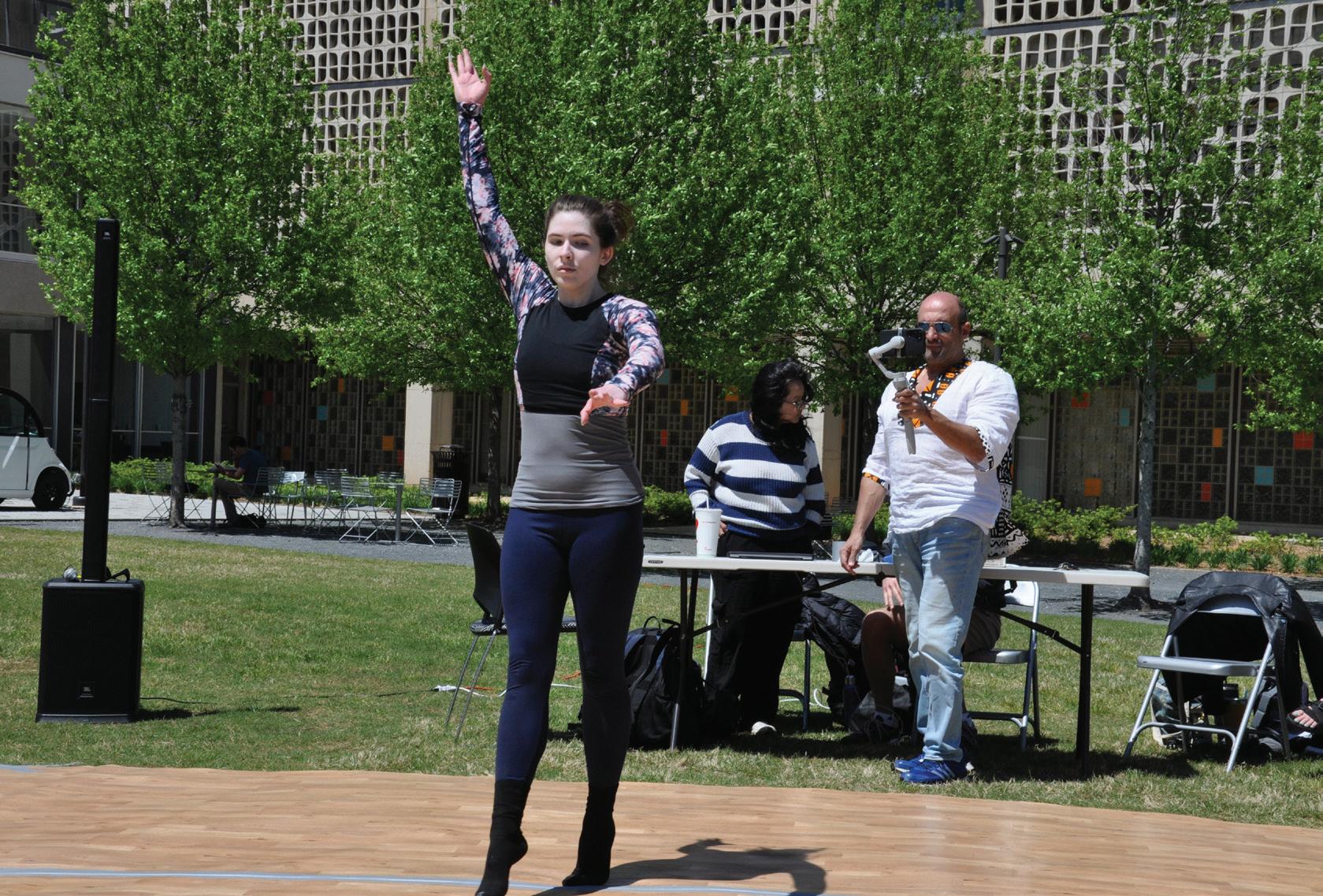
A dancer improvising movement to music generated by AI from brain waves on Georgia Tech’s Koan Plaza.
(Photo by Michael Hunter)

Explore Our
RESEARCH
Georgia Tech Brings Cone Penetration Testing to Illinois
Faculty from the School of Civil and Environmental Engineering worked with the Illinois Department of Transportation to introduce cone penetration testing: a method to test subsurface properties quickly and accurately.
Determining subsurface properties is key to designing more cost-effective, reliable transportation infrastructure such as bridges, levees and dams, among others.
Associate Professor Sheng Dai, Associate Professor Jorge Macedo, and Professor Emeritus Paul Mayne led the project with Brian Laningham and Brad Hessing, IDOT’s District 6 Project Engineer and Foundations and Geotechnical Unit Chief, respectively.
The team turned to cone penetration testing — an in-place drilling method that provides real-time information about the properties and strength parameters of subsurface conditions.
Cone penetration testing, a process Macedo compares to “subsurface radiography,” involves vertically pushing an electronic steel probe equipped with sensors into the ground to collect continuous measurements of soil properties and groundwater.
“Cone penetration testing is a modern alternative and supplement to the conventional means of geotechnical site investigation that uses rotary drilling, boreholes, augering, sampling or standard penetration testing,” Mayne said. “CPT is not only faster, more economical, safer and has higher reliability, but it also provides multiple continuous readings (often every 0.79 inches) with depth.”
The team assisted IDOT with developing CPT policies and procedures for Illinois, which currently uses the standard penetration test — a technique that brings significantly more uncertainty and collects only one data point in 5-foot intervals, resulting in considerably less data compared to CPT.
The Georgia Tech team, along with ConeTec personnel, visited sites in all nine IDOT districts

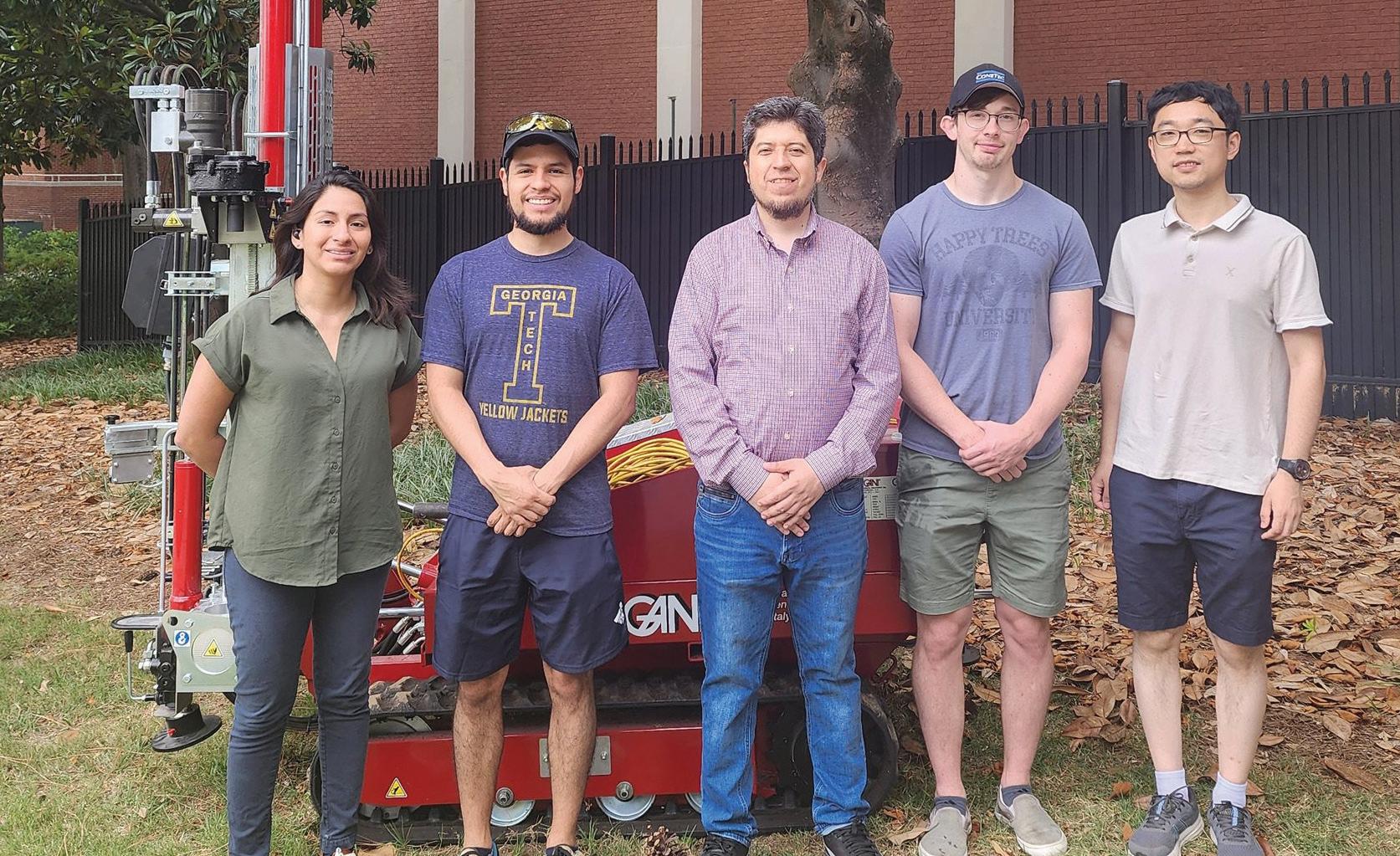
and conducted cone penetration testing, retrieving samples for laboratory testing to inform guidelines.
Their findings showed that most soils in Illinois are fine grained, such as clays, silts and loams, which is ideal for cone penetration testing compared to areas that contain coarse or compacted soils.
The Georgia Tech team also provided IDOT with recommendations for using historical borehole and standard penetration testing data to establish a correlation between the cone and standard penetration tests for Illinois.
“This research project provides a roadmap for implementing a CPT practice in the state of Illinois and all the benefits that this entails,” Macedo said. “In this manner, the geotechnical
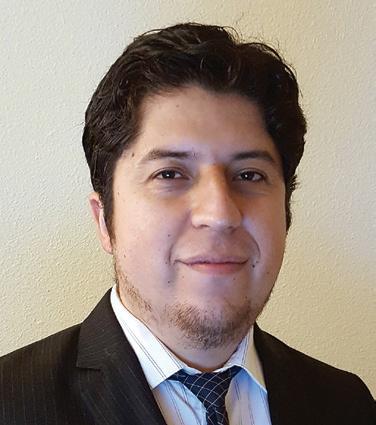
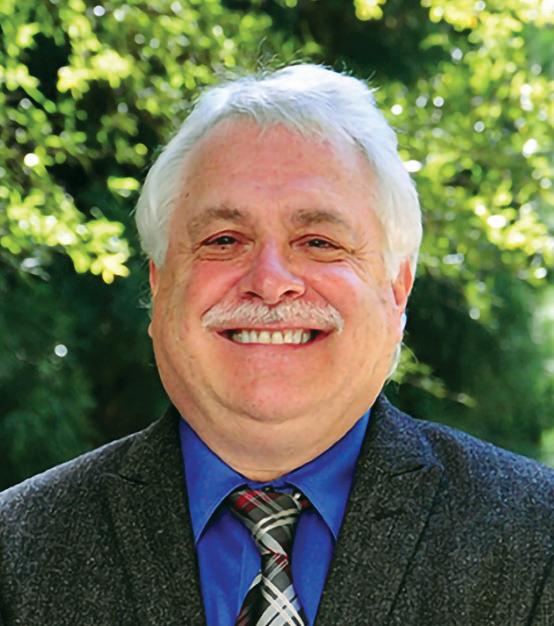
practice at IDOT is expected to be advanced, consistent with the practices at other DOTs in the U.S. that have already implemented a CPT practice.”
The traveling public can expect to see further benefits from improved subsurface testing time: fewer lane closures and safer highways.
“For highway development and reconstruction projects, the current practice involves a time-consuming process of conducting soil borings and running supplemental lab testing to get any results, make decisions and complete the design,” Mayne said.
“The CPT rig only needs one hour to complete a sounding, thus minimizing lane closures,” he added. “Also, CPT data are immediately available for design use. There is no 3- to 5-week waiting period for the laboratory to provide results.”
The project has also contributed to training the next generation of geotechnical engineers with CPT expertise.
The students involved in the different project stages include Cody Arnold, Paola Torres, Luis Vergaray, Yumeng Zhao, Lina Pua and Christopher Abdeen. Arnold and Torres led the project data collection and interpretation components. l
L to R: Doctoral students Paola Torres, Luis Vergaray, Associate Professor Macedo, Cody Arnold and Yumeng Zhao visited sites in all nine IDOT districts and conducted cone penetration testing to retrieve samples for laboratory testing.
Dai Macedo Mayne

Taming the Flood
For many people who live near the southern coast, a summer thunderstorm can be more than an inconvenience. When they drop inches of rain in a flash, the storms can quickly overwhelm systems designed to carry away all that water. If they persist, rivers can swell, pushing water upstream and inland.
And, by all accounts, it’s only going to get worse.
As communities grapple with mitigating current and future flood risks, Iris Tien and researchers in her civil engineering lab are working to help. Her team is developing a framework to help residents and city planners identify the right kind of floodcontrol infrastructure and the right places to put it.
“One of the big gaps I saw while working with coastal communities is that a lot of these infrastructure decisions are made ad hoc,” said Tien, Williams Family Associate Professor in the School of Civil and Environmental Engineering. “It’s often not very systematic. It’s not really data-based. This also leaves the process open to potential bias, where you don’t necessarily develop these solutions for the places that need them the most.”
For flood control, the choices largely come down to deciding between building “gray” solutions or “green” ones, each with their own benefits and costs. Gray infrastructure includes more traditional drainage systems and stormwater sewers. Green solutions could be ponds or basins, even parkland, that harness nature’s processes for collecting, managing, and slowly releasing floodwaters. Such systems also sometimes have additional benefits for the community that should be weighed when making decisions, Tien said.
“One of the things we wanted to do was to somehow account for the added multiple benefits of green infrastructure,” she said. “Those benefits can include increased access to green space, improved air quality, and potential educational opportunities. Green infrastructure might even increase access to
healthy food if you incorporate a neighborhood garden.”
While those kinds of positives make green infrastructure popular with communities, they don’t mean it’s always the perfect choice.
“In public surveys or town halls, everyone votes for green infrastructure. But sometimes, gray infrastructure can be a very cost-effective way to address a potential issue,” Tien said. “And so, we’re looking at that balance and the tradeoffs for communities that are subject to flooding.”
The tool Tien and her team are building models all of those factors using a spatial mapping approach. They’re using data such as the distances from existing infrastructure systems, maps of flood zones, locations of other community assets, and more. The spatial approach means it’s easy for the team to create visualizations for community stakeholders that help them see the recommendations.
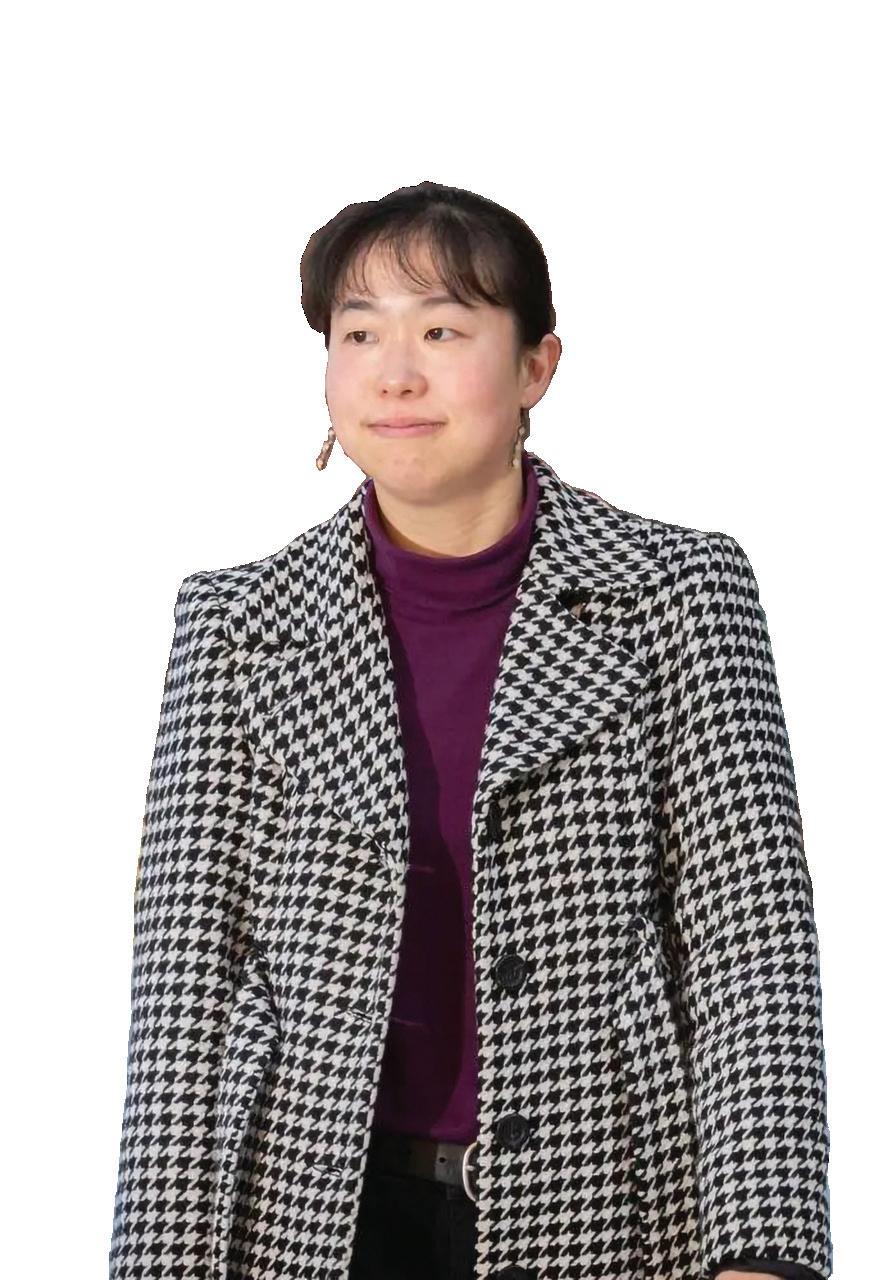
The goal isn’t to offer hard and fast prescriptions to build a specific kind of system in a specific location. Rather, the modeling will provide decisionmakers with a suite of ideal options to help them allocate their limited resources.
The next step is to beef up the hydrological modeling part of Tien’s framework in hopes of calculating a return-to-normal timeframe estimate after a storm event with different infrastructure approaches. Knowing the real-world performance of a particular solution, green or gray, would help flood-prone areas make informed choices.
“We’re building those probabilistic models to see, if you have a likelihood of this level of event, then with these different solutions, can we quantify what the benefit is of one versus another? I think it’s important to dig a bit deeper on the engineering side and actually produce numbers: it’ll take three days to return to normal or six hours or whatever the number might be,” Tien said. l
Story by Josh Stewart
Iris Tien
Civil engineer Iris Tien is helping coastal communities improve their resilience with the right flood-control infrastructure in the right places.
(Photo: Iris Tien)
(Photo: Getty Images)
The Secret ‘Sex Lives’ of Bacteria: New Research Challenges Old Ideas About How Species Form
By Catherine Barzler
W
hen Kostas Konstantinidis proved that many microbes — like plants and animals — are organized into species, he upended a long-held scientific belief. Scientists widely believed that bacteria, due to their unique genetic exchange mechanisms and the vast size of their global populations, did not — and could not — form distinct species.
New research from Konstantinidis and collaborators further challenges this notion, suggesting that not only do bacteria form species, but they also maintain cohesive species through a process that is somewhat “sexual.”
“The next question for us was how individual microbes in the same species maintain their cohesiveness. In other words, how do bacteria stay similar?” said Konstantinidis, the Richard C. Tucker Professor in Georgia Tech’s School of Civil and Environmental Engineering.

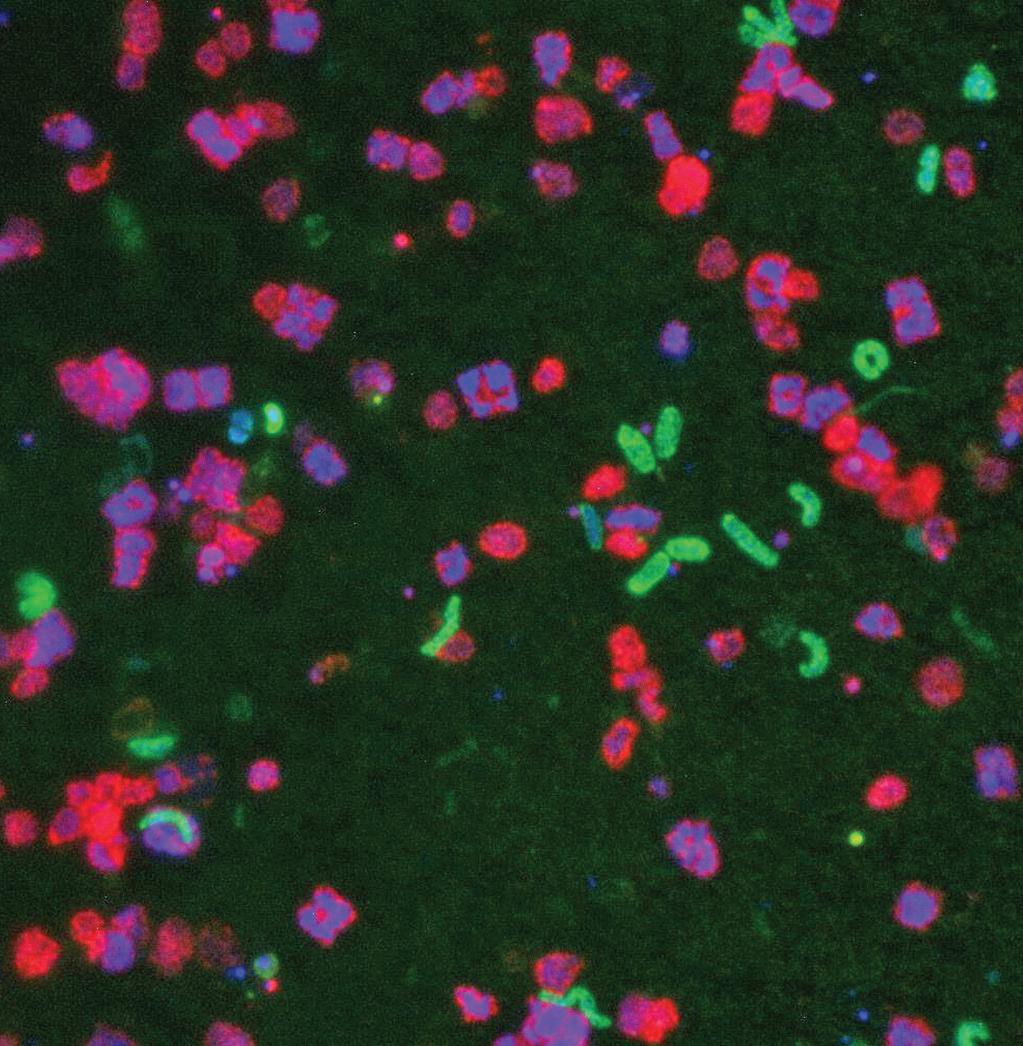
Bacterial and other microbes are thought to evolve primarily through binary fission, meaning asexual reproduction, while also engaging in infrequent genetic exchange. Using a novel bioinformatic method for detecting gene transfer, along with a new trove of whole genome data, Konstantinidis and an international team of researchers tested their hypothesis for how species emerge and are maintained. They found that bacteria evolve and form species more “sexually” than previously thought. Their research was published in the journal Nature Communications
To investigate how microbial species maintain their distinct identities, the team analyzed the complete genomes of microbes from two natural populations. They collected and sequenced over 100 strains of Salinibacter ruber (a salt-loving microbe) from solar salterns in Spain. Then they analyzed a set of previously published Escherichia coli genomes isolated from livestock farms in the U.K. They compared the genomes of closely related microbes to see how genes were being exchanged.
They found that a process called “homologous recombination” plays a major role in keeping microbial species together. Homologous recombination occurs when microbes exchange DNA with each other and integrate the new DNA into their genome by replacing their own similar DNA. They observed that recombination occurs frequently and randomly across the entire genome of microbes, and not just in a few specific regions.
“This may be fundamentally different from sexual reproduction in animals, plants, fungi, and non-bacterial organisms, where DNA is exchanged during meiosis, but the outcome in terms of species cohesion may be similar,” Konstantinidis said. “This constant exchange of genetic material acts as a cohesive force, keeping members of the same species similar.”
This work addresses a major, long-lasting problem for microbiology that is relevant for many research areas. That is, how to define species and the underlying mechanisms for species cohesion.
— Kostas Konstantinidis “ ”
The researchers also observed that members of the same species are more likely to exchange DNA with one another than with members of different species, further contributing to distinct species boundaries.
“This work addresses a major, long-lasting problem for microbiology that is relevant for many research areas,” Konstantinidis said. “That is, how to define species and the underlying mechanisms for species cohesion.”
This research has implications for several fields, from environmental science and evolution to medicine and public health, and offers valuable insights for identifying, modeling, and regulating clinically or environmentally important organisms. The methodology developed during the research also provides a molecular toolkit for future epidemiological and micro-diversity studies. l
Salinibacter ruber cells (green) under the microscope. Other colors represent different organisms in the saltern. (Photo: Tomeu Viver)
Georgia Tech Research Targets ‘Forever Chemicals’ in Drinking Water
Someday, your drinking water could be completely free of toxic “forever chemicals.”
These chemicals, called PFAS (perand polyfluoroalkyl substances), are found in common household items like makeup, nonstick cookware, dental floss, batteries, and food packaging. PFAS permeate the soil, water, food, and air, and they can remain in the environment for millennia. Once inside the human body, PFAS can persist for years, suppressing the immune system and increasing cancer risk.

By Anne Wainscott-Sargent Chen
Sewage Treatment Limitations
Conventional water treatment processes are ineffective at removing PFAS. Too often, traditional cleansing methods, such as using chlorine to kill pathogens in water, create harmful byproducts.
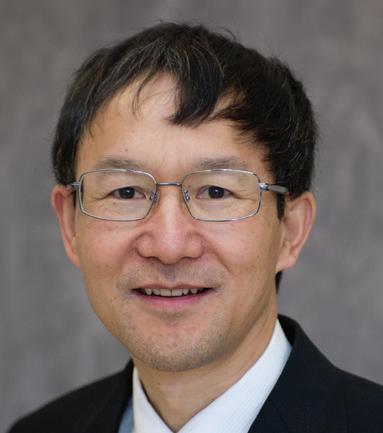
Georgia Tech researchers, armed with a cutting-edge machine learning (ML) model, are spearheading a multi-university initiative. Their goal? To design a better membrane that efficiently removes PFAS from drinking water, a significant source of human exposure.
“More than 200 million Americans in all 50 states are affected by PFAS in drinking water, with 1,400 communities having levels above health experts’ safety thresholds,” noted the study’s principal investigator Yongsheng Chen, Bonnie W. and Charles W. Moorman IV Professor in Georgia Tech’s School of Civil and Environmental Engineering. Chen also directs the Nutrients, Energy, and Water Center for Agriculture Technology, or NEW Center. “Our research aims to provide a scalable, efficient, and sustainable solution for mitigating these toxic chemicals’ impact on human health and the environment.”
The resulting work, funded with over $10 million in multiyear grants from the U.S. Department of Agriculture (USDA), the National Science Foundation, and the Environmental Protection Agency (EPA), was recently published in Nature Communications
“Solving one problem creates another problem,” said Chen. He has already used ML and artificial intelligence in precision agriculture to monitor nutrient levels in plants and insists that tackling PFAS removal similarly requires new approaches. Rather than treating an entire body of water, Chen’s team first separated PFAS from the water stream. Success depended on finding the right membrane material to isolate the chemicals in the water.
Chen relied on a team of 10 Ph.D. students and nine research scientists to perform the ML modeling. In addition to Georgia Tech, two other schools contributed people and laboratory expertise. The University of Wisconsin-Madison (UWM) validated the model with molecular simulations, while Arizona State University (ASU) trained it using data from scientific literature and their lab.
“Applying machine learning to membrane separation represents an exciting frontier for environmental engineering,” said Tiezheng Tong, an associate professor of environmental engineering in ASU’s School of Sustainable Engineering and the Built Environment.
This is another step in tackling PFAS pollution, a widespread problem that has recently received significant public attention due to PFAS’ toxic nature and the recent EPA ruling on PFAS in drinking water, he said.
“By integrating with molecular simulation tools, we can better understand PFAS transport across nanofiltration and reverse osmosis membranes, pushing the boundary of fundamental science relating to membrane separation,” Tong said.
Addressing PFAS Exposure in Agriculture
By addressing PFAS contamination, this research could also benefit the agriculture industry, which depends on fertilizer sourced from water treatment plants. Wastewater biosolids are processed into fertilizer, offering farmers and ranchers a cheaper alternative to chemical fertilizers. Unfortunately, PFAS-tainted fertilizers from sewage sludge have contaminated significant amounts of land and livestock. Industry groups estimate that almost 70 million acres of U.S. farmland could be contaminated by these forever chemicals.
By funding this research, the USDA hopes that an effective membrane will help the United States reclaim this crucial resource.
“Synthesizing a very smart membrane to get rid of PFAS also allows us to recover the fertilizer from municipal wastewater treatment plants,” Chen said. “Such a membrane could enable us to get rid of things we don’t want and keep the things we need, so we can keep the water for irrigation or other applications.”
Eliminating PFAS in fertilizers also could help address the mismatch of food and water demand in urban versus rural areas since 80% of the demand resides in cities. PFAS removal could directly support urban area resource recovery and food production.
“Our goal is achieving a circular economy where materials never become waste, and nature is regenerated,” Chen said. l
(Photo: Adobe Stock)
Using Hemp in Building Insulation Could Make Structures Greener, Create Jobs, and
Be a Profitable Industry
CEE researchers’ analysis outlines path to a U.S. construction market for hemp-based fibers, which are already used for clothing and biodegradable plastics.
By Josh Stewart
It’s a fairly niche product now, but a new study from Georgia Tech engineers suggests insulation made from hemp fibers could be a viable industry in the U.S., creating jobs, a manufacturing base, and greener homes and buildings at the same time.
Making the switch could slash the impact of one of the biggest sources of greenhouse gas emissions: Buildings account for roughly 1/5 of emissions globally. By some estimates, using hemp-based products would reduce the environmental impact of insulation by 90% or more.
The Georgia Tech researchers’ work, reported this month in the Journal of Cleaner Production, is one of the first studies to evaluate the potential for scaling up U.S. production and availability of hemp-based insulation products.
“Existing economic modeling studies were mostly limited to data on purchase price, finding that hemp insulation is more expensive than conventional installations. We wanted to go a different route, modeling from the industry’s perspective,” said Arjun Thangaraj Ramshankar, lead author of the study and an environmental engineering Ph.D. student. “The lack of studies also means lack of data, so our methods not only focused on economic modeling, but also on, how do you address the lack of data and still develop a fair model?”
Machine learning helped the team of civil and environmental engineering, public policy, and mechanical engineering researchers fill those gaps and uncover a promising market opportunity — despite fairly expensive raw hemp fibers, an underdeveloped supply chain, and still nascent demand.
Bottom line: Hemp insulation is a viable industry in the U.S., the researchers found. Sustaining it, though, will require a fairly high volume of sales and more of the product produced in the U.S.
Industrial production of hemp has picked up substantially since it was legalized by Congress in 2018. The fibers from the fast-growing plant can be turned into a variety of products, including clothing, rope, and biodegradable plastics. Construction materials using hemp — concrete, plaster, and insulation, among them — are gaining popularity as a way to reduce the carbon impact of buildings, especially in Europe.
Hemp insulation can directly replace fiberglass products in residential and commercial buildings, but it currently costs about twice as much.
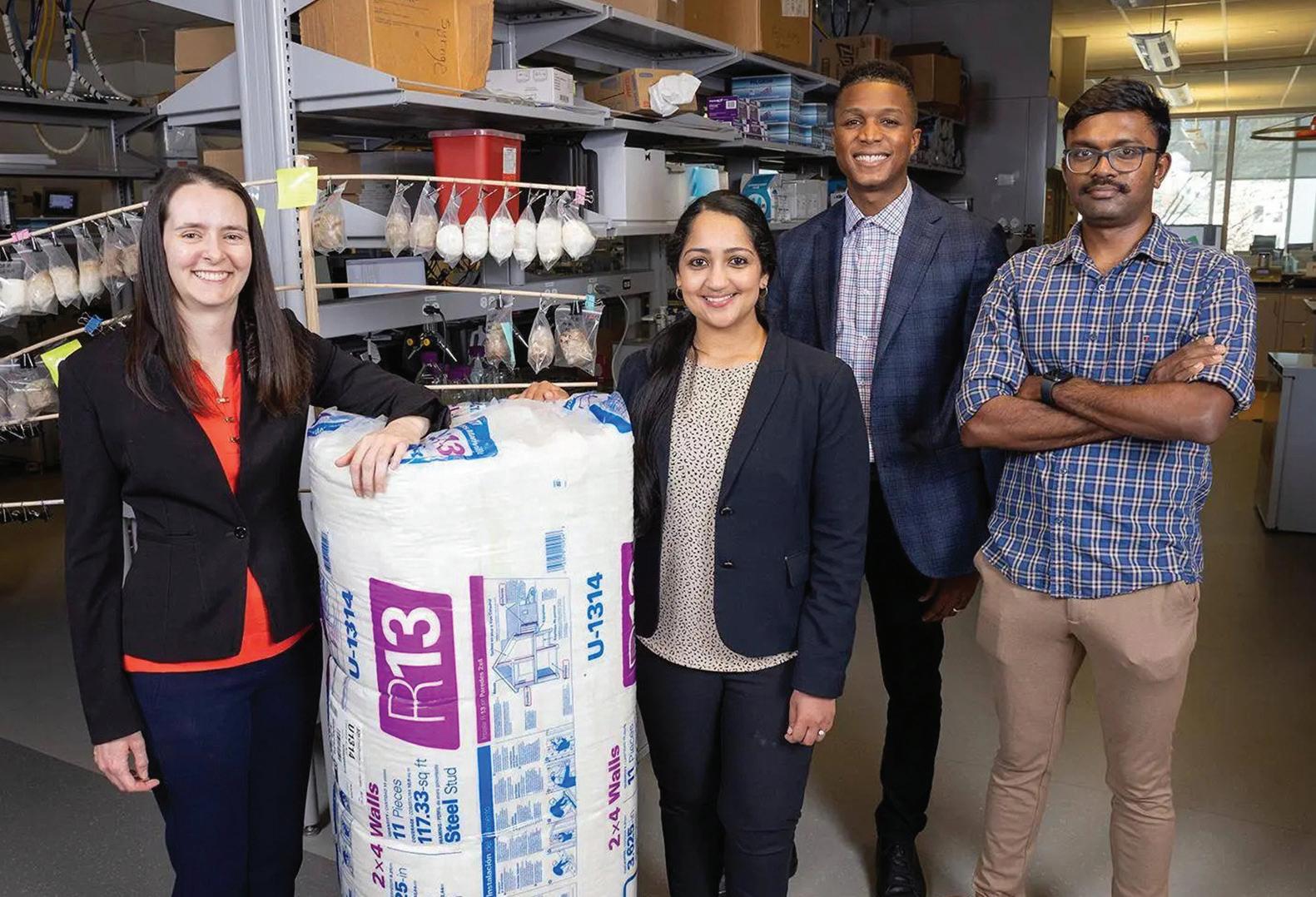
Senior coauthor Joe Bozeman said the team’s study suggests well-placed incentives could jump-start the industry, helping subsidize production capacity while demand grows.
“This could be a really mutually beneficial marketplace for everyone,” said Bozeman, assistant professor in the School of Civil and Environmental Engineering. “We get less embodied carbon in buildings, a new industry, new jobs, and then there’s a lot of opportunity for technological advancements on the back of this market viability.”
Bozeman also said marrying the emerging market for hemp insulation with the shortage of housing in the U.S. could mean real opportunity to address two issues simultaneously.
“We could have a really, really interesting dynamic: Some of the newer houses could have less embodied carbon by using this hemp insulation, which could also jump start the market,” he said. “This is something federal or state legislation can address.”
Along with graduate student Kelly Farmer and mechanical engineering Assistant Professor Akanksha Menon, Ramshankar and Bozeman performed what they called a techno-economic analysis to assess whether there’s opportunity to develop a market for the insulation. It’s an approach that will have broader uses in Bozeman’s lab — including projects on reducing the carbon footprint of concrete, recycling lithium from electric vehicle batteries, and reusing nutrients and filtering out “forever chemicals” like PFAS in wastewater.
“We used hemp insulation as our material for this study, but the broader goal was developing a framework for any alternative that you’re considering,” Ramshankar said. “With this method, you can assess economic viability for any material being considered as a potential alternative.” l
From left, Kelly Farmer, Akanksha Menon, Joe Bozeman, and Arjun Ramshankar with a package of traditional fiberglass insulation and a rack holding samples of potential hemp-based insulation materials created by graduate student Elyssa Ferguson in Menon’s lab. (Photo: Candler Hobbs)
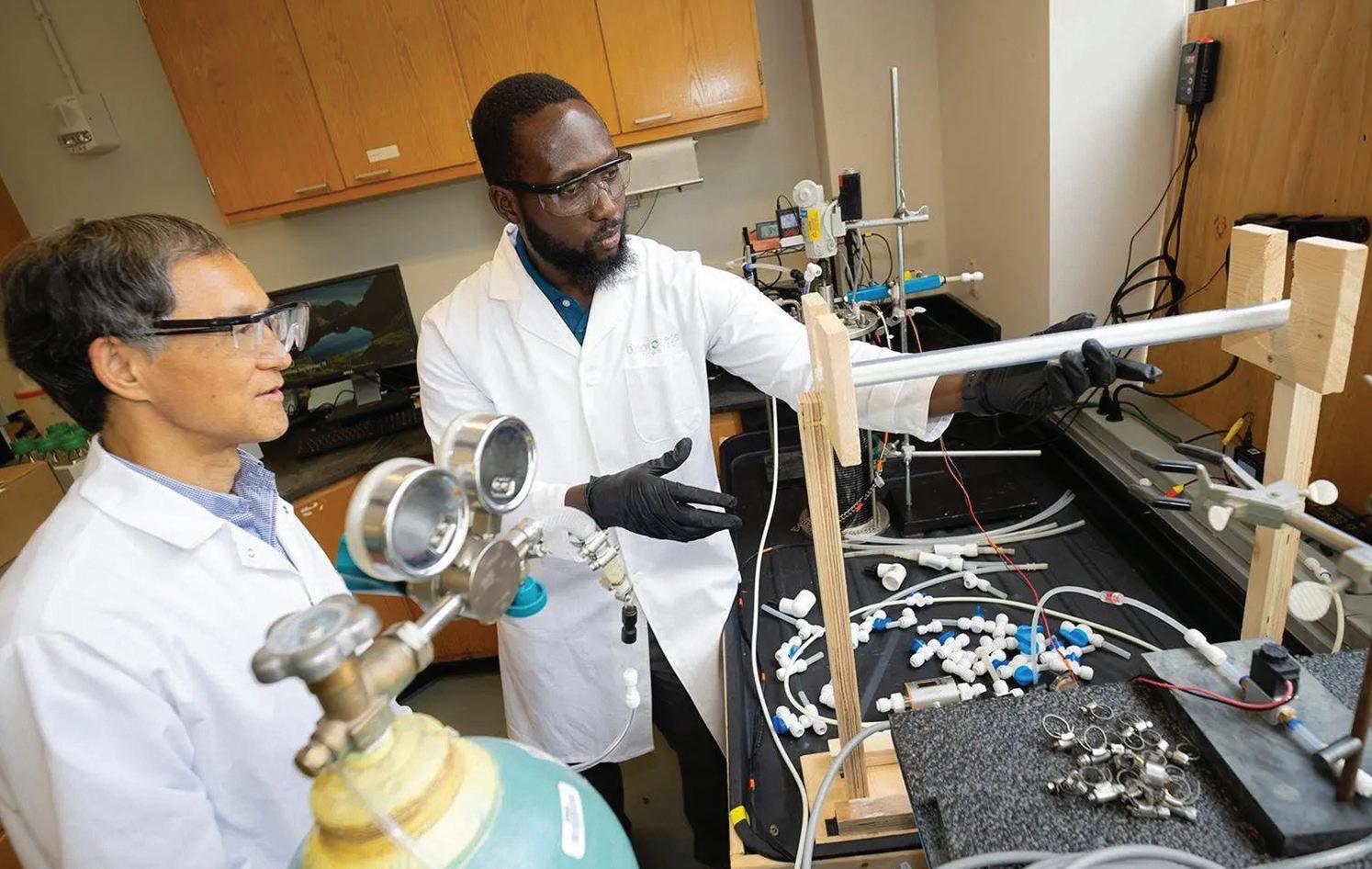
‘Biochar’ Can Naturally
Clean the Pollution that Rain Washes Off Georgia’s Roads
A new study shows how the material made from leaves and branches that collect on forest floors can be mixed with local soil to filter out road grime before it reaches waterways.
By Josh Stewart
Acharcoal-like material made from leaves and branches that collect on forest floors could be a cheap, sustainable way to keep pollution from washing off roadways and into Georgia’s lakes and rivers.
Engineers at Georgia Tech and Georgia Southern University have found that this biological charcoal, or biochar, can be mixed with soil and used along roadways to catch grimy rainwater and filter it naturally before it pollutes surface water.
Their tests found the biochar effectively cleans contaminants from the rainwater and works just as well in the sandy soils of the coastal plain as in the clays of north Georgia. Their biochar-soil mixture can be easily substituted for expensive material mined from the earth that’s typically used on roads.
Though they focused on Georgia, the researchers said the findings could easily apply across the U.S., providing a simple, natural way to keep road pollutants out of water sources. They published their approach in the Journal of Environmental Management
“The road surface accumulates a lot of pollutants. Then, when it rains, everything is washed into our rivers and surface water bodies,” said Ahmed Yunus, Ph.D. student in the School of Civil and Environmental Engineering (CEE) and a Renewable Bioproducts Institute fellow who was lead author on the study. “When it rains, our system captures the stormwater and reduces the amount of runoff pollutants, stopping them from accumulating in surface water.”

The biological charcoal (above) can be mixed with soil to naturally filter roadway pollutants.
Roads collect all kinds of contaminants — deposits from vehicle emissions, dust from brake rotors, oil, and grease, among them. The longer between rainstorms, the more gunk that builds up.
The researchers mixed biochar in varying amounts with topsoil from different parts of Georgia. The material accelerates natural processes that would typically absorb and filter water, including encouraging growth of helpful microbes to break down pollutants captured by the material. And because it’s made from the detritus that collects on forest floors, it’s a plentiful material.
“We have a lot of forest residues, meaning that sourcing the raw material is not a problem,” Yunus said. “So we can use an abundant natural resource to create a process that actually protects another resource, our surface water.” l
Professor Yongsheng Chen (left) and Ph.D. student Ahmed Yunus work with a wastewater reactor system in the lab.
(Photo: Candler Hobbs)
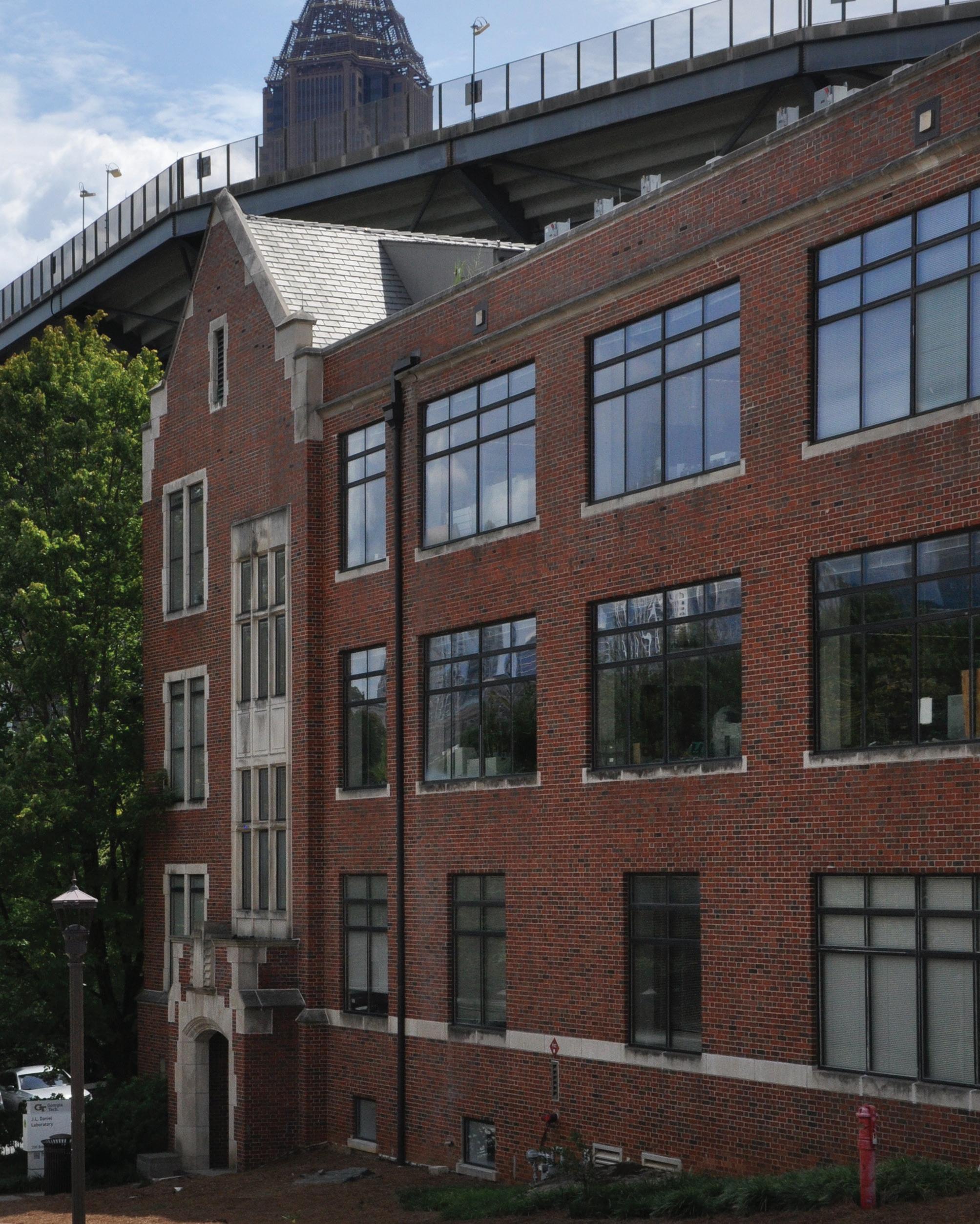
EXCELLENCE A Community of
GSPE AWARDS
Eric Marks named Engineer of the Year in Education
Professor of the Practice Eric Marks has been selected as the 2025 Engineer of the Year in Education by the Georgia Society of Professional Engineers.
Marks works with the Construction and Infrastructure Systems group and is a licensed Professional Engineer in the state of Kentucky.
“This award and my career are reflections of a long list of people that have motivated, challenged, and encouraged me which undoubtedly includes my students, my colleagues and my Institute’s leadership,” Marks said. “It’s an honor to teach Georgia Tech students about the civil engineering industry and inspire them to build and leverage their skill sets to create solutions for the increasingly complex problems our industry faces.”
In addition to his teaching duties, Marks co-manages the school’s Corporate Affiliates Program, where companies build relationships with students through mentoring programs, presenting in classes and providing access to visit their construction sites.
Before arriving at Tech, Marks was an assistant professor in the Department of Civil, Construction and Environmental Engineering at the University of Alabama. As a practicing engineer, he managed capital-intensive transportation infrastructure construction projects for the Kentucky Transportation Cabinet.
At Tech, Marks has been consistently popular with students. He has been recognized with many teaching awards, including the Student Recognition of Excellence in Teaching: Class of 1934 CIOS Award in 2022 and the Class of 1940 Course Survey Teaching Effectiveness Award in 2018, just a year after joining the School of Civil and Environmental Engineering faculty as full-time faculty.
“Throughout many teaching positions and student experiences, I have found effective teachers to possess several core principles,” Marks said of his teaching philosophy. “Highlymotivated teachers are able to cultivate and quickly spread their passion for a subject throughout the classroom.”
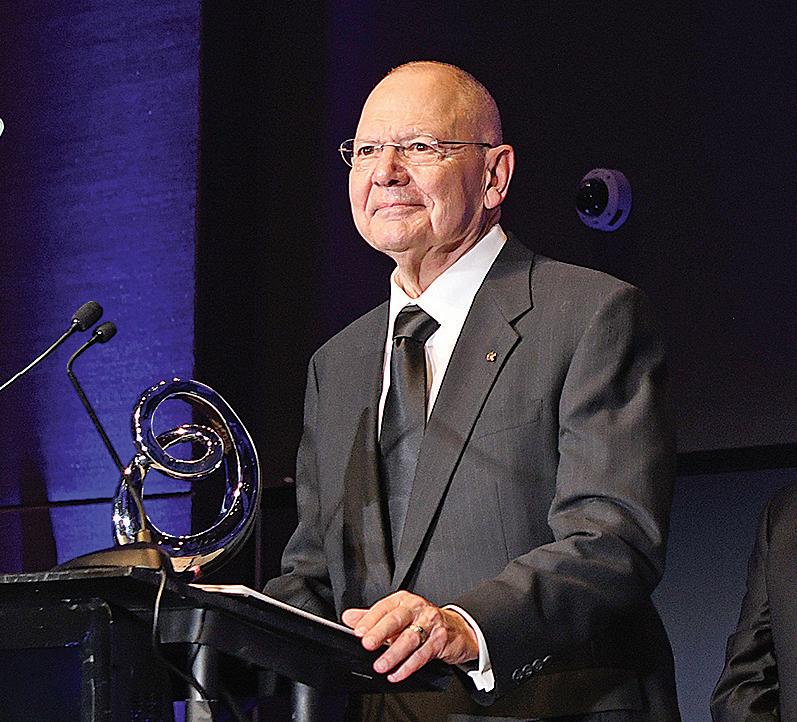
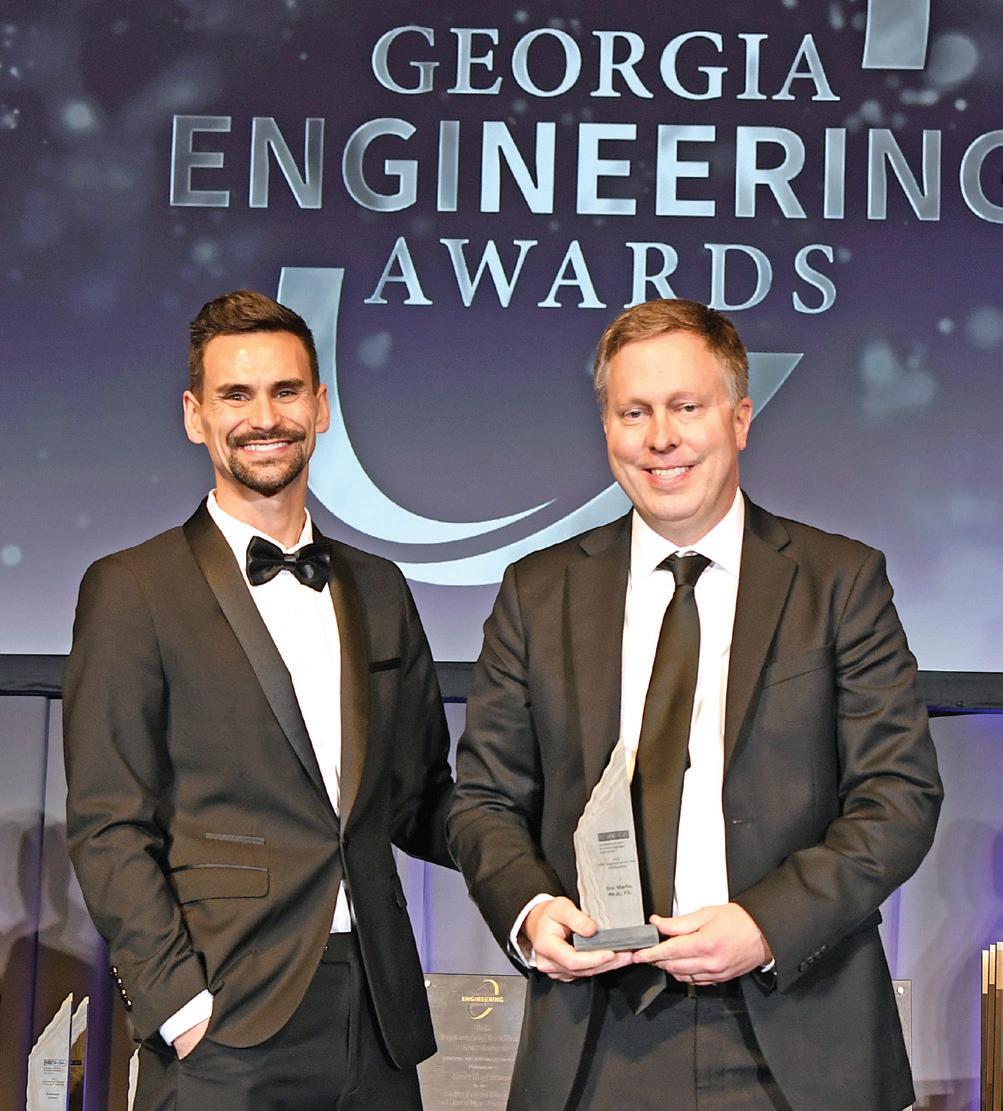
Karen and John Huff Chair Don Webster congratulated Marks on becoming one of the most beloved instructors within the School of Civil and Environmental Engineering.
“He has developed many innovative programs to help the professional development of our undergraduate and graduate students, including developing innovative curriculum in the Construction Engineering area and forged connections with industry and public-sector partners,” Webster said. “His passion for teaching and efforts to support our students beyond the classroom makes him an outstanding recipient of the GSPE Engineer of the Year in Education Award.” l
GSPE Honors Lawrence Kahn with Lifetime Achievement Award
Professor Emeritus Lawrence Kahn was awarded the Lifetime Achievement Award from the Georgia Society of Professional Engineers. Kahn retired from Georgia Tech in 2015 after 40 years of service. He remains a professor emeritus, advising graduate students and teaching occasionally. Throughout his career, he taught structural engineering courses including structural analysis, reinforced concrete, prestressed concrete, masonry, and senior design. Among the awards and honors he received during his career are Educator of the Year from the Precast/Prestressed Concrete Institute and the Class of 1940 W. Howard Ector Outstanding Teacher Award from Georgia Tech’s Faculty Honors Committee. l
CEE Recognized for Excellence as an Employer
The School of Civil and Environmental Engineering has been named the Public Sector Employer of the Year by the Georgia Society of Professional Engineers (GSPE).
The recognition is one of the organization’s 2025 Engineer of the Year Awards.
“We are truly honored to receive this recognition from GSPE,” said Karen and John Huff School Chair Don Webster. “This award underscores our commitment to providing an exceptional experience not only for students, but for the incredible faculty and staff who make our highly ranked civil and environmental engineering programs possible.”
GSPE Executive Director Amanda Hendley said that the School’s dedication to continuous learning and career development is a key reason why CEE is so deserving of this recognition.
“As a leader in engineering education, Georgia Tech’s School of Civil & Environmental Engineering sets a standard for professional growth and development,” Hendley said. “Their commitment to faculty and staff advancement—through mentorship, leadership training, conference support, and even financial incentives for professional licensure—ensures that their team remains at the forefront of innovation.”
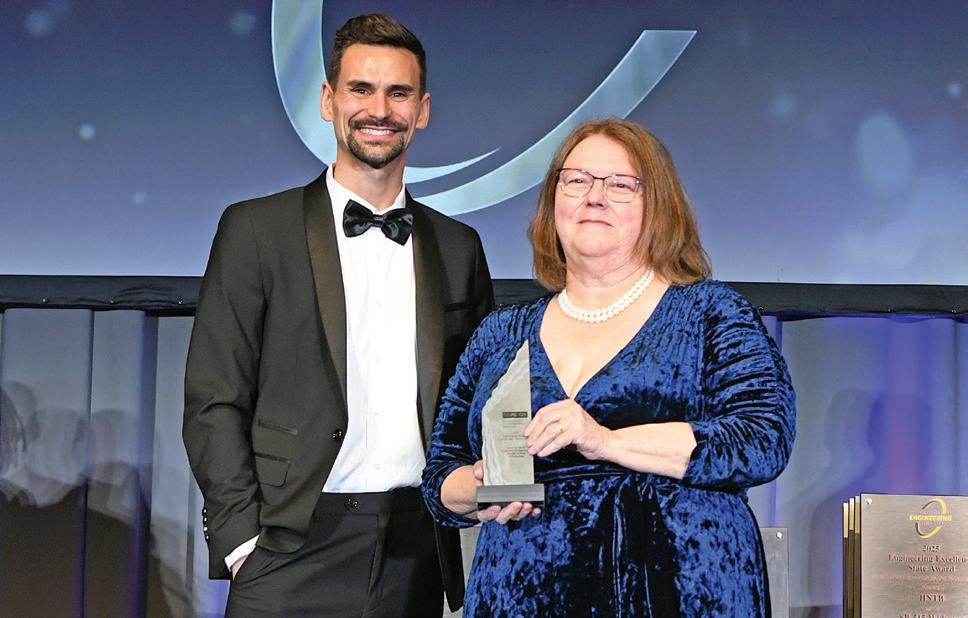
The award was presented at the 2025 Georgia Engineering Awards Gala on March 7. This annual event celebrates the achievements of Georgia’s engineering professionals and companies, providing an opportunity to recognize excellence across the state. l
ASCE FELLOWSHIPS
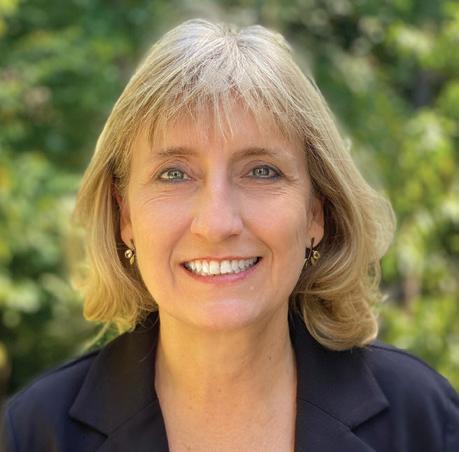
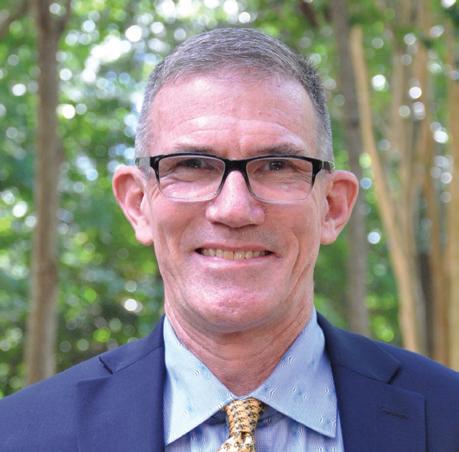
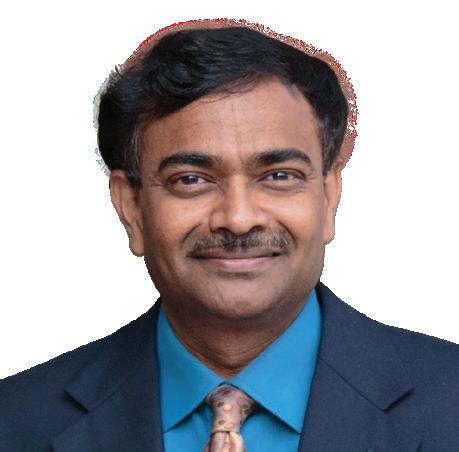

Four Faculty Members Elected ASCE Fellows
Professors of the Practice Sharon Just and Fred Meyer, Frederick R. Dickerson Chair and Professor Srinivas Peeta, and Professor Don White were elected Fellows of the American Society of Civil Engineers. ASCE Fellows have made celebrated contributions and developed creative solutions that change lives around the world. It is a prestigious honor held by 3% of ASCE members.
Interim Associate Vice President for Research Operations & Infrastructure Susan Burns accepts the award for Public Sector Employer of The Year. (Photo courtesy GSPE)
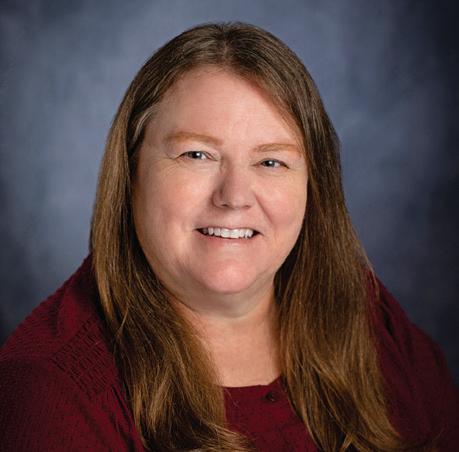
Susan Burns Elected VP of ASCE Geo-Institute
Dwight H. Evans Professor Susan Burns was elected Vice President and President-Elect of the ASCE Geo-Institute. The Geo-Institute is a membership organization focused on the geo-industry. It is one of several specialty institutes that are part of the American Society of Civil Engineers. Burns also serves as Georgia Tech’s interim Associate Vice President for Research Operations and Infrastructure. Her research focuses on applications in geoenvironmental engineering, with emphasis on the beneficial use of waste materials.
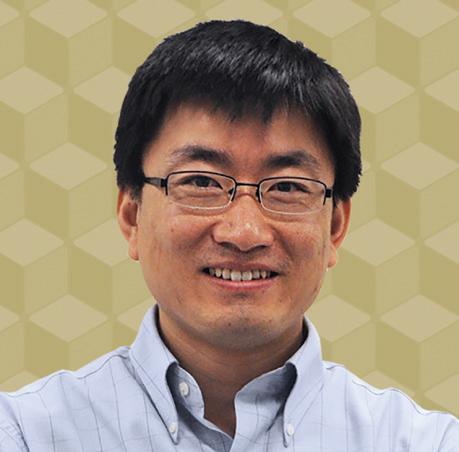
Sheng Dai Wins 2025 USUCGER Early Career Researcher Award
Georgia Mining Association Early Career Professor Sheng Dai won the 2025 Early Career Researcher Award from the United States Universities Council on Geotechnical Education and Research (USUCGER). The USUCGER Board bestows this award once every two years to an affiliate who has made significant and innovative contributions to research, creative accomplishment, and scholarship in the field of geotechnical engineering. Dai's research addresses the resilience and sustainability in energy and the natural environment through studying energy geotechnics and nature-inspired engineering.
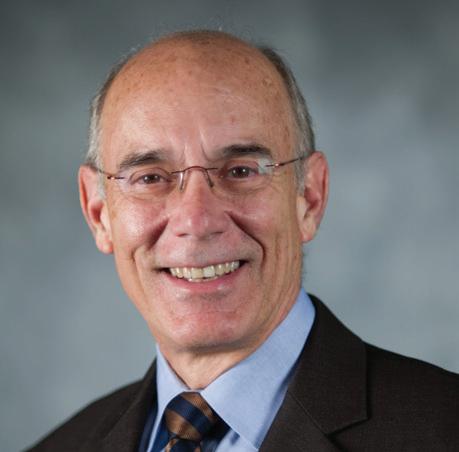
Bras Wins ASCE Outstanding Projects And Leaders Award
K. Harrison Brown Family Chair and Professor Rafael Bras was awarded ASCE’s Outstanding Projects And Leaders (OPAL) Award. Bras was selected for the award in the education category for demonstrated excellence in furthering civil engineering education. Bras is the former provost and executive vice president for academic affairs at Georgia Tech. He is currently a professor in the School of Civil and Environmental Engineering and the School of Earth and Atmospheric Sciences.
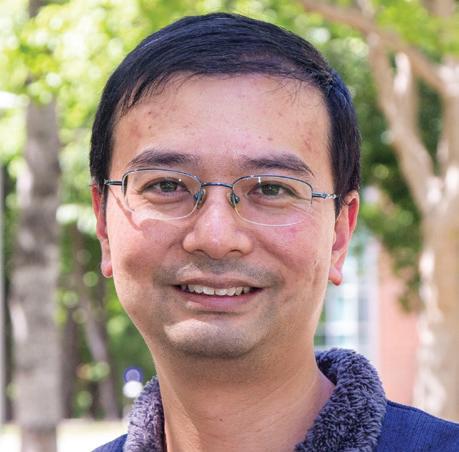
Xing Xie Awarded ASCE Research Prize
Carlton S. Wilder Early-Career Professor Xing Xie received the ASCE Walter L. Huber Research Prize. This award recognizes researchers who are under 40 or have worked no more than 12 years since receiving their doctoral degree. Recipients are selected based on the impact of their research, both on their chosen subdisciplines, as well as on the field of civil engineering more broadly.
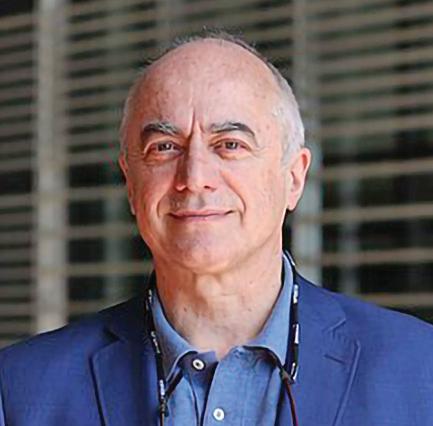
Santamarina Selected as Cross-USA Lecturer
G. Wayne Clough Chair and Professor J. Carlos Santamarina has been chosen the 20252026 Cross-USA Lecturer by the Geo-Institute of the American Society of Civil Engineers. Santamarina will spend the year traveling the country to share his expertise with geotechnical engineers and engineering students. The Geo-Institute selects a “distinguished geoprofessional” for the lecture tour each year, based on their “prestige in the geoprofessional community, professional achievements, and lecture abilities.”
Santamarina has guided nearly 70 Ph.D. students—46 of whom now hold academic positions at leading universities around the world—as well as 24 postdoctoral researchers, 22 master’s students, and numerous undergraduate researchers.
CEE Professors Receive Award for Excellence in Teaching
Faculty members at Georgia Tech who make The Center for Teaching and Learning (CTL) and the Office of Academic Effectiveness (OAE) Honor Roll have been celebrated by their students for outstanding teaching and educational impact. Students overwhelmingly praised these educators for their excellent teaching methods and dedication to student success. Nine CEE faculty were selected for the honor roll in the 2024-25 academic year.
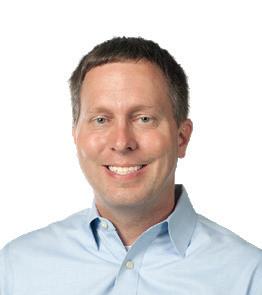
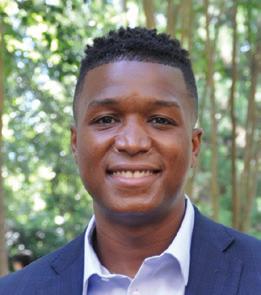
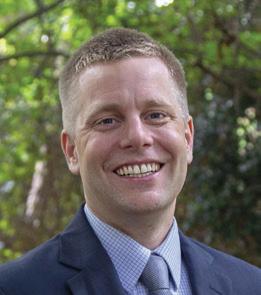
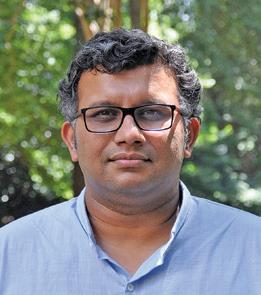
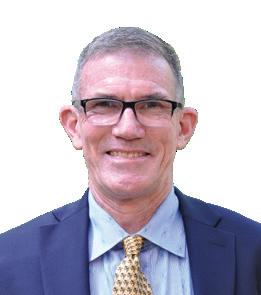
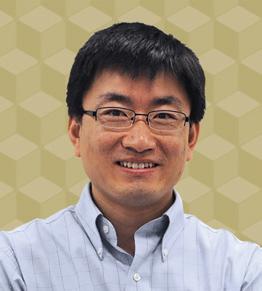

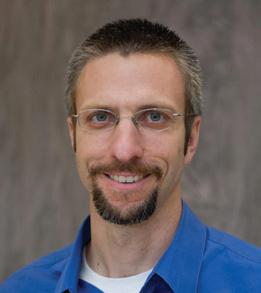
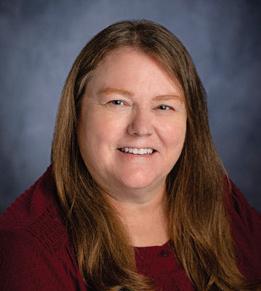
College of Engineering – Small Classes
l Eric Marks, recognized for CEE 6130: Construction Project Controls
l Joe Bozeman, recognized for CEE 6355: Industrial EcologyEnvironmental Engineering
l Ryan Sherman, recognized for CEE 8813: Special Topics: Behavior of Metal Structures
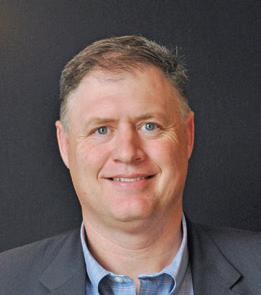
College of Engineering – Small Classes
l Ameet Pinto, recognized for CEE 6331: Biological Processes
l Fred Meyer, recognized for CEE 6523: Prestressed Concrete
l Sheng Dai, recognized for CEE 4803: Special Topics: Nature-Inspired Engineering
l Todd Long, recognized for CEE 6605: Transportation Administration & Policy
College of Engineering – Large Classes
l Eric Marks, recognized for CEE 6160: Safety Engineering
l Kevin Haas, recognized for CEE 4225: Coastal Engineering
l Susan Burns, recognized for CEE 3400: Intro to Geotech Engineering
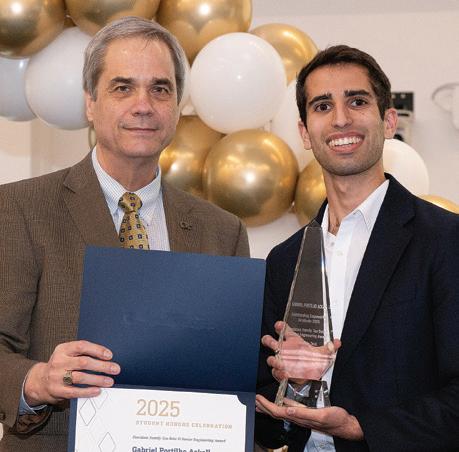
Gabriel Ackall Selected for 2025 Davidson Family Tau Beta Pi Senior Engineering Award
The award is the most prestigious award for undergraduate engineering students at Georgia Tech. In addition to maintaining a 4.0 GPA, Ackall was active on campus in student groups and research initiatives. As an assistant researcher for the Re-Wind Network, Ackall helped to design North America's first pedestrian bridges using repurposed wind turbine blades.
He also served as the design lead for the Georgia Tech team of the Student Steel Bridge Competition, an annual competition that challenges student teams to design, fabricate, and assemble a scale-model steel bridge. Ackall was also active with Georgia Tech’s chapter of the American Society of Civil Engineers and the Structural Engineering Institute.
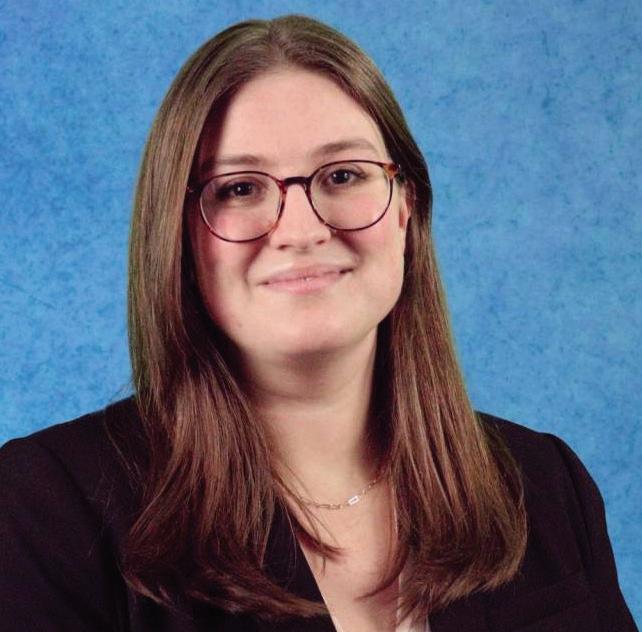
Hannah Kessler Named Outstanding Young Professional
The American Institute of Steel Construction’s (AISC) Education Foundation awarded its 2025 Reidar Bjorhovde Outstanding Young Professional Award to PhD student Hannah Kessler. Kessler intends to become a structural engineering faculty member after finishing her PhD. Her research concerns understanding the material, fatigue, and connection performance of wire arc additively manufactured (WAAM) steels through experimental testing so that WAAM can be implemented into building and bridge structures.
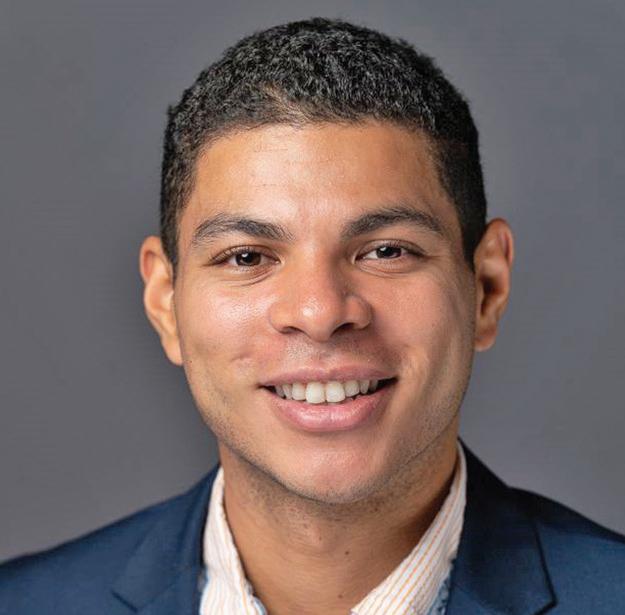

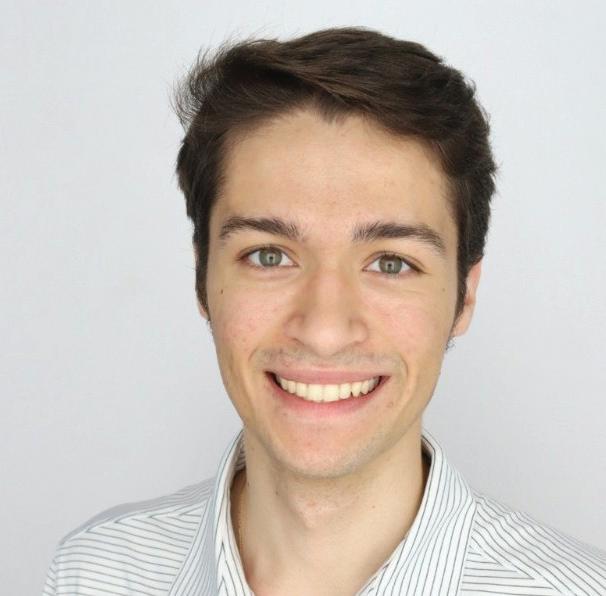
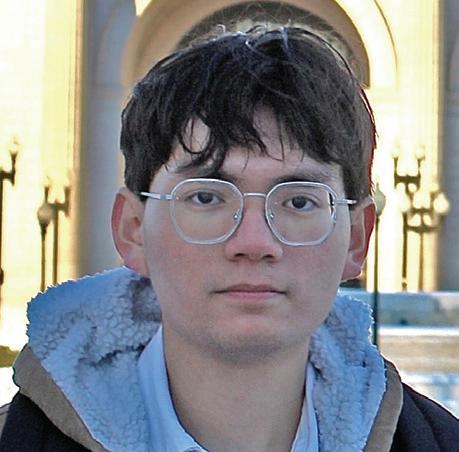
Four Graduate Students Earn Dwight D. Eisenhower Fellowships
The Federal Highway Administration’s prestigious fellowship program awards research grants to graduate students pursuing transportation-related degrees. The program’s mission is to “attract the nation’s brightest minds to the field of transportation, encouraging future transportation professionals to seek advanced degrees, and helping to retain top talent in the U.S. transportation industry.”
This year’s winners are creating innovative solutions to pressing infrastructure and transportation concerns:
l CHRISTIAN DOUGLAS is studying how vehicle automation technology (advanced driver-assistance systems to fully autonomous vehicles) contributes to individual usability.
l ADAIR GARRETT is researching approaches to build climate resilience for passenger rail systems through improved measurement, adaptation, and educational interventions.
l TULIO SULBARAN’s research is in customer willingness to pay and price elasticity in the airline industry.
l TONY TAN’s research is related to transportation safety and utilizing emerging technologies to automatically assess road conditions and provide recommendations to improve safety.

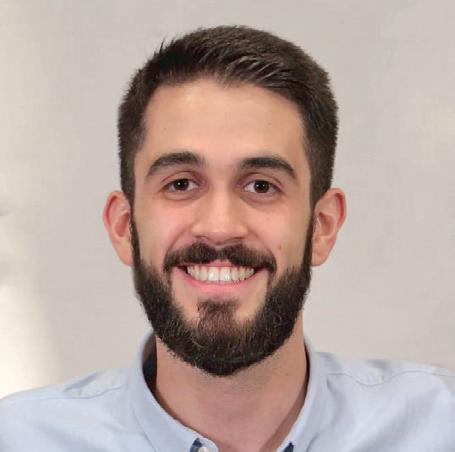
Harrison Baro Selected as Ramblin’ Royalty honoree
Baro was selected as one of two 2024 Ramblin’ Royalty honorees following a vote by Georgia Tech students. Formerly known as Mr. And Ms. Georgia Tech, the program recognizes two students each year for their exceptional academic pursuits, campus engagement, and leadership roles. Baro, an environmental engineering student, has been active across campus. He served as the Student Government Association (SGA) executive vice president, president of Student Ambassadors, and a member of the Phi Gamma Delta fraternity.
Gabriel Cedraz Diniz Receives $12,000 Research Stipend from the FAA for Aviation Industry Research
Cedraz Diniz was recognized by the Graduate Research Award Program on Public-Sector Aviation Issues for his research paper entitled “From Disruptions to Recovery: The U.S. Airline Industry Landscape in 2024.” According to Cedraz Diniz, while several papers have examined the impact of flight operations during the pandemic, little research has been done examining how air service has changed since the industry has returned to pre-pandemic travel levels. “This study will provide an in-depth and airport-specific assessment of how scheduled air service, passengers’ volumes, and airfares have changed for U.S. airports during its recovering phase and show how air service today is different than in 2019 and will quantify how service reductions have disproportionately impacted smaller communities,” he said.

Caroline Muhith Wins $5,000 Scholarship from WTS
The Atlanta chapter of WTS awarded the Helene M. Overly Memorial Scholarship to Ph.D. student Caroline Muhith. WTS — originally known as Women’s Transportation Seminar — awards scholarships each year to help develop women who plan to pursue transportation careers and reward promising young engineers. Muhith is in the first year of her graduate program in transportation engineering, working with Professor Laurie Garrow and the Air Transportation Lab at Georgia Tech (ATL@GT). Muhith became involved with the WTS Heart of Texas chapter while pursuing a B.S. in civil engineering at the University of Texas at Austin. She serves as the secretary of the WTS Atlanta chapter and led a traffic demand management project for the chapter.
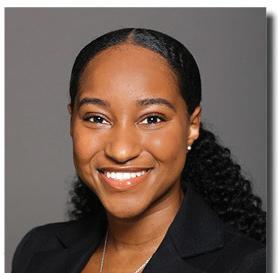
Daraja Brown Selected As Commencement Speaker
A Stamps President’s Scholar, Daraja Brown served as a member of the American Society of Civil Engineers and captain of the Timber-Strong Design Build team. Through Engineers Without Borders, she participated in international aid projects and was a sub-team lead on the Building for Equity and Sustainability Vertically Integrated Project.
“What ties everyone here together is not just wearing the same gown, but that we all are passionate about something, and we dedicate ourselves to living out those passions,” she said. “I urge you to use what you’ve gained as a student here and apply it for the benefit of those around you. In five, 10, or 50 years, I hope you continue to reflect on what it truly means to be a Yellow Jacket.”
CEE Graduates Honored with Engineering Alumni Awards
Three Civil and Environmental Engineering Alumni were selected for honors by Georgia Tech’s College of Engineering at the 2025 Alumni Awards Induction Ceremony.
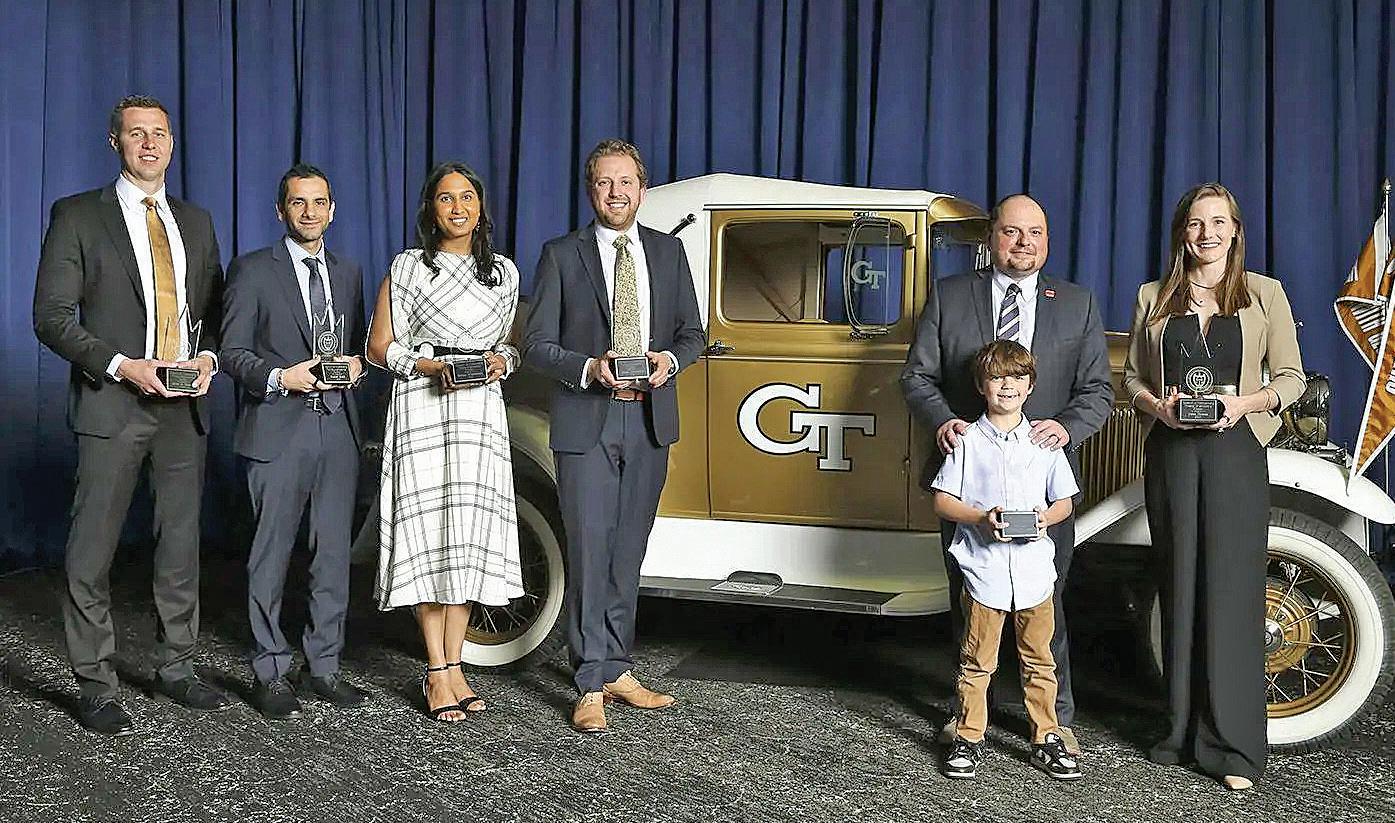
Robert D. Moser, CE 07, MS CE 09, PhD CE 11
Director, Senior Executive Service, U.S. Army Engineer Research and Development Center Council of Outstanding Young Engineering Alumni
Robert Moser is the director of the Army’s Information Technology Laboratory (ITL), where he oversees the development and execution of a broad range of research and development (R&D) and operational programs on behalf of the U.S. Army Corps of Engineers, the Army, the Department of Defense (DOD), and other federal agencies.
H. Arthur (Art) Williams, CE 83
Vice Chairman and COO, Williams Industries, Inc., Williams Enterprises of Georgia Academy of Distinguished Engineering Alumni
Art Williams has worked at Williams Industries and Williams Enterprises for more than 40 years. Williams Industries in Manassas, Virginia, and Williams Enterprises in Smyrna, Georgia, are the 10th largest steel specialty contractor in the country, focusing their efforts on steel erection and fabrication in the mid-Atlantic and Southeast.
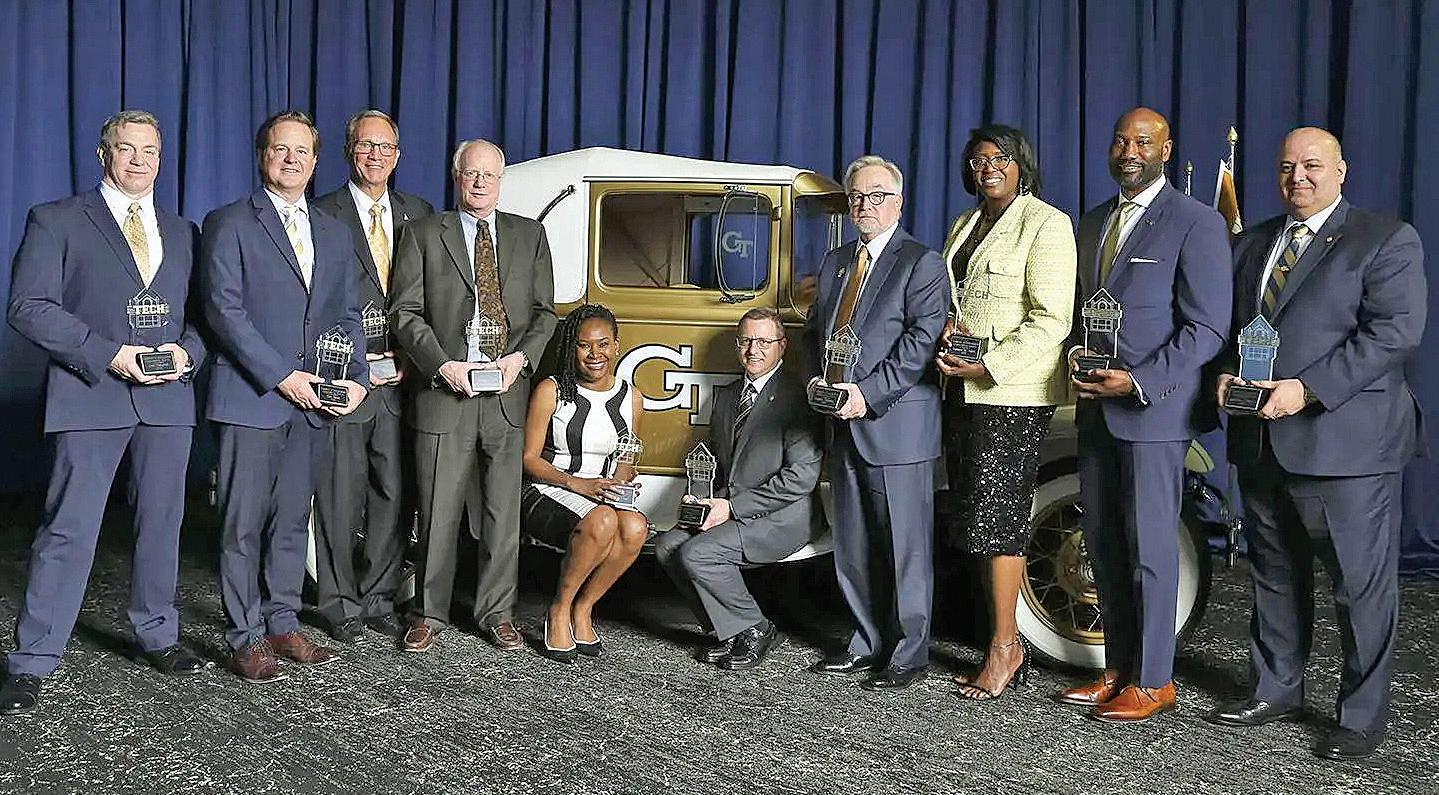
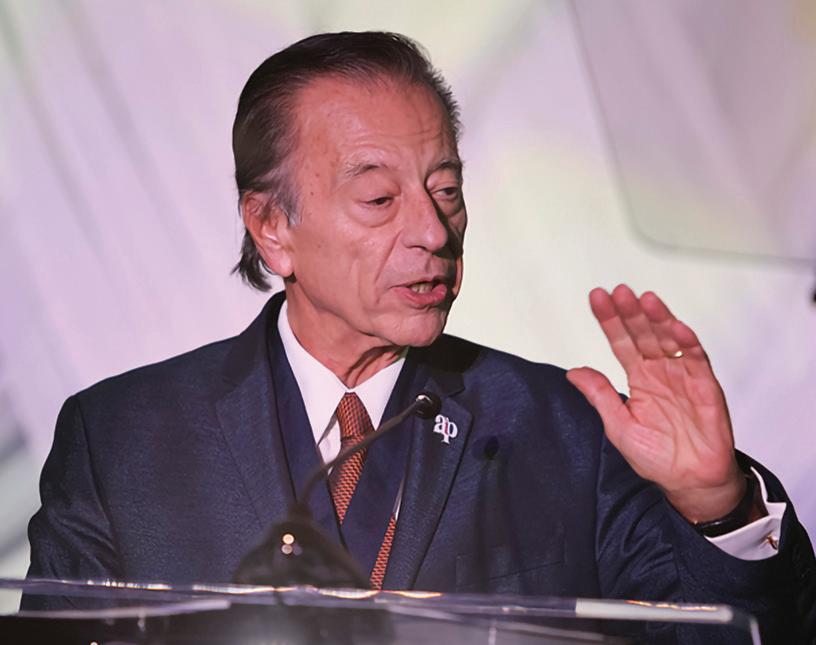
José Domingo Pérez, CE 71
President, Caribe Tecno, Inc., Pan American Academy of Engineering
Engineering Hall of Fame
A year after graduating from Georgia Tech, José Domingo Pérez founded Caribe Tecno, Inc., a firm recognized for sustainable resilient infrastructure and building, development, design-build, and construction. The company has built more than a billion dollars’ worth of projects over the last 50 years, including national and international award-winning landmarks.
Robert D. Moser, with his son holding the trophy, poses with fellow inductees of the Council of Outstanding Young Engineering Alumni.
Art Williams, fourth from the left, poses with fellow inductees to the College of Engineering’s Academy of Distinguished Engineering Alumni.
(Photos by Candler Hobbs)
3 Alumni Honored By Georgia Society of Professional Engineers
The organization’s Engineer of the Year Awards celebrate the achievements and contributions of Georgia’s engineering professionals and companies that have demonstrated exceptional skill, innovation, and dedication.
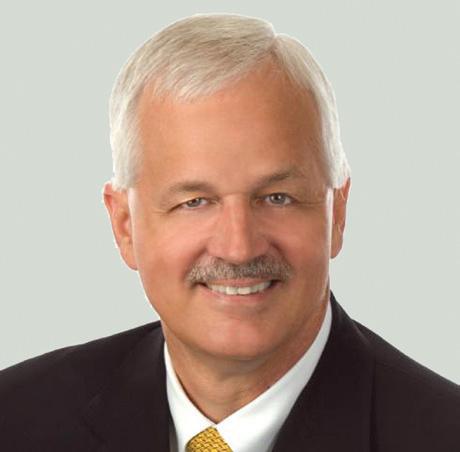
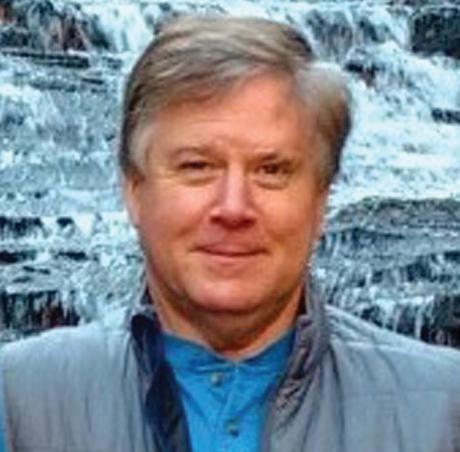
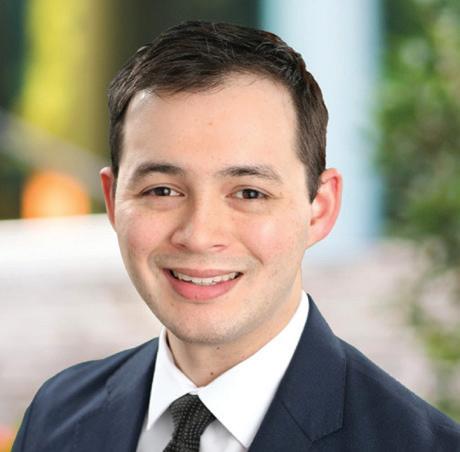
Thomas Gambino | CE 79
Lifetime Achievement in Engineering
Thomas Gambino is the founder of Prime Engineering and an emeritus member of the School of Civil and Environmental Engineering’s External Advisory Board. He has over 40 years of engineering, design, and construction experience and is a registered engineer in 28 states and Puerto Rico.
William (Billy) Anderson Brundage III | CE 85
Engineer of the Year in Industry
Billy Brundage has over 30 years of experience in dam engineering and civil engineering consulting. His areas of expertise include dam safety, site development design, land planning, and hydrology. He has worked for Southern Company since 2013 and he currently serves as principal engineer.
Samuel Dennard | CE 18
Engineering Organization Volunteer of the Year
Sam Dennard is a transportation engineer specializing in roadway design for Columbia Engineering. He began his career with Pond & Co. after graduating from Georgia Tech in 2018. GSPE has recognized him for his volunteer efforts with the American Society of Civil Engineers Georgia Younger Members group.
Erin Robinson Selected for New Faces of Civil Engineering
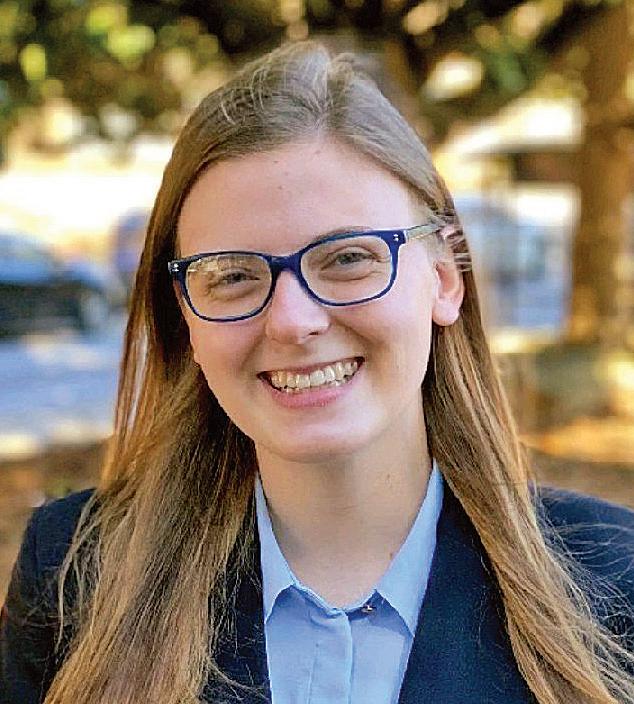
Robinson, CE 22, is one of 10 exceptional civil engineers from around the world under age 30 selected by the American Society of Civil Engineers for its 2025 class of New Faces of Civil Engineering – Professional. Robinson is a water engineer for Arcadis focusing on stormwater design and resiliency planning. She is active in volunteering and mentoring programs and hopes to inspire others to give back. For the past two years, she has worked with a group that developed a nationally applicable GIS model that ranks watersheds based on the impact that installing trash traps would have both in terms of quantity of trash removed and the level of environmental justice achieved.
3 Selected for Alumni Association’s 40 Under 40
The Georgia Tech Alumni Association’s 2025 Class of 40 Under 40 celebrates the inspiring work of Yellow Jackets around the globe. Honorees must have completed at least one semester at Georgia Tech and be under the age of 40 as of June 30, 2025.
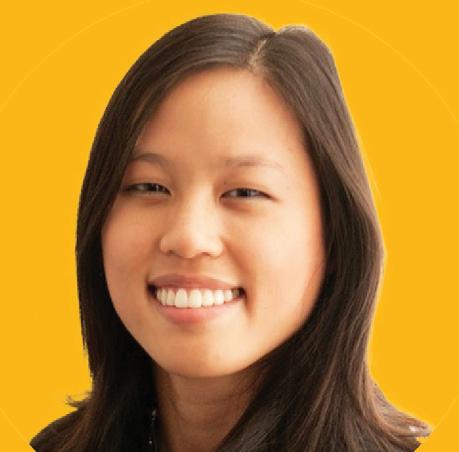
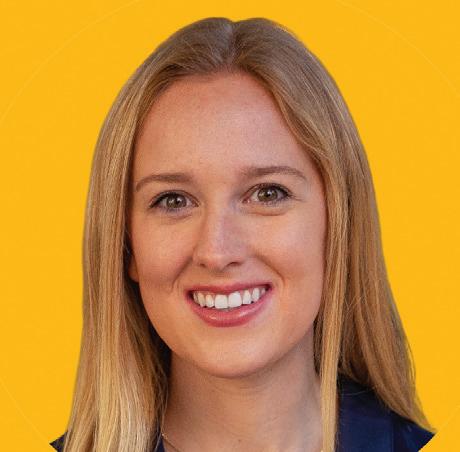
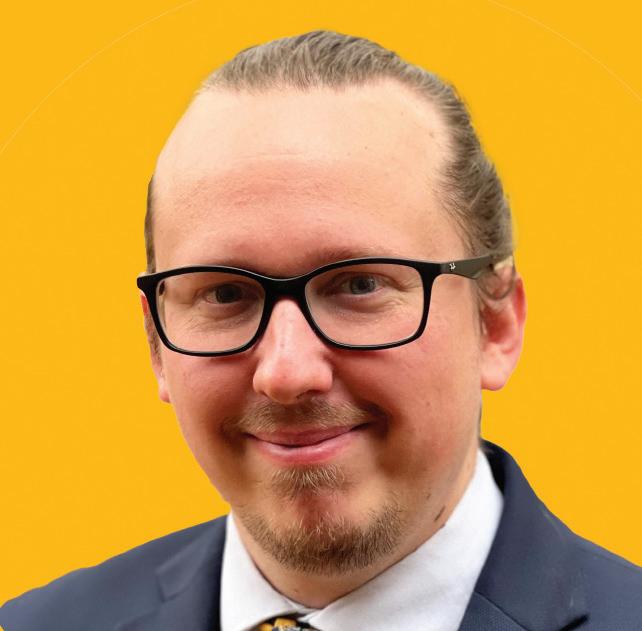
Allison Bernard, CE 09
Project Development Director | NextEra Energy Resources
Allison Bernard is a seasoned project management leader with 16 years of experience driving mission-critical projects, leading cross-functional teams, and spearheading culture transformation in S&P 500 companies. Her leadership has been instrumental in streamlining operations and fostering innovation in the energy industry. She currently works as a project development director at NextEra Energy Resources, the world’s largest renewable energy company in solar, wind, and battery. Through her expertise in project development and strategic execution, Bernard contributes to a sustainable and resilient energy future.
Shannon Evanchec, EnvE 16
CEO | TruePani
Shannon Evanchec is an environmental engineer and entrepreneur dedicated to improving drinking water quality. She earned her Bachelor of Science in Environmental Engineering from Georgia Tech in 2016 and an MBA from the University of Tennessee in 2021. As co-founder and CEO of TruePani Inc., Evanchec leads initiatives to eliminate lead from drinking water in schools and communities nationwide. Her work has impacted communities across 22 states and has garnered recognition, including the InVenture Prize People’s Choice Award and inclusion in Knoxville’s “40 Under 40” list.
Samuel Harris, CE 12, MS CE 14
Assistant State Traffic Engineer | Georgia Department of Transportation
Sam Harris is the assistant state traffic engineer for the Georgia Department of Transportation (GDOT) and a licensed professional engineer in Georgia. He has worked in signal operations, traffic simulation modeling, and safety analysis, and previously served as state safety engineering manager, leading GDOT’s HSIP efforts. In his current role, he oversees the Operational Improvement Program, Permitting, Safety Program, RAID Program, TMC project delivery, and safety data management. He also co-leads GDOT’s Data Purchase Program. Harris is the 2024 ITE Young Member of the Year, immediate past president of Georgia ITE, and secretary of the ITE Safety Council.
CEE Alumna One of First Pathway of Progress Honorees
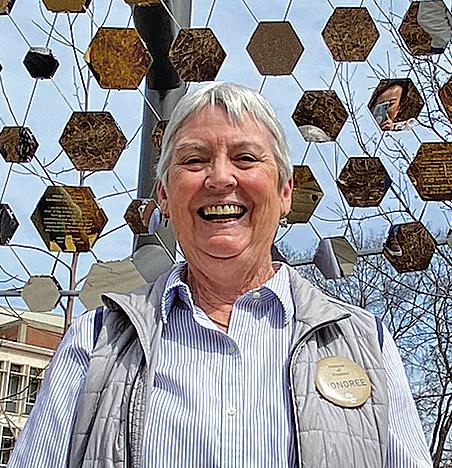
Carolyn D. “Lyn” Wylder, CE 75, MS CE 78, is one of the first honorees selected for Georgia Tech’s Pathway of Progress installation, which celebrates the contributions of women at Georgia Tech. Wylder was recognized for her contributions to major civil engineering projects and transit development throughout the course of her career.
Wylder joined MARTA, the Metropolitan Atlanta Rapid Transit Authority, in 1982 to work on the construction of the rail transit system. During her tenure, she helped expand the MARTA system in multiple directions and add new stops including Brookhaven, Indian Creek and Airport Station. As assistant general manager for transit system development, she and her team completed hundreds of millions of dollars of construction in preparation for the 1996 Olympic Games in Atlanta.
Wylder also served as chief engineer for the Massachusetts Bay Transportation Authority in Boston. In 2000, Wylder went into private consulting in Portland, Ore. In 2004, she was assigned to work with the Federal Transit Administration on the 9/11 Recovery Projects to help New York City rebuild its transportation infrastructure damaged in the terrorist attacks on Sept. 11, 2001.
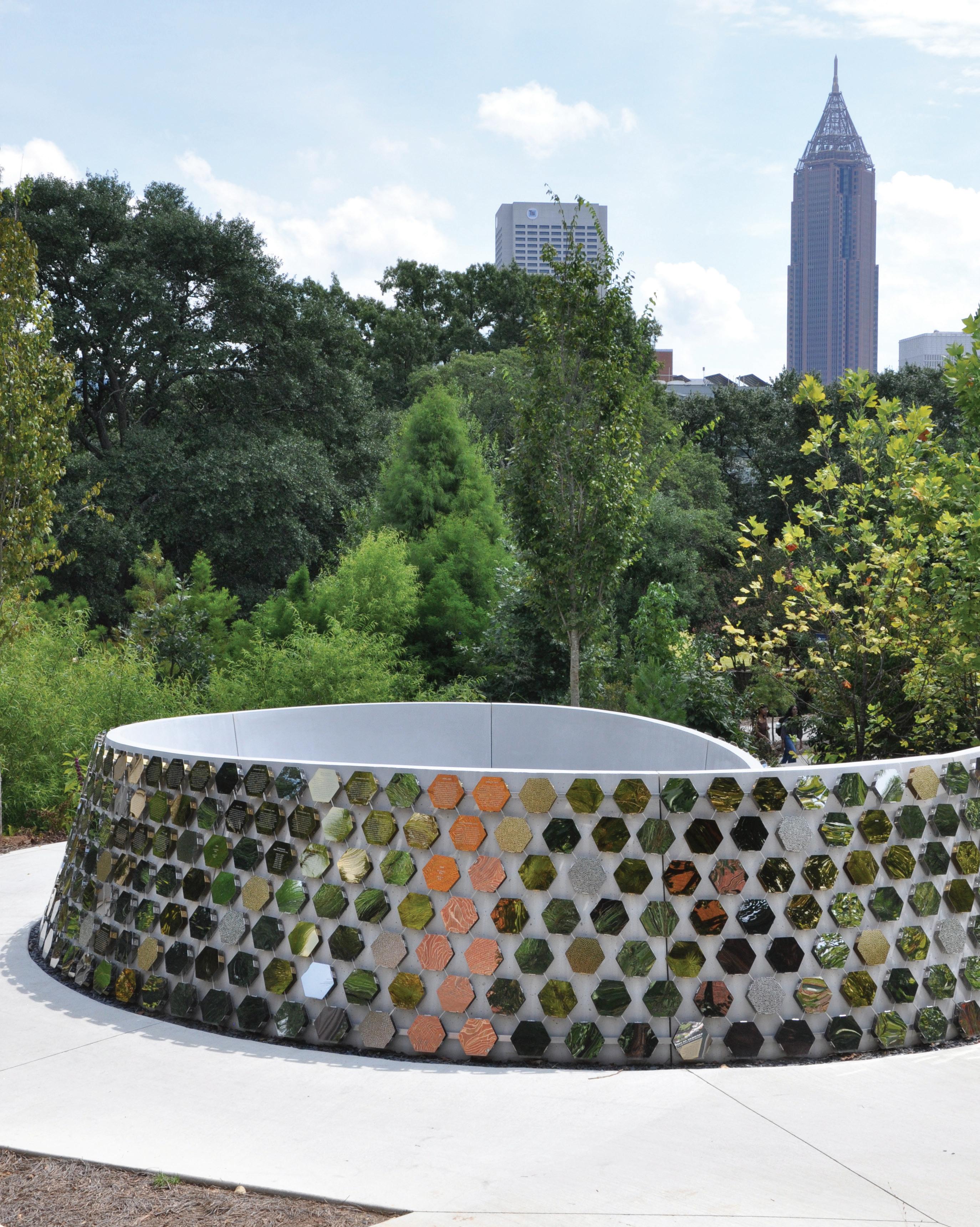
The impact of GIVING
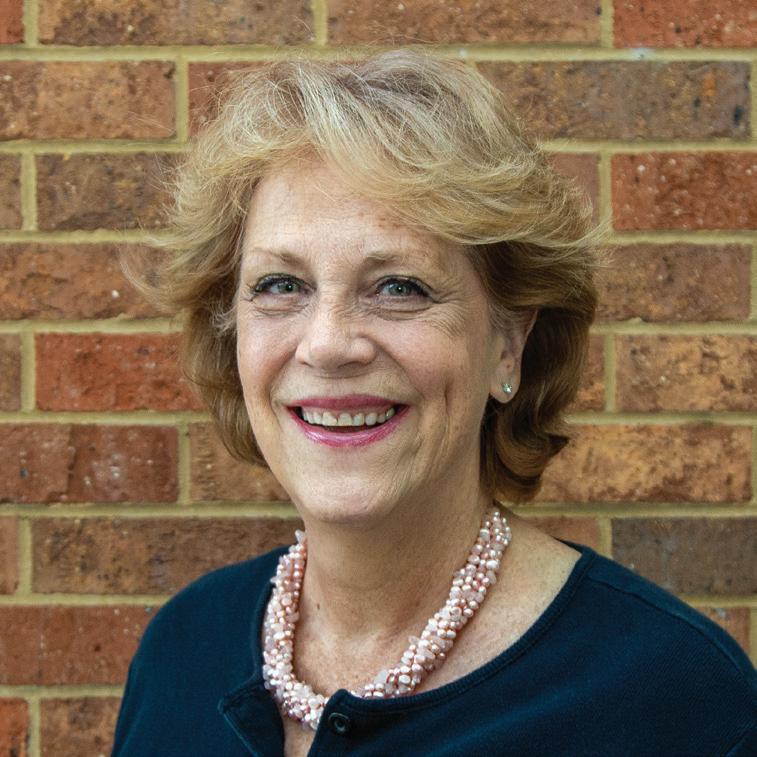
Dear CEE alumni and Friends,
Thanks to the generosity of our alumni, friends, and corporate and foundation supporters, FY 2025 was another successful fundraising year for CEE. The School raised a total of $7,592,974, 60% of which was from alumni as individual households or through donor advised funds or family foundations and 28% from corporate donations.
Particularly noteworthy is that 59.8% of total giving was to endowments, including student scholarships and fellowships, faculty support endowments, program support endowments, and unrestricted endowments for the discretionary use of the School Chair. This is consistent with giving patterns to CEE throughout the Transforming Tomorrow campaign; 78% of giving has been to new or existing endowments. The FY 2025 endowment giving included giving to established endowments and the establishment of 9 new CEE endowments. The percentage of endowment giving to CEE is higher than that for most Schools in the College of Engineering, which is important because endowments are invested funds that will grow in value over time and provide spendable funding in perpetuity. These endowments build a solid a foundation for funding which the School will be able to rely on for decades to come and will better enable it to weather political and economic fluctuations in support. We are deeply grateful to everyone who has invested in the future of CEE and Georgia Tech.
In FY 2025 CEE made enormous progress with one of our priorities, fulfilling the anonymous $5M matching gift challenge for PhD funding. With huge assistance from Regional Development and the EAB and EAB Emeriti, we are within $600K of meeting our goal by December 31, 2025. The importance of this funding cannot be overstated; PhD students are the lynchpin of any R1 research university, and their work is vital to research, undergraduate teaching, and university reputation and visibility, but their role and funding mechanisms are not immediately apparent to the general alumni community. This year has shown that their means of federal support is particularly vulnerable to political winds, making private philanthropy even more essential to ensuring the next generation of engineering researchers and educators. New endowments and donations to the Skylar Bernstein-Wombough Graduate Student Endowment, a shared endowment named in honor of Skylar, CE ’24, an aspiring professor who was taken by cancer last November, will enable CEE to realize the full potential of this transformative match opportunity. This campaign can also serve as template for future Institute- and Collegewide campaigns for PhD funding, which is a critical institutional need.
Thank you so very much for your generous support of CEE. I know the pride I feel working at one of the very best Civil and Environmental Engineering schools in the world, and I can only imagine the pride you feel as graduates. Your generosity and loyalty is an important part of what makes this excellence possible.

All the best, and Go Jackets!
Director of Development
Thank you for your generosity
Fiscal Year 2025 donors to CEE who gave $10,000 or more:
$2,000,000
José Domingo Peréz Foundation
$1,000,000-$1,999,999
Agilent Technologies, Inc.
$250,000-$350,000
National Academy of Scientists
The National Academy
Fred C. Donovan, CE’63
Isaac J. Scott III, CE ’74
James P. Stokes, CE ’62
$100,000-$200,000
Dean Drinkard, CE ’71
Burroughs Wellcome Fund
John M. Carroll Jr., CE ’77
Terry Crockford, CE ’86
James L. Drinkard, CE ’75
Kate Henry, CE ’08 and Ronald L. Henry III, CMPE ’07
Julia M. and Gregory T. Hodgdon, CE ’85
William S. Train, CE ’80
Richard C. Tucker Sr., CE ’64
Carolyn P. Wylder CE ’75 MSCE ’78 and
John O. Wylder, ECON ’73
$50,000-$80,000
DeLane Haren and Evan Haren Jr., CE ’77
Jeanette S. Maulding
William E. Higginbotham, CE ’76
Orlando R. Méndez, CE ’91 MSCE ’92
$25,000-$34,000
Tensar Corporation
Robert Wood Johnson Foundation
Clark Construction Group, LLC
Rebecca L. Nease, CE ’79 and Anthony T. Gody, MSBC ’13
Anita B. Atkinson, CE ’00
Christopher E. Brazell, CE ’01 MSCE ’04
Karen M. Jenkins, ARCH ’92 MSCE ’93
Michael W. Montgomery, CE ’70
Blake V. Peck, MSCE ’78
Wassim A. Selman, CE ’81 MSCE ’82 PhD CE ’86
Barbara F. Sloan, MSCE ’77 and Ronald E. Sloan
Kimberlie S. Staheli, PhD ’06
Taylor P. Wright, CE ’93
$12,500-$20,000
MathWorks, Inc.
Mindy L. Toole and Rick Toole, CE ’79 MSCE ’80
Martin C. Boyd, CE ’94 MSCE ’97
Donald W. White
Thomas S. Heckman, CE ’14
Alvin B. James Jr., CE ’01 MSCE ’04
Daveitta L. Knight, CE ’94
$10,000
Robert C. Bachus
J. Abner Conner, CE ’68
Linda W. Farrell
Gary R. Lubin 1972
George B. Nathan, CE ’72
Michael B. Planer, CE ’86
Michael F. Smith, CE ’71
George W. Stewart, CE ’71
Mary Ann Stith
Vecellio Family Foundation
New Founders Council Members
The Founders Council recognizes generous alumni and friends who have made provisions of at least $25,000 in their estate planning for the future financial strength of Georgia Tech
Phillip J. Brown, CE ‘64
John A. Grant III, CE ‘74
Gary Thomas, CE ‘74
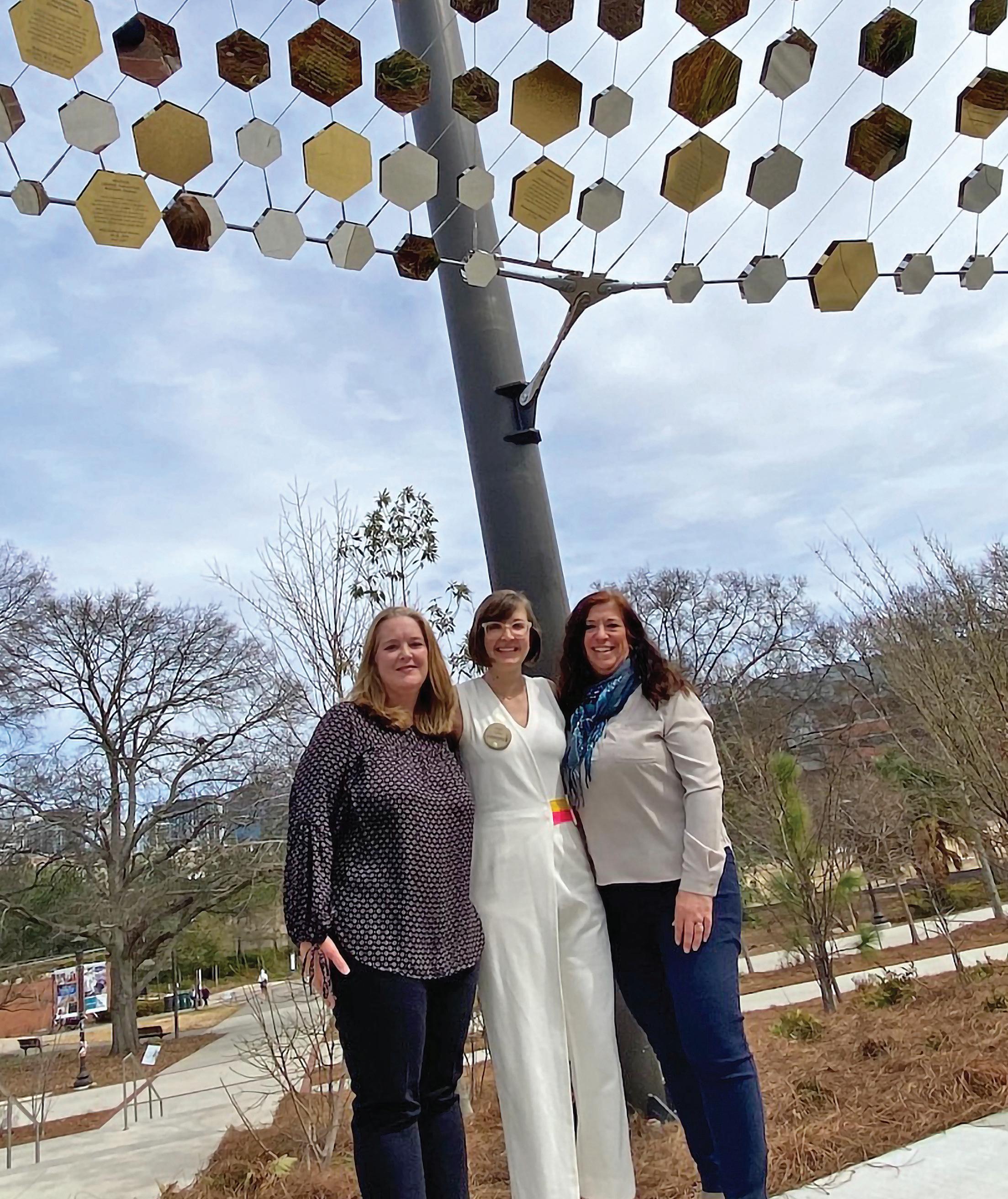
Civil Engineering Alumnae Bring Structural Stability to Installation Celebrating Women of Georgia Tech
By Melissa Fralick
Civil engineering alumnae were integral to the process of bringing Georgia Tech’s newest art installation to life.
The installation, called Pathway of Progress: Celebrating Georgia Tech Women, was officially opened on March 8. The structure contains nearly 3,000 mirrored tiles, each of which will one day tell the story of Tech alumnae, students, faculty, and staff who made a lasting impact.
The structural engineering for the project was provided by Shear Structural, a firm co-founded by three Georgia Tech alumnae: Malory Atkinson, BC 08, Holly Jeffreys, CE 96, and Karen Jenkins, M Arch 92, MS CE 93.
The women of Shear Structural are deeply intertwined with the project and actively engaged with their alma mater.
Shear Structural supports CEE through the Corporate Affiliates Program and provides a fellowship for master’s students in structural engineering. Jenkins serves as the chair of the School of Civil and Environmental Engineering’s External Advisory Board and Atkinson is one of the first honorees to be featured in the installation.
Atkinson, Jenkins, and Jeffries shared their experience working with Shear Structural as the Engineer of Record for the project.
“We love when engineering and art intersect, and this project is a perfect example of that synergy. It’s not every day that structural engineers get to work on something so visually striking and historically significant. We hope that the Pathway of Progress will inspire future generations of Georgia Tech students—especially women—to continue breaking barriers,” they said.
Q: All three of you are Georgia Tech alumnae. What was it like working on a project that honors the contributions of women at Georgia Tech?
A: This project felt personal to us. As Georgia Tech alumnae, we deeply appreciate the progress made by the women who paved the way before us. To contribute our expertise to a project that celebrates those trailblazers was an honor. It also reinforced why representation matters—seeing a women-led engineering firm play a role in this installation is a testament to the evolving landscape of STEM fields.
“
It’s not every day that
structural
Q: How did you work with the architect and others to make this project a reality?
A: Collaboration was key. We worked closely with the architect to understand the artistic intent and then translated that vision into a feasible structural design. We also coordinated with fabricators and contractors to ensure constructability and efficiency, making adjustments along the way as needed. Open communication and teamwork were critical in turning this concept into a standing, lasting piece of art.
Q: Can you explain what Shear Structural did as the Engineer of Record?
A: As the Engineer of Record, Shear Structural was responsible for ensuring the structural integrity of the Pathway of Progress art installation. This means we designed and verified that the structure could safely support itself and withstand environmental forces like wind and gravity. We worked closely with the architect, fabricators, and contractors to translate the artistic vision into a buildable, durable, and code-compliant reality.
Q: What were some of the biggest challenges or unexpected aspects of this project?
A: Art installations often push structural boundaries, and this project was no exception. One of the biggest challenges was balancing the delicate, expressive nature of the artwork with the need for durability and safety. We also had to coordinate closely with the tight existing campus elements and the contractor to ensure the structural supports were seamlessly integrated without detracting from the visual or physical impact.
Q: What did you enjoy most about this project?
A: One of the most rewarding aspects of this project was the opportunity to bring an artistic vision to life in a way that is both structurally sound and visually compelling. We loved the challenge of engineering something that isn’t just functional but deeply meaningful. Plus, working on a project that honors women at Georgia Tech made it even more special, as we are a women-led structural firm with three Georgia Tech alumnae at the helm. l
engineers get to
work on something so visually striking and historically significant. We hope that the Pathway of Progress will inspire future generations of Georgia Tech students—especially women—to continue breaking barriers.
L to R: Holly Jeffreys, Malory Atkinson, and Karen Jenkins stand beneath the reflective hexagon tiles of the Pathway of Progress art installation at Georgia Tech. (Photo by Gloria Lin)

STUDENT TRAVEL
International student travel grew in popularity in the 2024-25 academic year. Our students utilized Mundy Funds to travel across the world to explore and gain new cultural perspectives. Students traveled to The Netherlands, Portugal, Denmark, and across Europe. The Joe S. Mundy Global Learning Endowment provides financial support for CEE students to travel for the purpose of cross-cultural development.
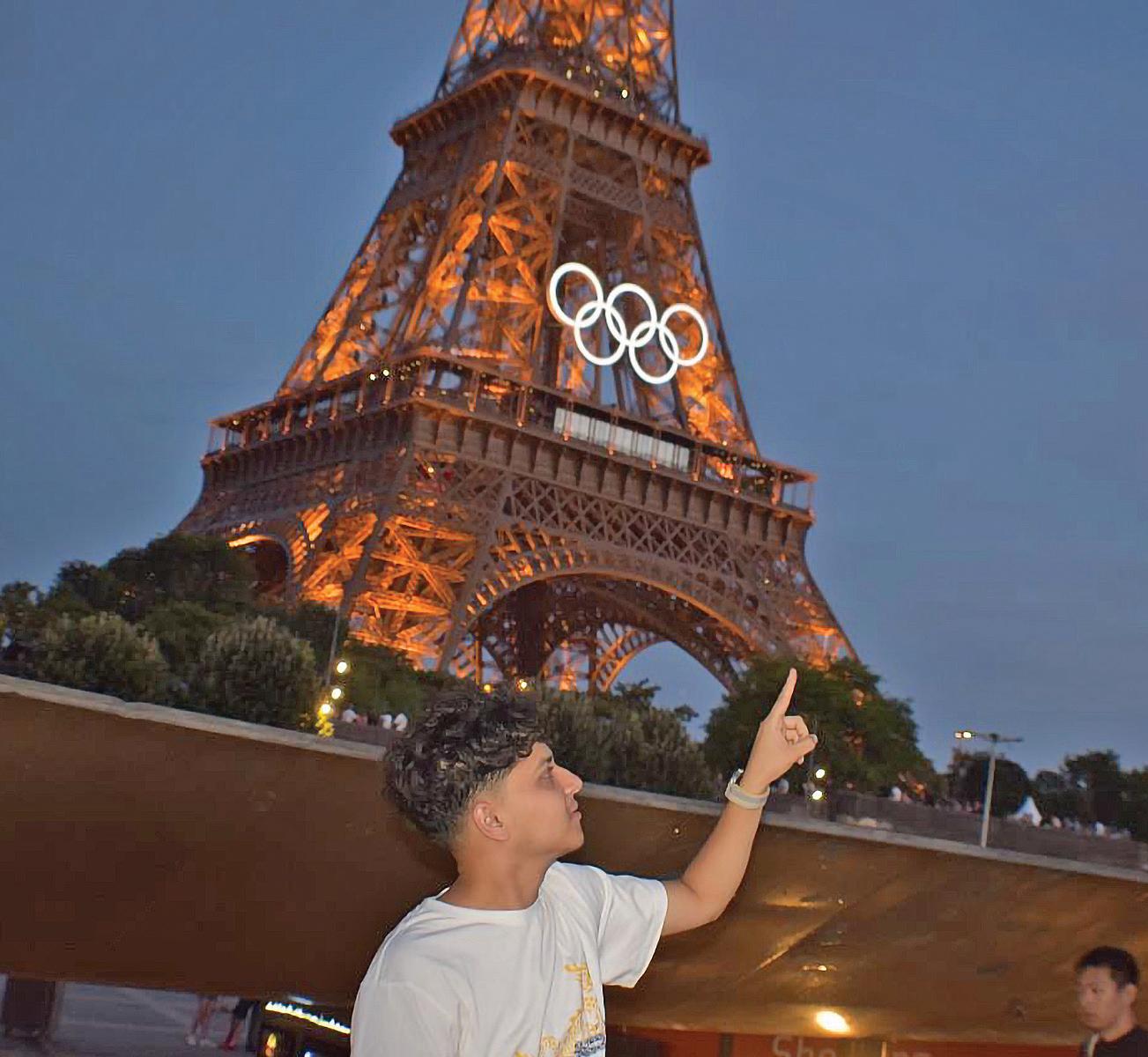
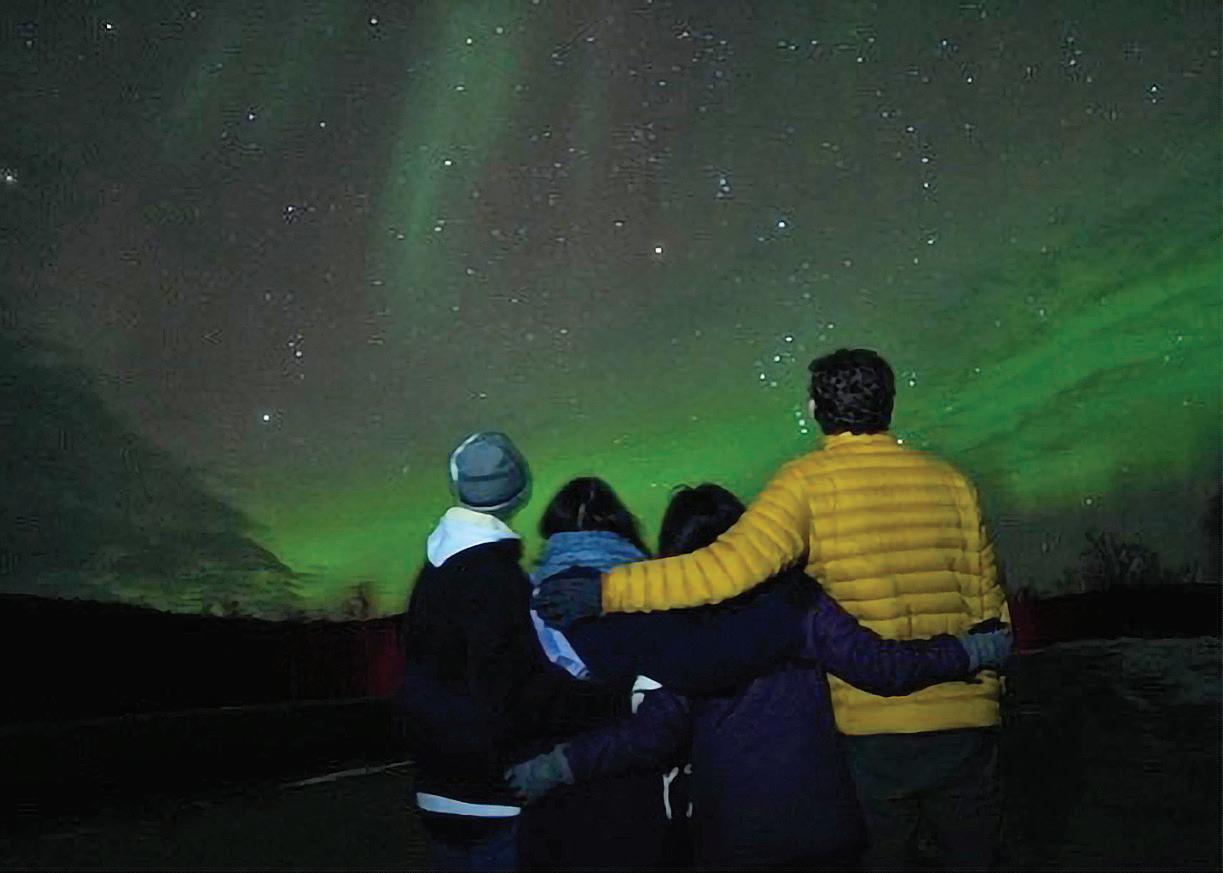
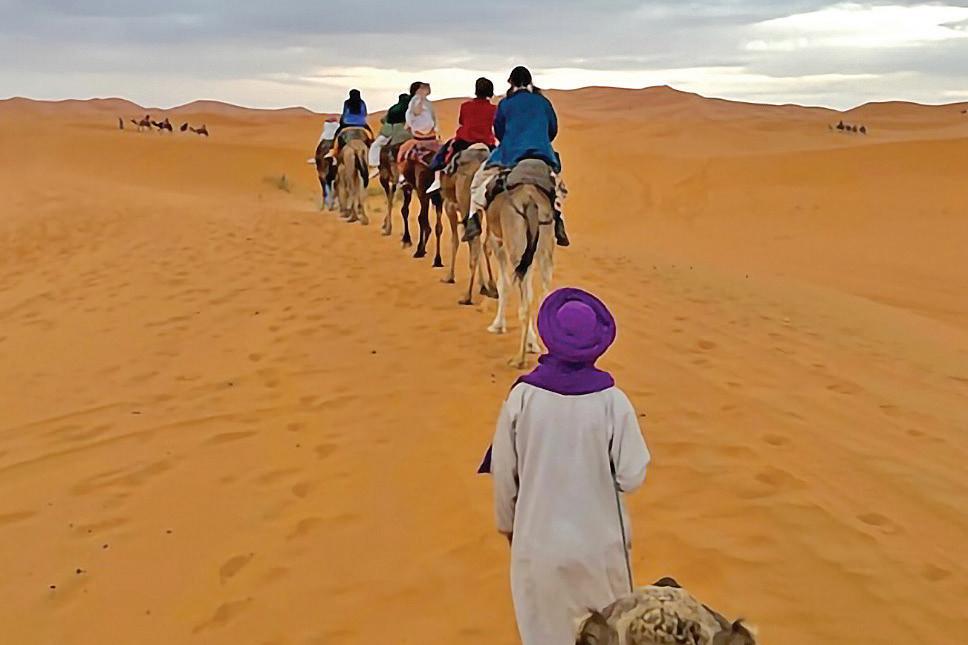
1) Georgia Tech Barcelona group; 2) A boat ride on the Seine for Mustafa Shahem with the Eiffel Tower in the background; 3) The Northern Lights in Tromso, Norway, witnessed by Pace Gustinella and friends; 4) Laura Gomez-Ray goes camel riding in the Sahara Desert.
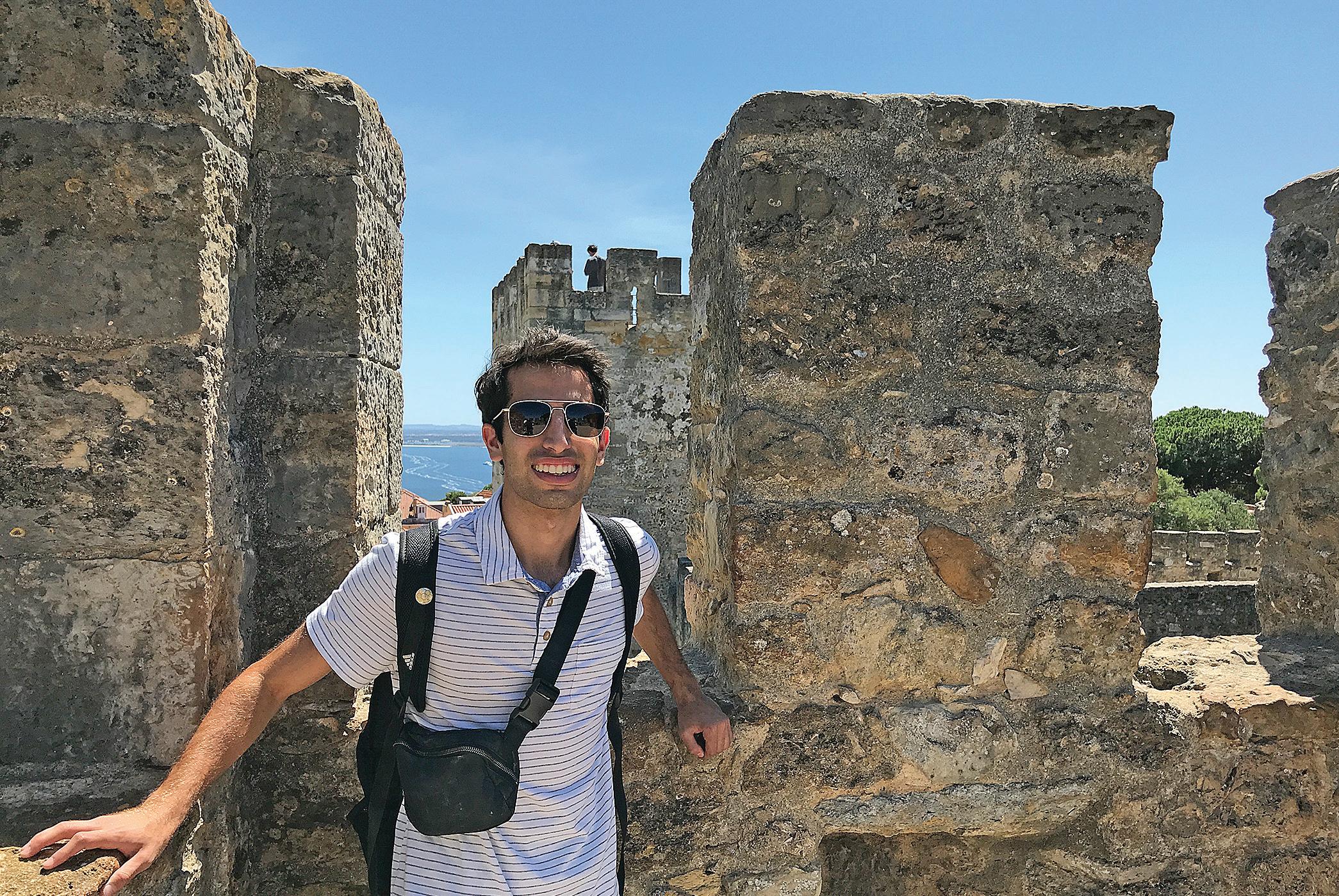
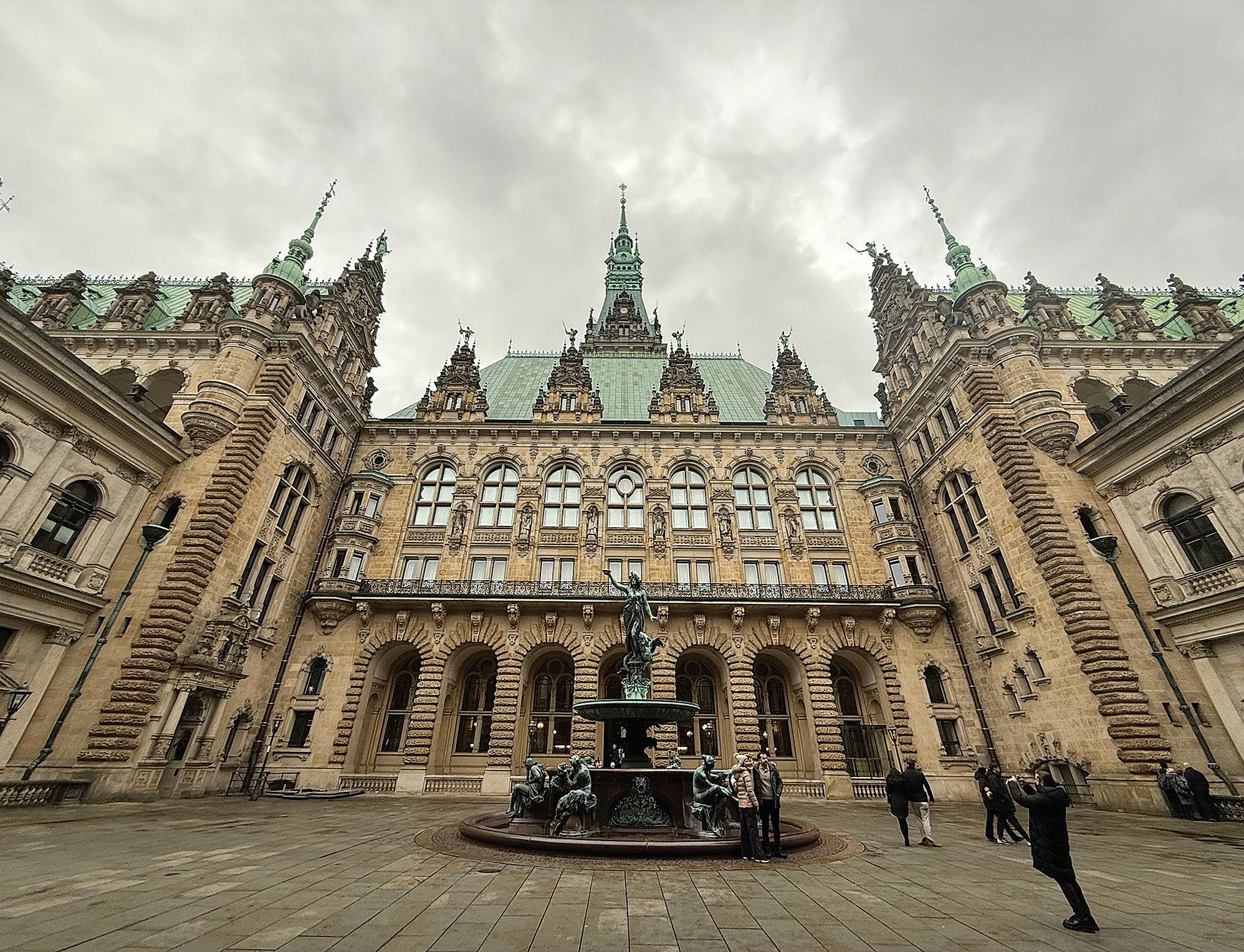

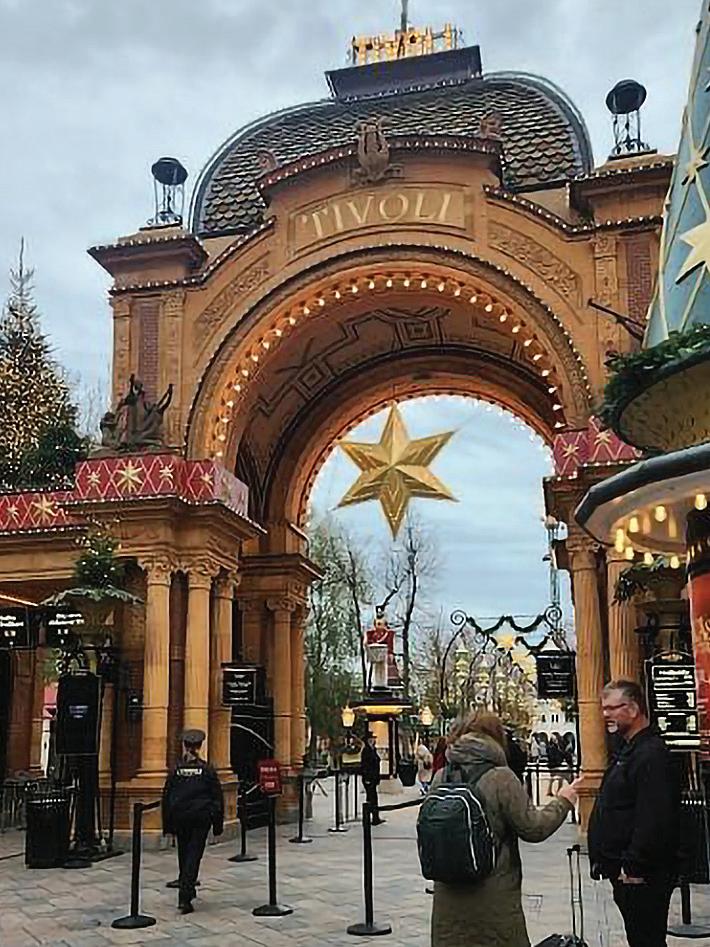
Clockwise from top left: 1) Gabriel Ackall at the historic Castelo Del S. Jorge in Portugal; 2) Christmas decorations in Copenhagen; 3) Laura Gomez-Ray, left, and a new Australian friend in London; 4) Morgan Harvey, third from bottom right, has Thanksgiving dinner in Denmark with friends from five continents; 5) Hamburg City Hall, as seen by Michael Bauby.

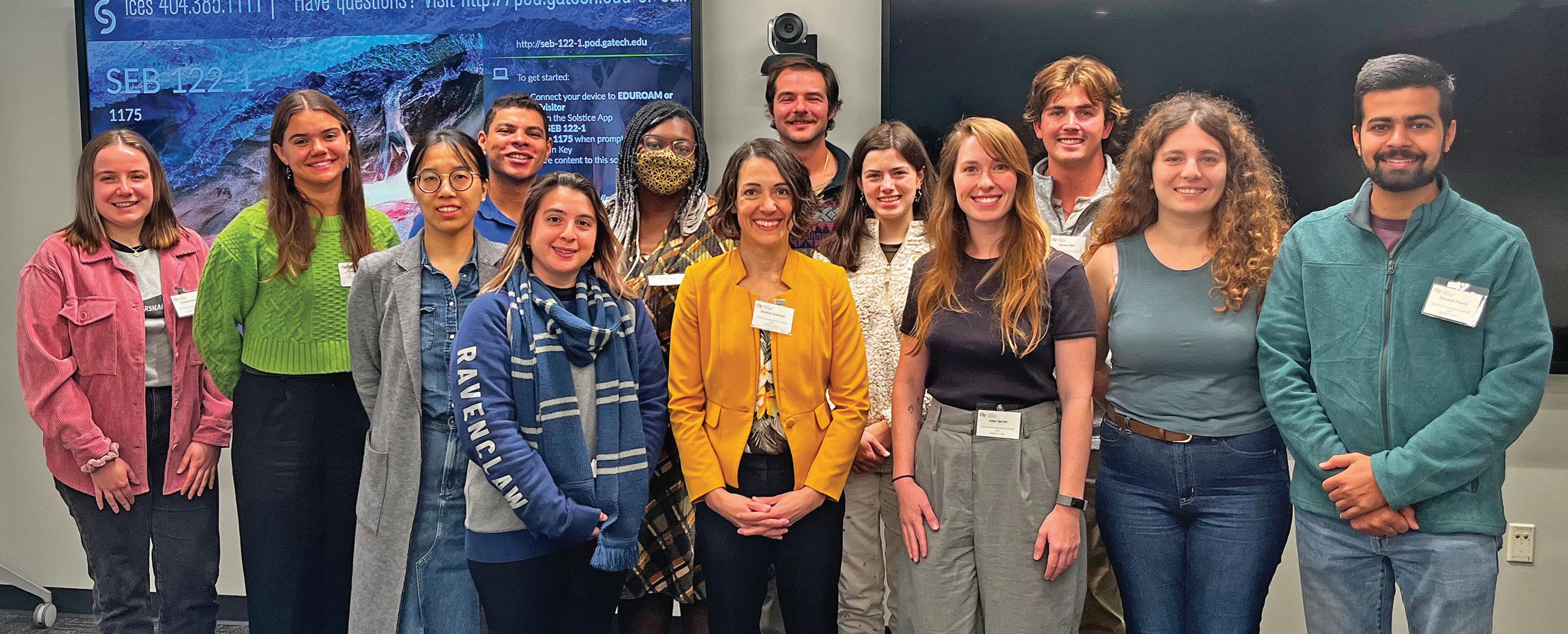
Goldman Encourages Students to Leave Places Better Than They Found Them
By Michael Hunter
Gretchen Goldman, MS EnvE 08, PhD EnvE 11, has spent the years since she graduated trying to “leave places better than we found them,” one of three central tenets of the student reflection speech she delivered at commencement in August 2011.
Goldman spoke to students, faculty and guests for the Fall 2024 Hyatt Lecture on Oct. 17.
At the time, she was the Climate Change Research and Technology Director at the U.S. Department of Transportation and co-director of the DOT Climate Change Center. From 2021 to 2023, she served in the Biden administration as the Assistant Director for Environmental Science, Engineering, Policy, and Justice.
“My time at Georgia Tech was very special to me and I think it shaped who I am in lots of ways,” said Goldman. “By the time I graduated, I had a pretty clear idea of what I wanted to do, how I wanted to affect change in different ways, but I didn’t know exactly how I would get there,” she said.
She framed her talk as “what I would have wanted to tell myself when I was leaving Tech and choosing what to do next in the world,” or “Gretchen’s guide to solving big problems, serving communities, and leaving places better than you found them.” Goldman organized her talk into five lessons.
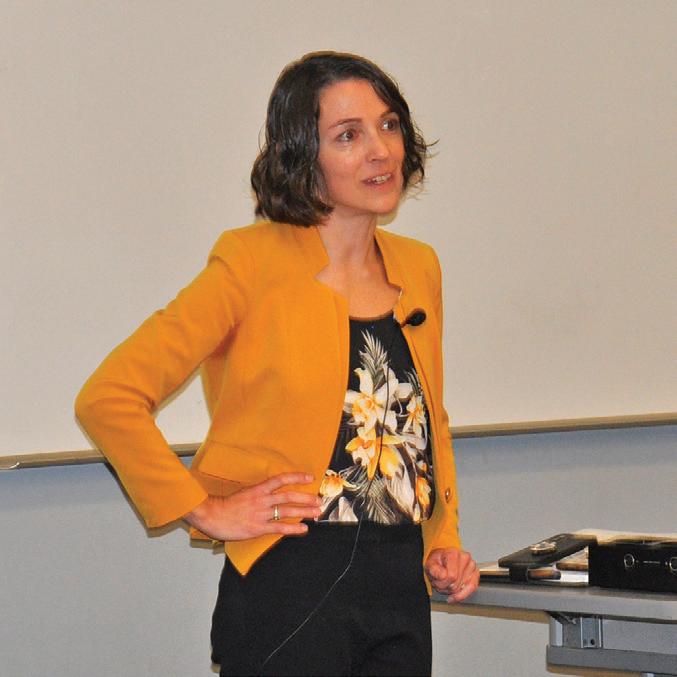
Lesson 1: Imagine and Work Towards a Better World, Even if You Can’t See the Pathway
During her time at Tech, Goldman was very involved in bike advocacy and trying to build a community around biking on campus. Her group persuaded Facilities to build a cage at the
bottom of the CRC parking deck for students to work on bikes. The goal was to get more access to bikes for students, teach them how to work on bikes, and also improve campus infrastructure. By the end of her time at Tech, a couple of bike racks had been installed and sharrows painted on the street. Goldman contrasted the group’s small successes with the extensive bike infrastructure currently all over campus. “It’s so much more than I could have ever imagined when I was a student,” she said. “I thought this was a great example of just how much progress you can make if you start down a path, even if it’s not clear how you’re going to get there, long term.”
Similarly, when Goldman was working for the Union of Concerned Scientists, she played a significant role in crafting the Air Quality Public Health Act of 2020.
“You probably haven’t heard of it, because it didn’t get passed,” she told the students. The bill was specifically proposed to address environmental injustices and who is exposed to air pollution. Since the bill didn’t get passed, Goldman chalked the experience up to figuring out what the policy pathway could be as they didn’t know how it would ever get passed. During her time in the Biden White House, however, the Inflation Reduction Act was passed, the largest climate investment in history, according to Goldman, and the Air Quality Public Health Act was included in the bill. “Because we took the time to develop out that policy idea, it was ready to go when the Inflation Reduction Act was moving and now the U.S. Environmental Protection Agency is working on those elements to improve air quality in environmental justice communities and that has been a really important victory,” Goldman concluded.
Dr. Gretchen Goldman, center, with graduate students after lunch.
Lesson 2: Don’t Underestimate Your Knowledge or Skills
“When you’re in an academically rigorous place like Georgia Tech you’re just very hyper aware of all the things you don’t know because you’re being tested on it,” Goldman told the students. She encouraged the students to remember the things they did know and the skills they have that aren’t recognized in an academic setting. She shared that she felt like she wasn’t a good speaker at conferences because “the way that I write and talked was more casual and sort of layman,” but when she moved to Washington D.C. to work, “it became this incredible asset to be able to talk like a human to people on technical topics in a way that they could understand.”
Goldman gave an example where she posted on Twitter explaining that the E.P.A. disbanding a key scientific panel on air pollution was “really bad” and what the impact of the decision would be. The post wound up appearing in a New York Times article.
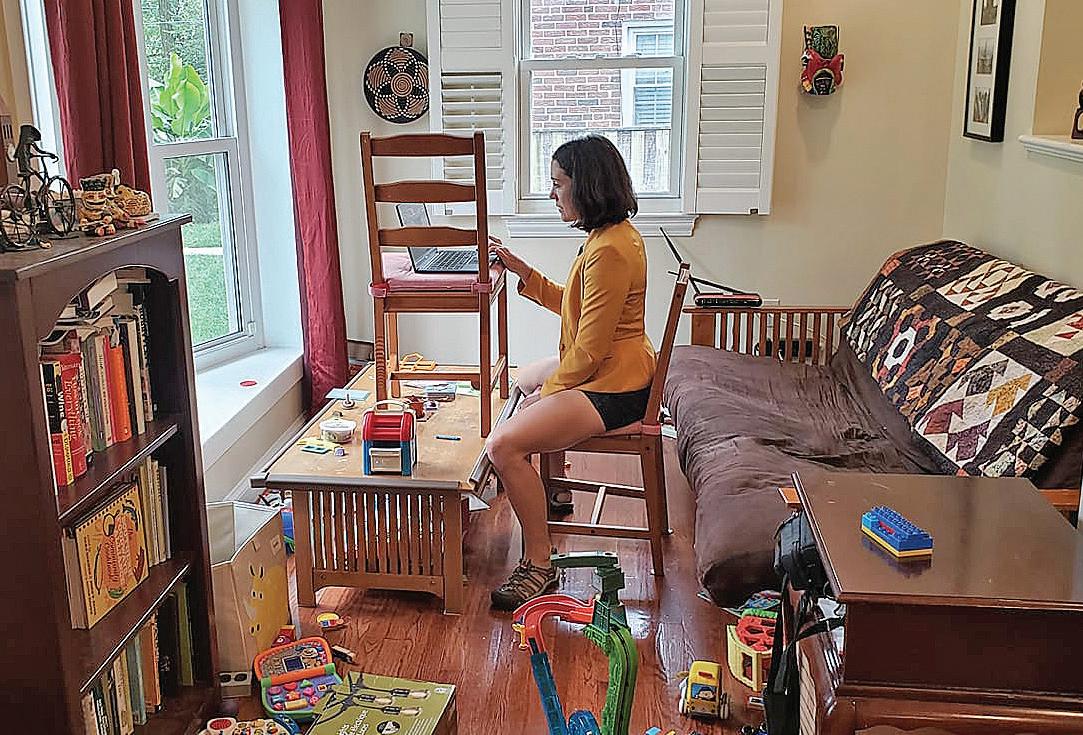
On another occasion, she was interviewed on CNN during the pandemic and quickly cobbled together a professional look for the camera even though she was working from home and appearing by way of her laptop camera. When she tweeted a picture of the actual room, the tweet was viewed over 25 million times, and she began fielding interview requests to talk about the plight of parents during the pandemic. “It was really an opportunity to educate people about the real challenges that did exist for parents and caregivers,” she said.
Lesson 3: Take the Time to Understand the Real-World Context of Your Work
According to Goldman, one thing that helped her in her career path after Tech was to “think about the concepts I learned in the classroom and how they were dealt with in the real world outside of the classroom.” While she was a student, she attended a court case in downtown Atlanta, a legal battle over a permit for a coal-fired power plant they were building in South Georgia.
“I listened to them talk about my science, the thing I was working on at Georgia Tech in my research group, but they were talking about it entirely differently than the way that we would have talked about it in the lab group,” she said. It made her realize that the way technical information is used outside of academic environments can be really different. There is a critical need for someone to be able to translate technical information in a way that ensures decisions are science-based, she summed
Seize the moment to be here and learn and expose yourself to all kinds of perspectives and learnings and ask questions.
– Gretchen Goldman “
up. That realization set her on a science policy career path. “Right now, you have a tremendous amount of access to really smart people that can help you understand how all of technical work feeds into the world,” she told the students.
Lesson 4: To Solve Big Problems We Need to Change Systems
Goldman related the advice of her fellow Georgia Tech student, Liam Rattray, with whom she started the group Students Organizing for Sustainability, “We have done a lot of things, but you know, we’ve really only added new things. We haven’t really changed the status quo.” In order to actually change the system and how things work and make sure it’s a sustainable long-term change, you really need to change how things operate, she told the students. She recounted how the Biden/Harris administration made a commitment to science integrity by issuing a memorandum of support in its first week. Goldman and a team of people across several federal agencies worked together to “figure out what this would look like within government” and in 2023 released a framework for how agencies could implement scientific integrity policies. “Now there are 19 federal agencies that have new final scientific integrity policies,” she said. “It really can help provide a bigger safeguard than ever has been available before at the federal level to make sure that science and scientists can do their work without fear of politicization.”
Goldman also pointed out that Georgia Tech’s Kendeda Building is a similar example of change that is “really pushing what’s possible to do in a building on campus.”
Lesson 5: Do the Hard Work of Listening, Learning, and Experiencing Discomfort on Hard Topics
Goldman talked about two executive orders issued by the Biden Harris White House. The first, the Justice 40 Initiative, called for at least 40% of all the climate and clean energy investments to go to disadvantaged communities. It was very gratifying to her to continue the environmental justice work she began outside of government on the inside and work on the side of science within the White House at the federal level.
The second initiative was building out government-wide guidance on indigenous knowledge, which she spearheaded. This culminated in a White House Tribal Nation Summit where the guidance was released. “This is the first time that there’s ever been a White House recognition of indigenous knowledge as a concept, and this has been really a bigger step,” she said.
She encouraged the students to take advantage of their time at Tech to “seize the moment to be here and learn and expose yourself to all kinds of perspectives and learnings and ask questions.”
“I hope that one day you have an opportunity to do everything you can to leave a place better than you found it,” she concluded. l
Goldman’s picture of the reality behind her CNN Zoom interview that went viral on social media. (Photo courtesy Gretchen Goldman)
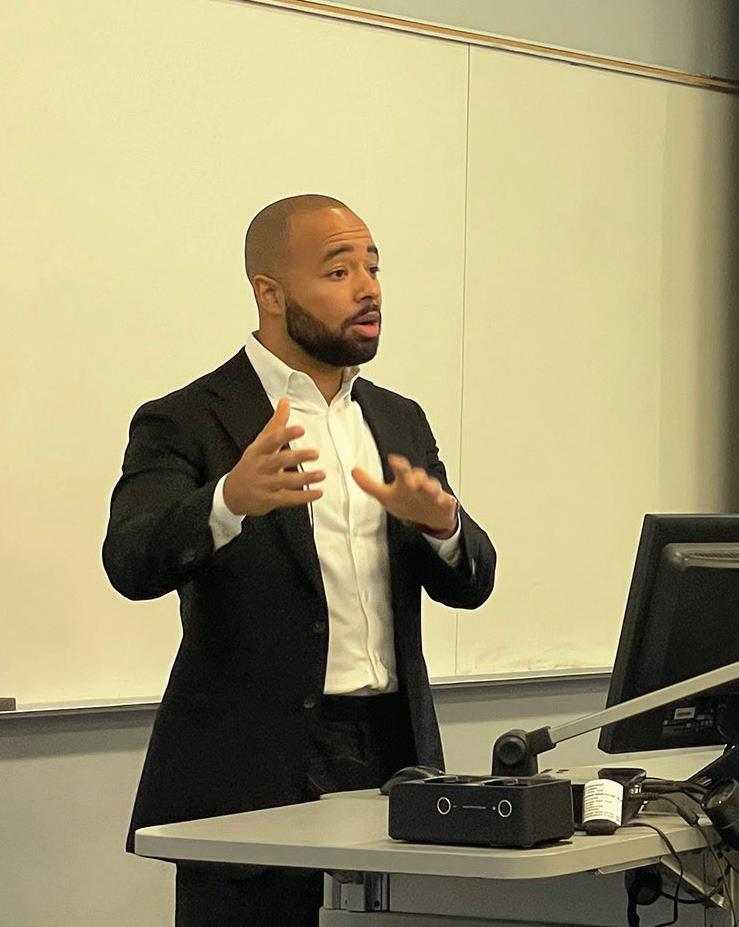
PHOTO BY MICHAEL HUNTER
Jacob Tzegaegbe
KENNETH HYATT DISTINGUISHED LEADERSHIP SPEAKER SPRING 2025
Life isn’t about getting from point A to B. It’s about as you’re going on that journey, making sure you’re doing what you want to do at the right time in your life.
HYATT LECTURE SERIES
By Melissa Fralick
Jacob Tzegaegbe, CE 11, MS CE 13, is the first to admit that his professional journey hasn’t been the most straightforward.
Since graduating from Tech, he’s moved from drilling engineer to management consultant to transportation advisor to technology distribution.
“I would have never told you I was going to do this journey, but I can actually tell you exactly why I’ve done this journey and what I was solving for at the time,” Tzegaegbe said.
Like a true engineer, Tzegaegbe has strategically approached each of his career moves by analyzing six variables to make the best career choice for his “season of life.”
At the Spring 2025 Hyatt Lecture on Feb. 13, Tzegaegbe shared his decision-making framework along with stories from his life to help students as they begin their own career journeys.
The Hyatt Distinguished Leadership Speaker Series, made possible by the generous support of Kenneth Hyatt, CE 62, MS IM 66, brings a distinguished leader to campus each fall and spring to share wisdom and insight with the Civil and Environmental Engineering community.
During his time at Georgia Tech, Tzegaegbe was a student leader with an extensive list of accomplishments. Among them, he was an academic all-American diver with the Georgia Tech swim and dive team, he served as senior class president, was elected Mr. Georgia Tech by his peers, and was named a Marshall Scholar, which allowed him to earn a master’s degree in the United Kingdom.
Tzegaegbe is currently the vice president of global strategy for ADI Global Distribution, where he directs strategy mergers and acquisitions and serves as part of the leadership team. Among his previous positions, he served as director of expansion for a transportation startup and as senior transportation policy advisor for the city of Atlanta.
Tzegaegbe encouraged students to think about their careers one step at a time and make decisions based on what’s most important at their current stage of life.
“Life isn’t about getting from point A to B,” Tzegaegbe said. “It’s about as you’re going on that journey, making sure that you’re doing what you want to do at the right time in your life, because throughout the next 10 years of your life a lot of things are going to change.”
Jacob Tzegaegbe’s equation for career changes in any season of life – Jacob Tzegaegbe
Tzegaegbe said there are six variables he considers when determining the season that you’re solving for:
1. Pay: How much money will you be making?
2. Professional development: what skills are you going to learn?
3. Progression: How does this position you for where you want to go?
4. People: Who are you working with?
5. Purpose: Does this fulfill you?
6. Personal: What’s happening in your life outside of work?
Tzegaegbe used his own career trajectory to illustrate how he’s ranked these points.
As a student searching for an internship, he solved for the two most important factors to him at that time: pay and professional development. Exxon Mobil offered a highly paid internship with opportunity for professional development “to get really good, hard technical skills,” he said.
Though drilling oil wasn’t fulfilling his life’s purpose, that wasn’t the most important factor at the time. Later in his career, he went on to prioritize purpose when he accepted a job with the city of Atlanta. Though he had to take a big pay cut, he was excited to work in public service and help improve transportation in his hometown.
After a couple of years, Tzegaegbe returned to the private sector in a position that enabled him to deploy technology and public transportation to communities across America. The company offered him a promotion to lead a 40-person team based in Tel Aviv—a great opportunity for someone like Tzegaegbe with an interest in global leadership.
But he turned down the promotion because it wasn’t a good fit for his season of life.
His personal life was now his priority as he and his wife Elise were expecting their first child.
“This is a pivotal moment in our life. I don’t want to be traveling to Tel Aviv every few weeks and away from my daughter, who’s about to be born,” he said. “I knew that what I was solving for had changed from when I joined the company, and this wasn’t the right move for me. I want to be a great father. I want to be present, and there will come another season in my life where I will be able to lean in more to work and split my time differently.”
Tzegaegbe’s story illustrates that purpose doesn’t always mean doing what you’re passionate about every single day, but rather, finding balance between professional growth, personal life, and fulfillment. He encouraged the audience to recognize that career fulfillment is a long-term pursuit, and to remain open to evolving their priorities over time.
“I sit here today and I’m less than 10 years into my professional career, and I can say that I feel really confident that I made great decisions,” Tzegaegbe said. “I feel super fulfilled in the career that I’ve built so far and even more excited about the career that’s coming.” l
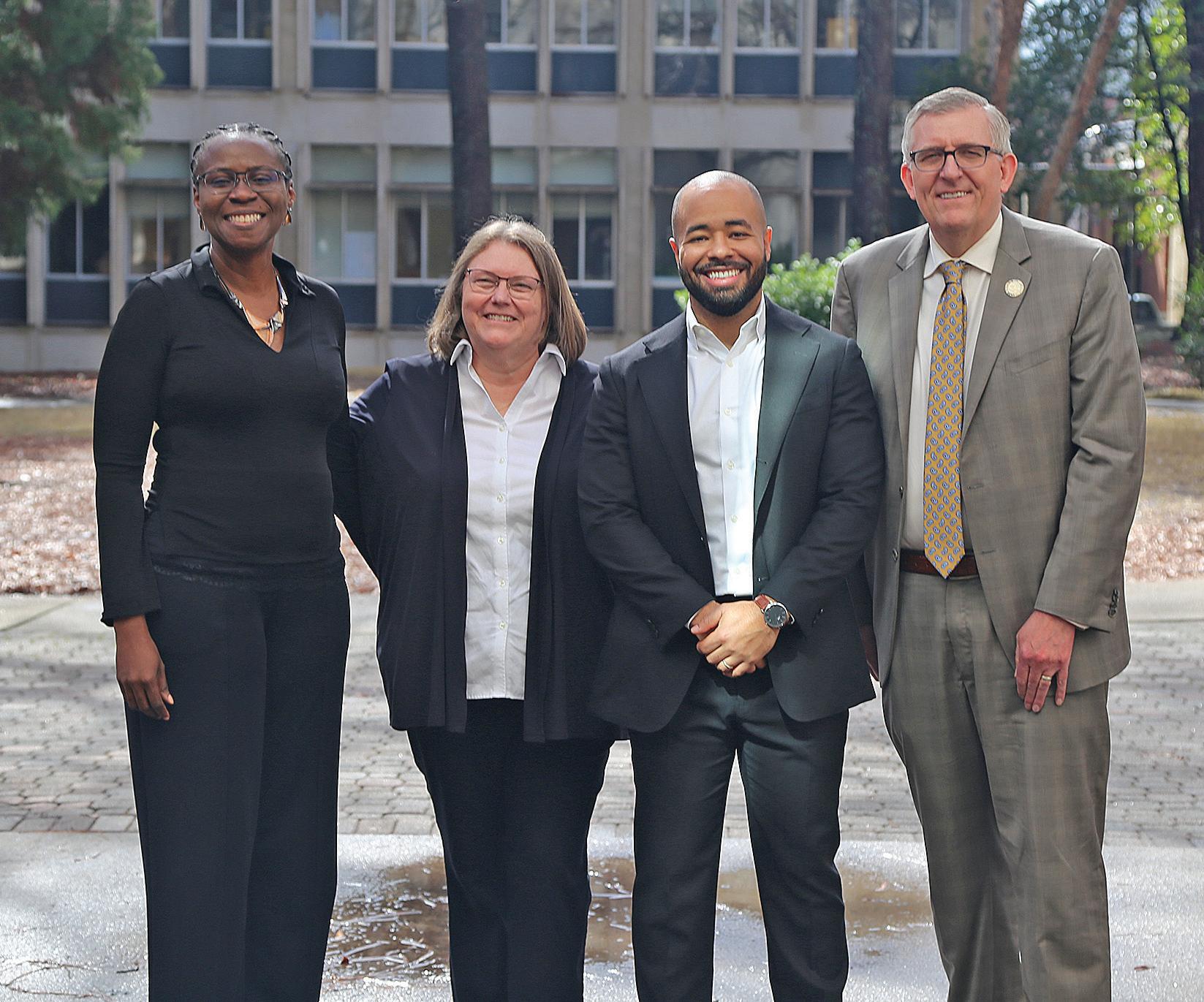
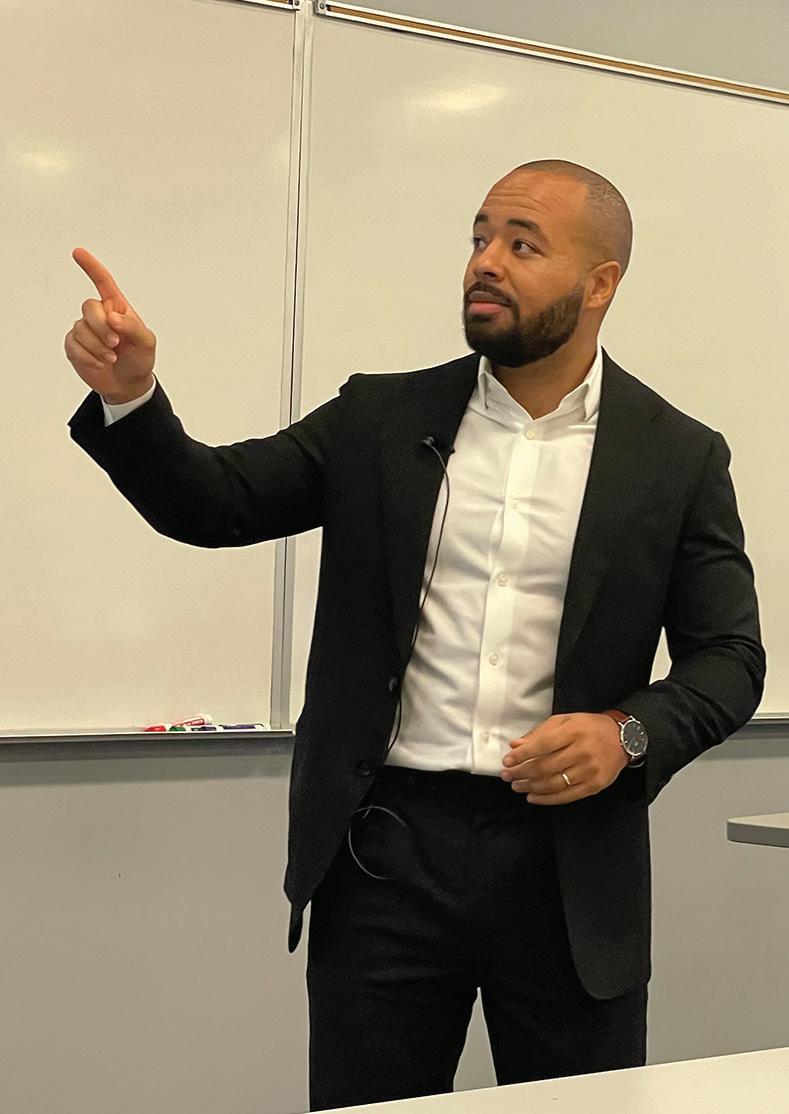
Tzagaebe with, from left, Interim Associate Chair for Administration and Finance Adjo Amekudzi-Kennedy, Interim Associate Vice President for Research Operations and Infrastructure Susan Burns and Karen & John Huff School Chair Don Webster. (Photo by Michael Hunter)
Kenneth Hyatt Distinguished Leadership Speaker Series
OUR 2025-2026 SPEAKERS
FALL 2025
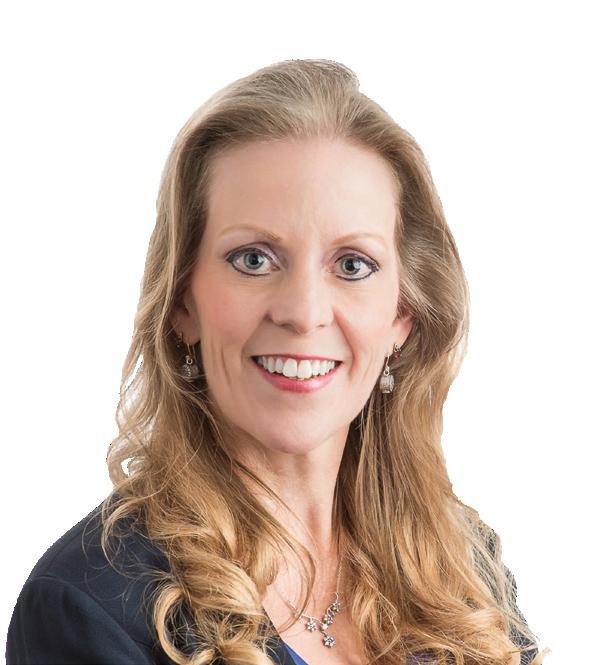
Kim Staheli, Ph.D. CE 06 President, CEO
Staheli Trenchless Consultants
Oct. 14, 2025
SPRING 2026
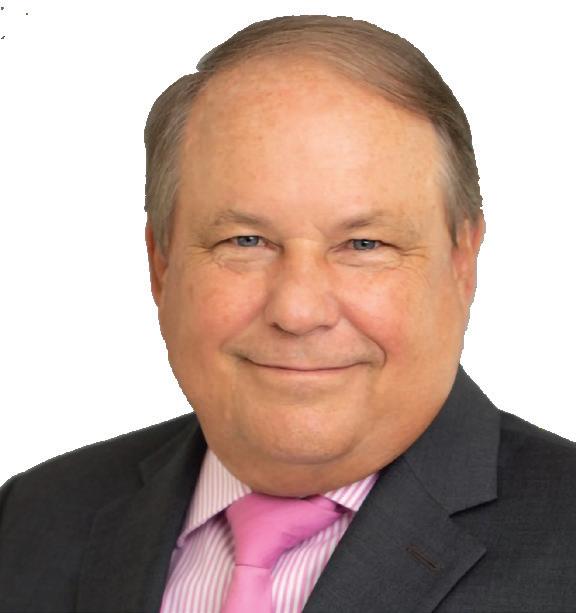
John Carroll, CE 77 President, Carroll Holdings Inc. City Councilman, Vero Beach, Florida
Feb. 19, 2026
The Hyatt Distinguished Leadership Speaker Series brings distinguished leaders to campus each fall and spring to share wisdom and insight with the School’s students and the wider Georgia Tech community.
It is made possible by the generous support of Kenneth Hyatt, CE 62, MS IM 66.
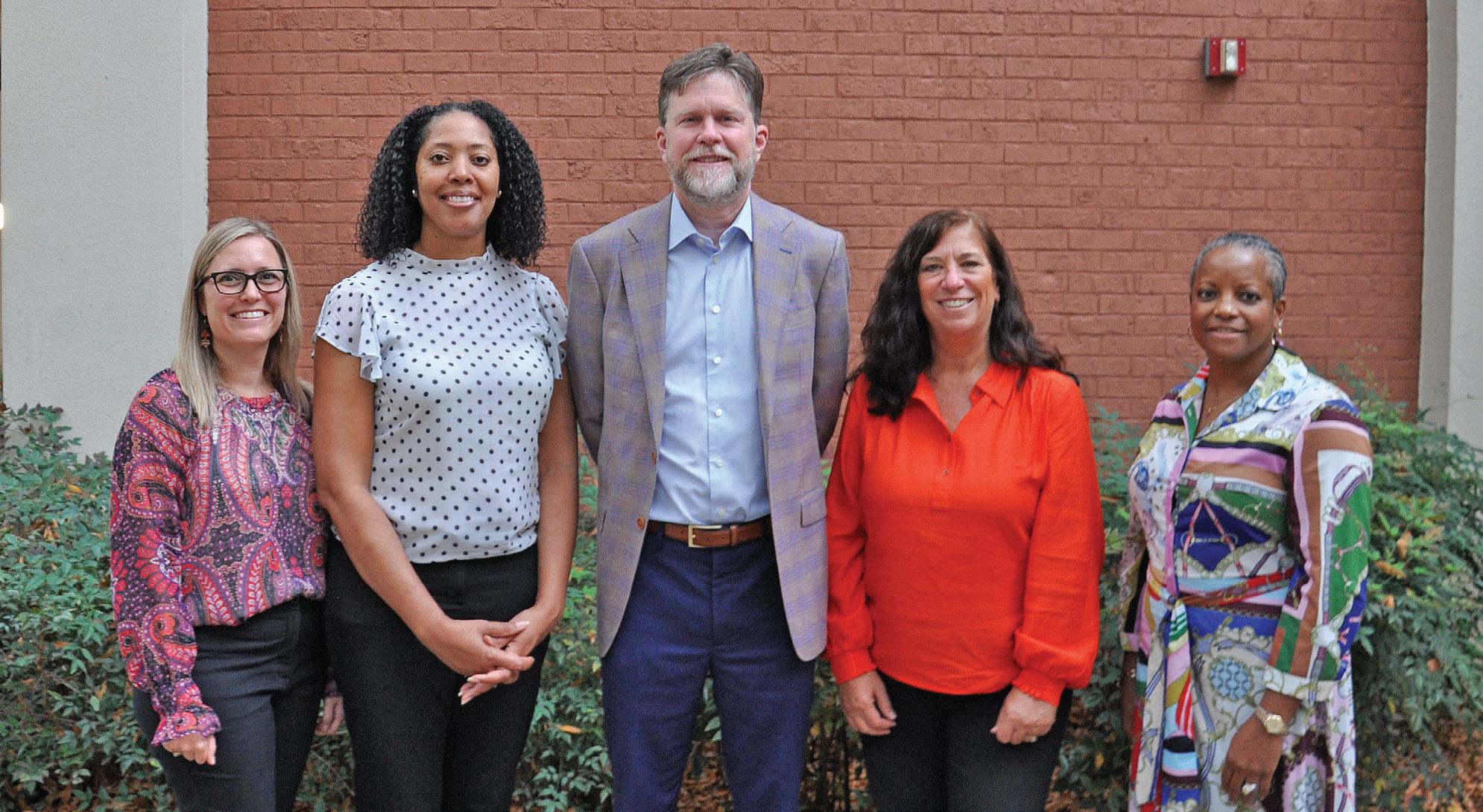
New Members Join External Advisory Board
Four alumni began their six-year terms on the School's External Advisory Board. We are pleased to welcome:
• Stacy Blakley, CE 98 | Chief Executive Officer & Founder, Douglas Consulting Group
• Kate Henry, CE 08 | Vice President and Partner, Aulick Engineering LLC
• Daveitta Knight, CE 94 | Vice President, Atlanta Area Leader, RS&H
• Taylor Wright, CE 93 | Vice President, AtkinsRèalis
Your support provides vital resources that allow us to lead new initiatives, weather cyclical changes in government support, and make longterm investments in programs and technologies. Your gift can be directed to CEE students, faculty, and facilities in a variety ways, depending on your interest. Please contact us to discuss what you would like to achieve by partnering with us.
From left: Kate Henry, Stacy Blakley, Taylor Wright, Board Chair Karen Jenkins, Daveitta Knight
External Advisory Board
Anita Atkinson
Vice President of Engineering & Surveying Patterson & Dewar Engineers CE 00
Carlyle Bernard
Advisory Board Vice Chair Founder/President, St. Martin Consulting LLC CE 86, MS CE 94
Stacy Blakly
Chief Executive Officer & Founder, Douglas Consulting Group CE 98
Marty Boyd
President, Carter & Sloope CE 94, MS CE 97
Chris Brazell
Chief Operations Officer
EMC Engineering Services, Inc. CE 01, MS CE 04
Christy Darden
Director Engineering, Fleet, and Sustainable Operations, Forest Service, Pacific Northwest Region CE 92
Eli Diaz-Atienza
Senior Vice President TRC Services CE 99
Darion Dunn
Managing Partner, Atlantica Properties CE 01
Andrea Hence Evans Owner/Attorney
The Law Firm of Andrea Hence Evans CE 99
Bijoy Ghosh
President
Infrastructure Consultants, LLC MS EnvE 87
Lorraine Green
Retired President, Pond & Company ChE 84, MS EnvE 93
Frank Evan Haren Jr. President and CEO, Haren Construction Co. Inc. CE 77
Kate Henry
Vice President and Partner, Aulick Engineering LLC CE 08
Alvin James Jr. Vice President, Kimley-Horn & Associates, Inc. CE 01, MS CE 04
Cayman James Project Manager, Jacobs Engineering Group CE 99, MS EnvE 01
Karen Jenkins
Advisory Board Chair Managing Partner, Shear Structural M Arch 92, MS CE 93
Daveitta Knight Vice President, Atlanta Area Leader, RS&H CE 94
Brian Lu Founding Partner, The Leaven Group CE 99
Larry McDowell Senior Principal, Uzun+Case, LLC CE 76
Michael Montgomery Retired CE 70, MS CE 76
Guiomar Obregón CEO & Founder, Precision 2000, Inc. MS CE 93, MS MGT 94
CEEatGT External Advisory Board Members provide an important outside perspective on our programs that is essential to maintaining their relevance to industry. They play a significant role in vetting programs designed for students, alumni and corporate constituencies to ensure we maintain the highest quality standards in our curriculum, practice and outreach.
Jacqueline Quinn NASA-KSC Liaison, NASA Kennedy Space Center CE 89
Zakiya Seymour Business Advisory Practice Director, Arcadis MS EnvE 13, Ph.D. EnvE 13
Barbara Sloan Retired Principal, Cambridge Systematics, Inc. MS CE 77
Kimberlie Staheli President, CEO Staheli Trenchless Consultants PhD CE 06
Knox W. Tull Jr. President, Jackson and Tull MS CE 72
Clifford Wang Senior Vice President, RBC Wealth Management CE 94, MS CE 97
Taylor Wright Vice President, AtkinsRèalis CE 93
Construction and Infrastructure Systems Engineering Board
Amanda Atkinson
VP of Sustainable Services
Holder Construction
BC 02
Justis Brogan
Senior Vice President
McCarthy ME 04
Russ Brockelbank VP Operations
Balfour Beatty Construction US CE 82
Paul Carter
Senior Vice President
Archer Western
Brent Cash VP/Division Manager
Brasfield & Gorrie
CE 12
Robert Chambers Partner Smith Currie
Tom Gambino
Founder
Prime Engineering CE 79
Kate Henry Vice President
Aulick Engineering CE 08
Dan Lemieux
Principal and Director
WJE
BSAR 88
Jimmy Mitchell Board Chair
Sustainability Manager
Skanska USA CE 05
Blake Peck Founder
Mcdonough Bolyard Peck, Inc. CE 78
Brent Reid
President & CEO
Winter Companies CE 82
Josh Rowan
Acting Director, Office of Public Works City of Oakland, California CE 96
The Construction and Infrastructure Systems Engineering (CISE) Board provides guidance to administrators, faculty and students on the current needs of the construction industry. Members of this board also aid the School through industry networking, student curriculum, and advances in technology and innovation in construction engineering and management education at Georgia Tech.
Robyn Schoch
Senior VP of Construction
TriBridge Construction
Fred Tull
Vice President
J.E. Dunn BC 04
Dwayne Tedder Traffic Practice Leader Jacobs CE 00
Ed Yanacek
Project Executive
Clark Construction
CE 07

Corporate Affiliates Program
Corporate Affiliates Program
The goal of our Corporate Affiliates Program is to provide meaningful engagement to industry partners with the School of Civil and Environmental Engineering. Engagement opportunities extend past the standard career fair to give industry partners year-round access to our program and opportunities to build recognition and targeted relationships with our students. Companies also give valuable insight into the practice of being a civil or environmental engineer.
The goal of our Corporate Affiliates Program is to provide meaningful engagement to industry partners with the School of Civil and Environmental Engineering. Engagement opportunities extend past the standard career fair to give industry partners year-round access to our program and opportunities to build recognition and targeted relationships with our students. Companies also give valuable insight into the practice of being a civil or environmental engineer.
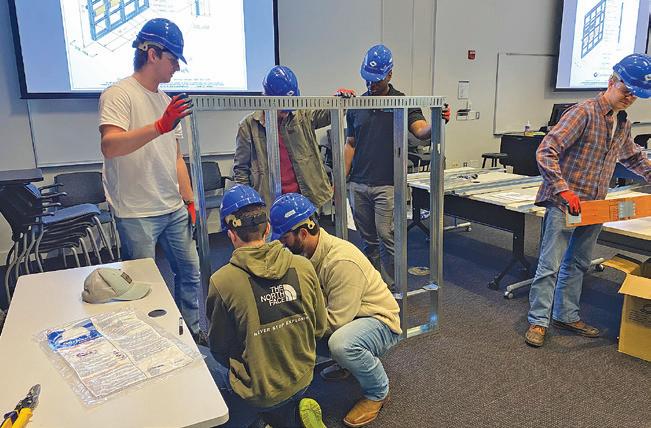
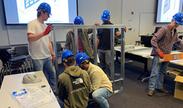

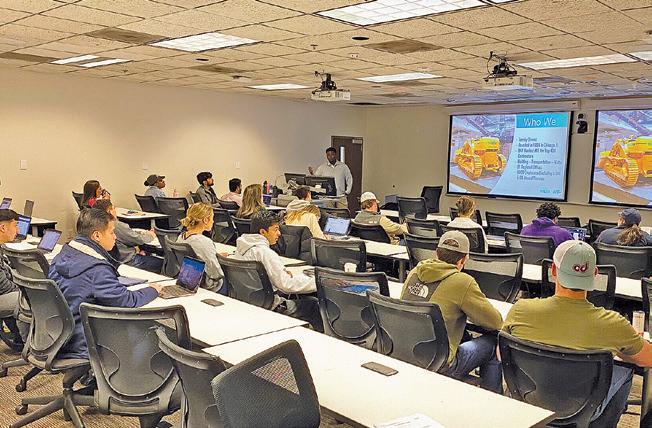
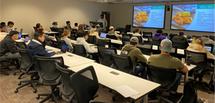

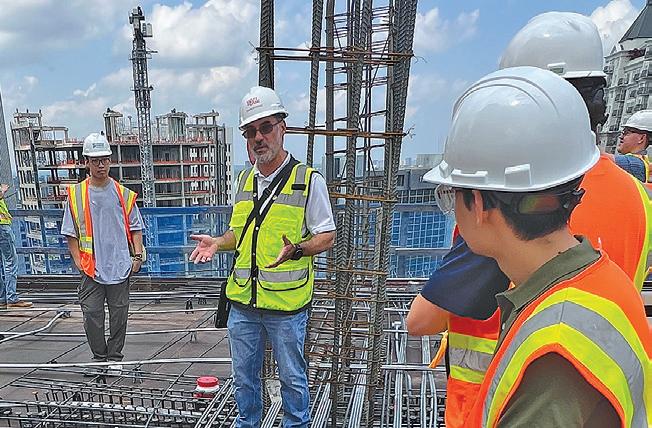
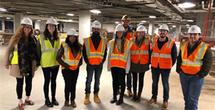

Partner Benefits
Partner Benefits
The program features a diverse set of activities that make it easy for organizations to engage with our students. Our tiered structure allows for companies of all sizes and civil disciplines to engage.
The program features a diverse set of activities that make it easy for organizations to engage with our students. Our tiered structure allows for companies of all sizes and civil disciples to engage.
White Tier -
$5,000
White Tier - $5,000
·Free registration to CEE’s Fall Career Expo
·Access to student resumes
Free registration to CEE’s Fall Career Expo
·Invitation to present in a class
Access to student resumes
· Invitation to present in a class
·Host Day-in-the-Lobby events twice a year
· Host Day-in-the-Lobby events twice a year
·Host company information sessions twice a year
· Host company information sessions twice a year
·Facilitate a skills-based or career workshop
· Facility a skills-based or career workshop
·Participation in GOLD Mentoring Program
·Specialized postings for jobs and internships
· Participation in GOLD Mentoring Program
·Company information listed on CEE website
· Specialized postings for jobs and internships
·Join school sponsored events with students, and faculty
· Company information listed on CEE website
·Participate in Day-in-the-Office program
Join school sponsored events with students, and faculty
Participate in Day-in-the-Office program
Gold Tier-$10,000
Gold Tier-$10,000
All benefits included in White Tier plus:
·Contribution to CAP undergraduate student scholarship
All benefits included in White Tier plus:
·Annual updates on scholarship recipient
· Contribution to CAP undergraduate student scholarship
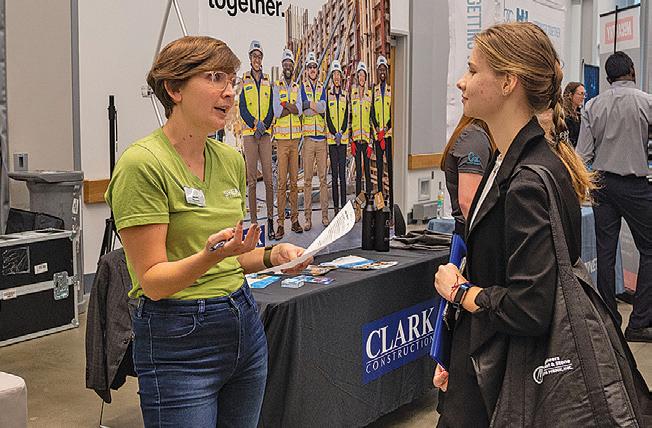
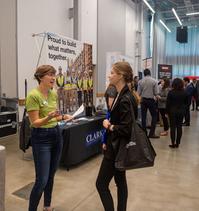

·Invitation to scholarship luncheon to meet scholarship recipient
· Annual updates on scholarship recipient
·Annual 1:1 meeting with School Chair
· Invitation to scholarship luncheon to meet scholarship recipient
Annual 1:1 meeting with School Chair
·Invitation to CEE’s Annual Alumni Homecoming Tailgate
·Invitation to sponsor an alumni event
Invitation to CEE’s Annual Alumni Homecoming Tailgate
· Invitation to sponsor an alumni event
Interested in joining our Corporate Affiliates Program? Visit

